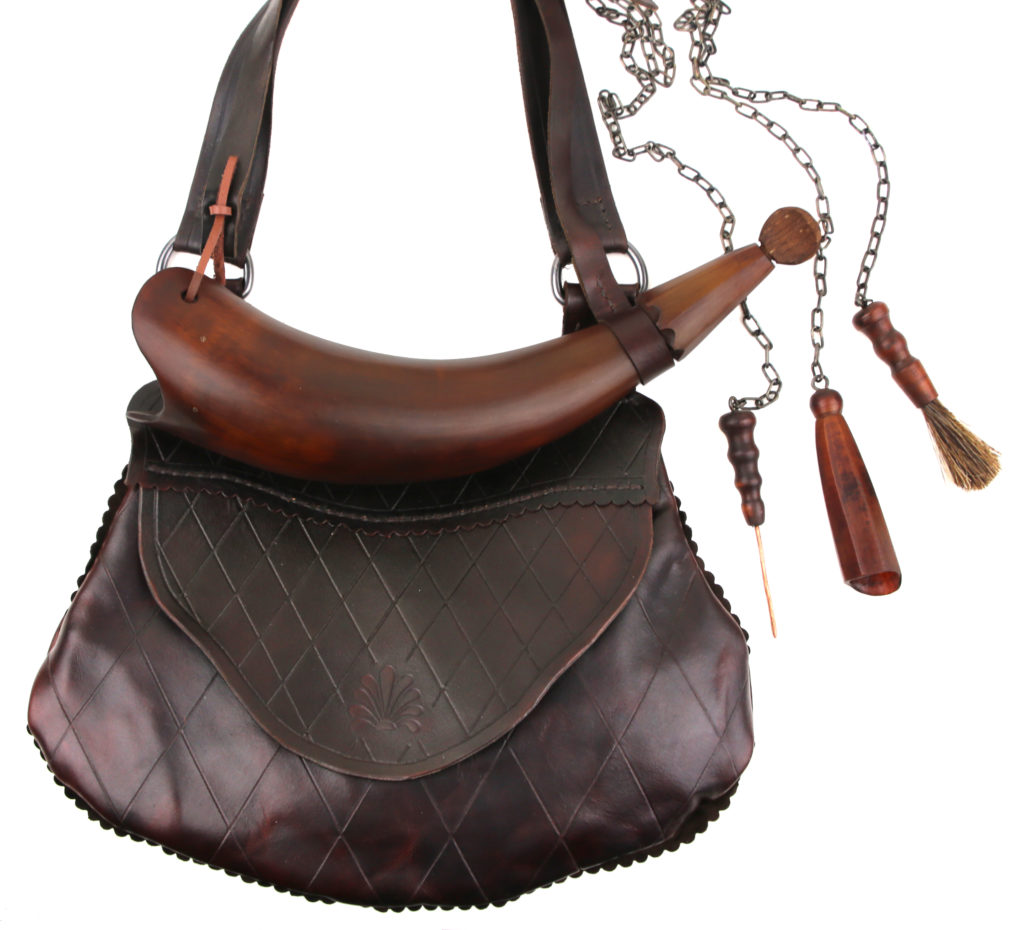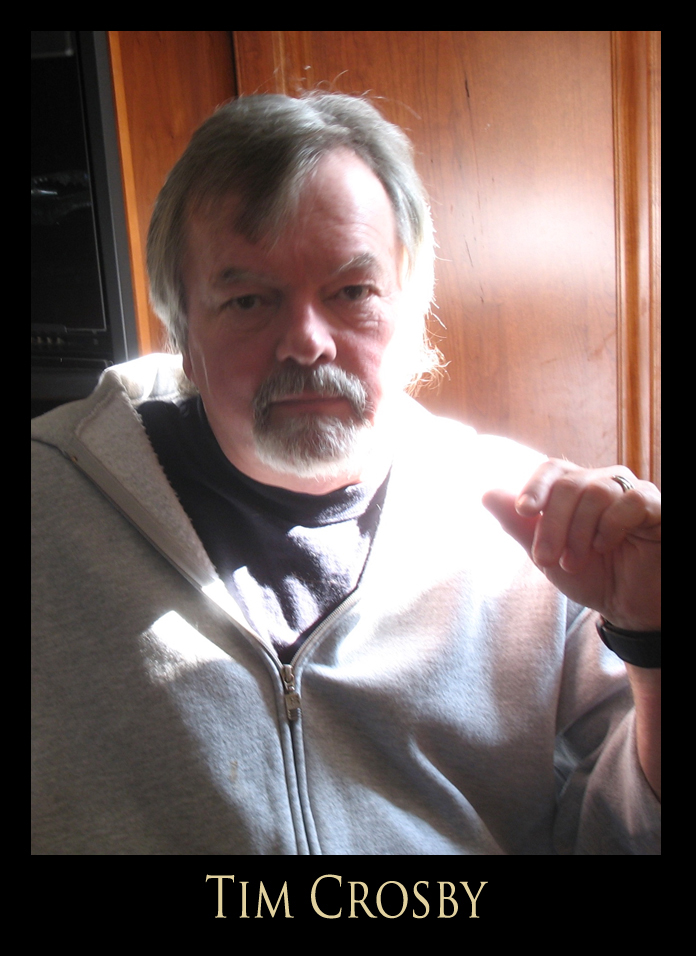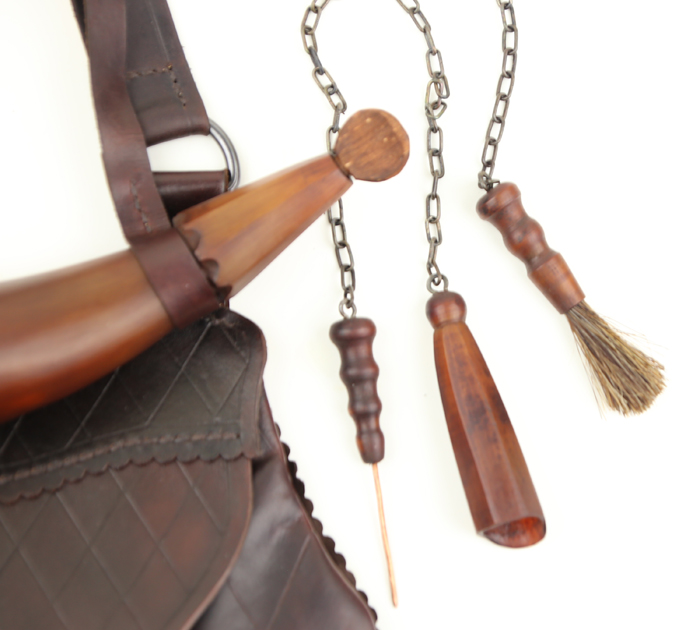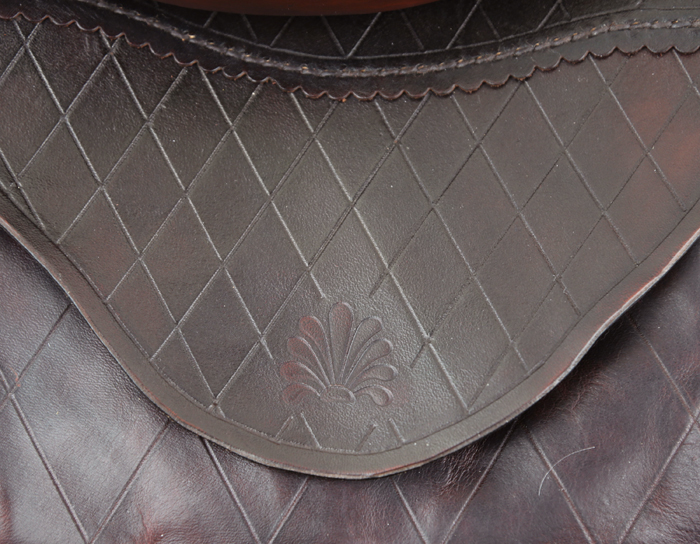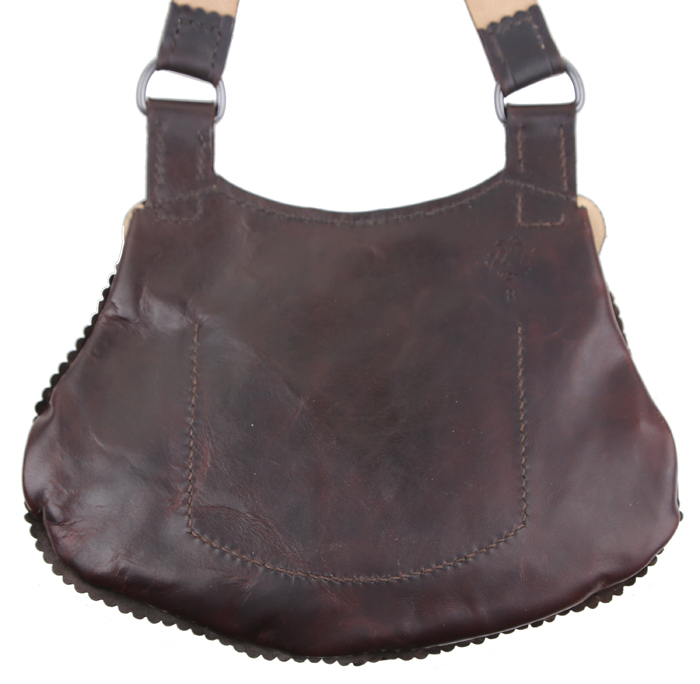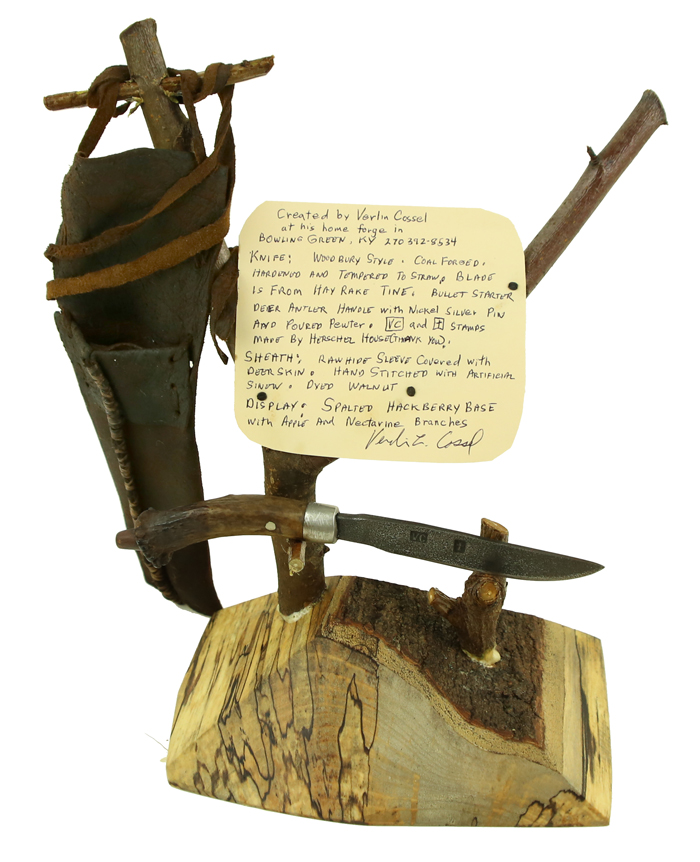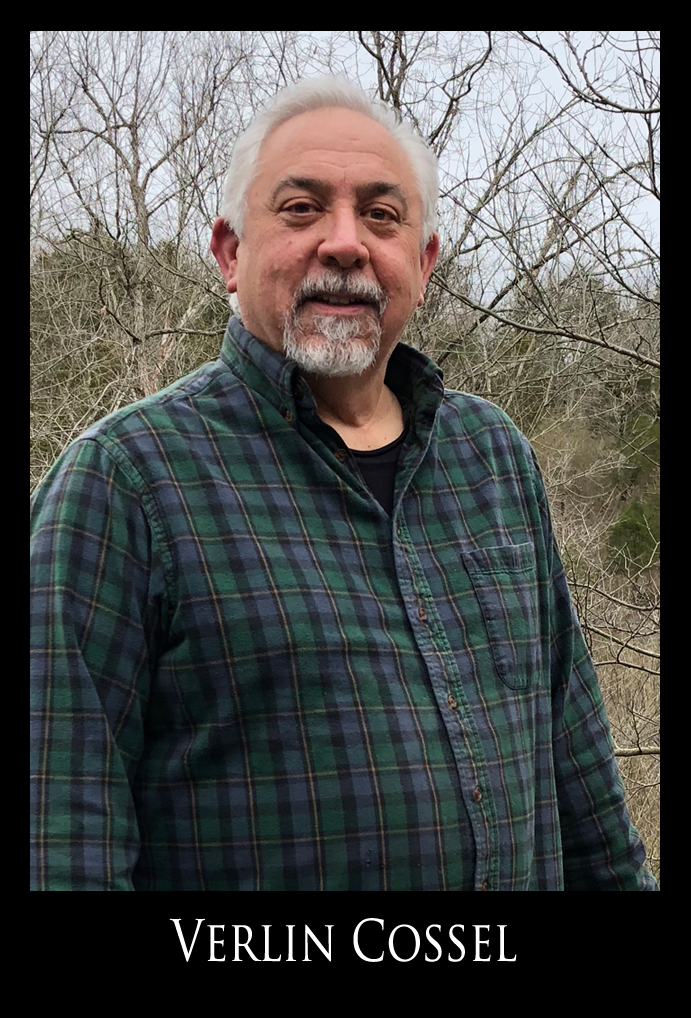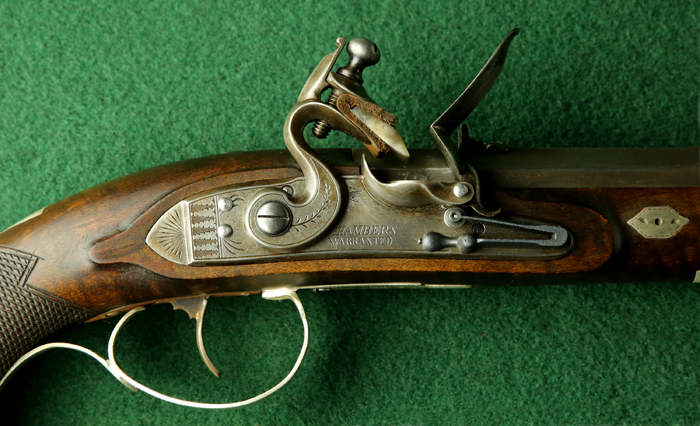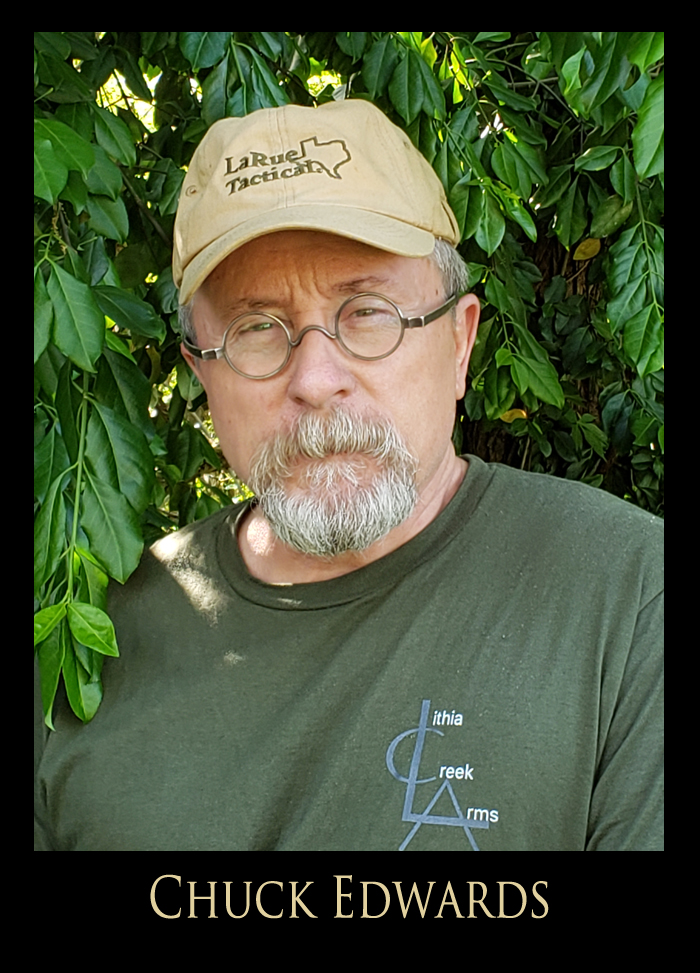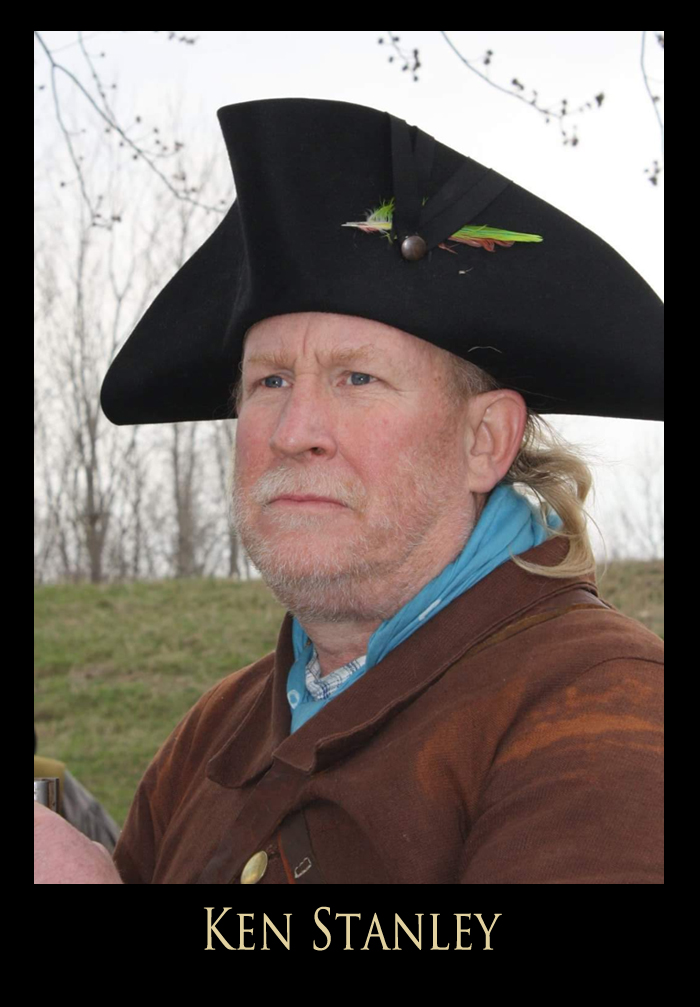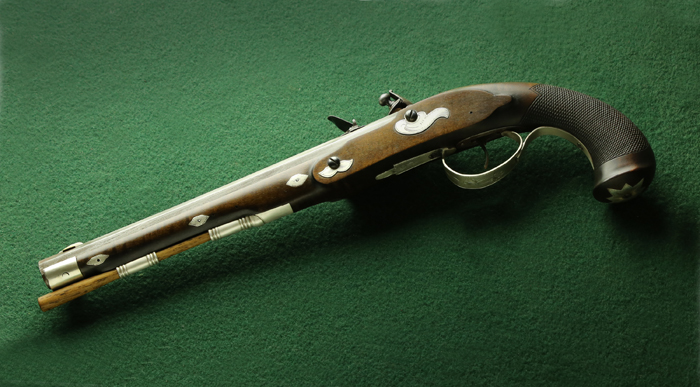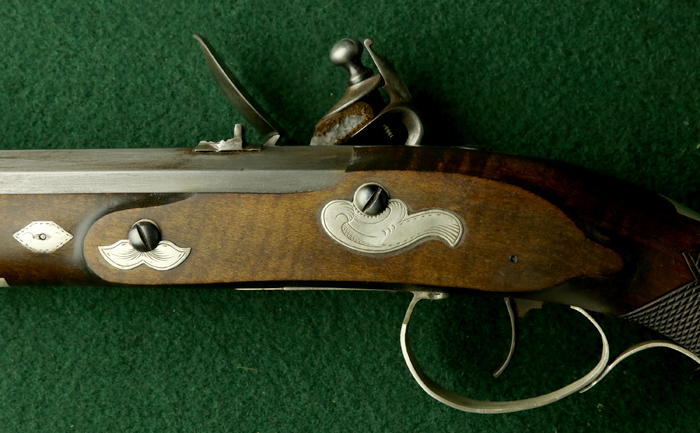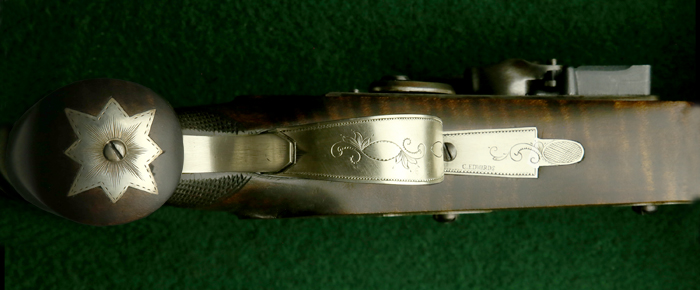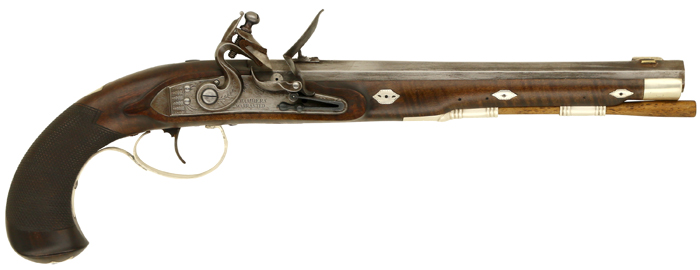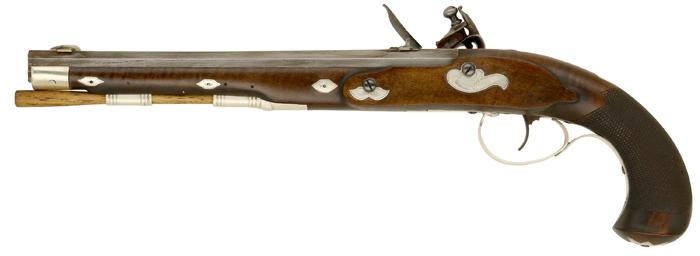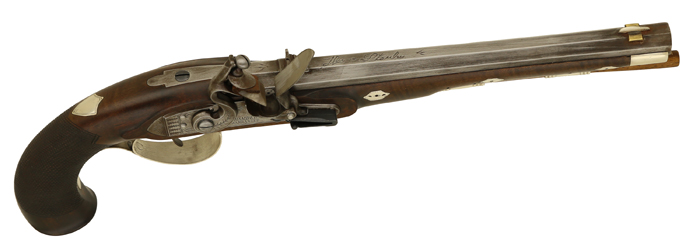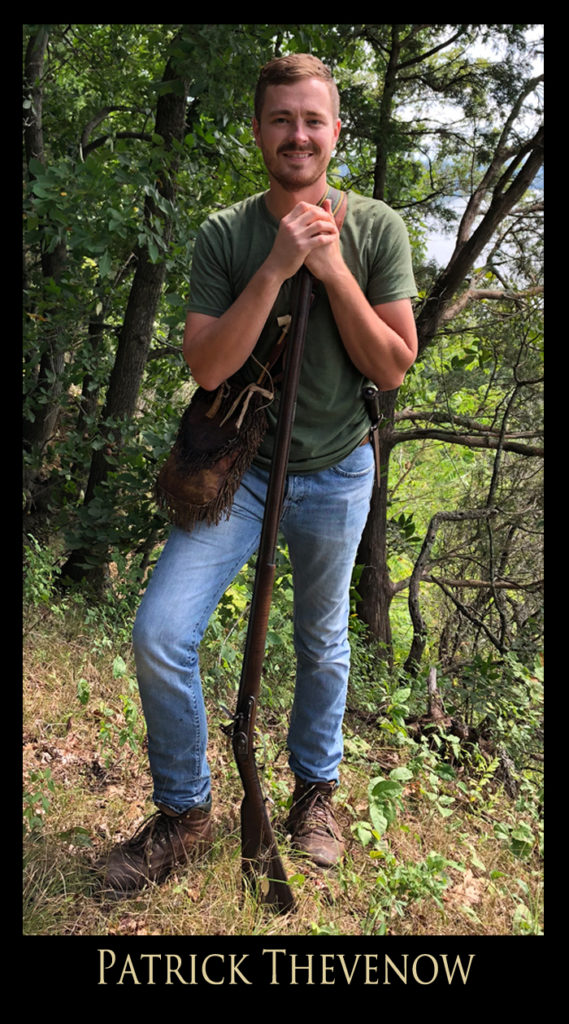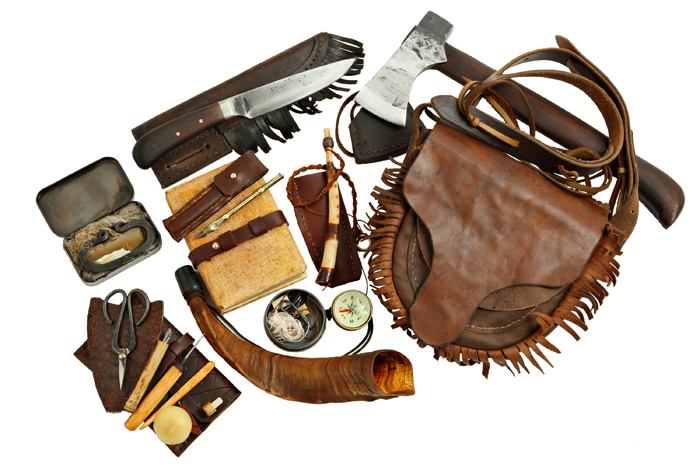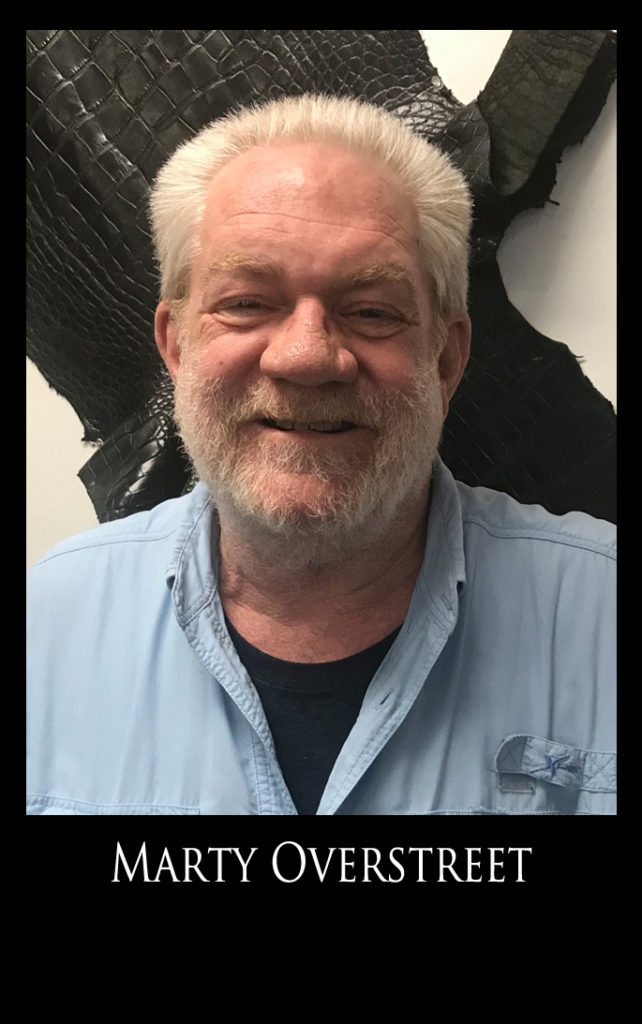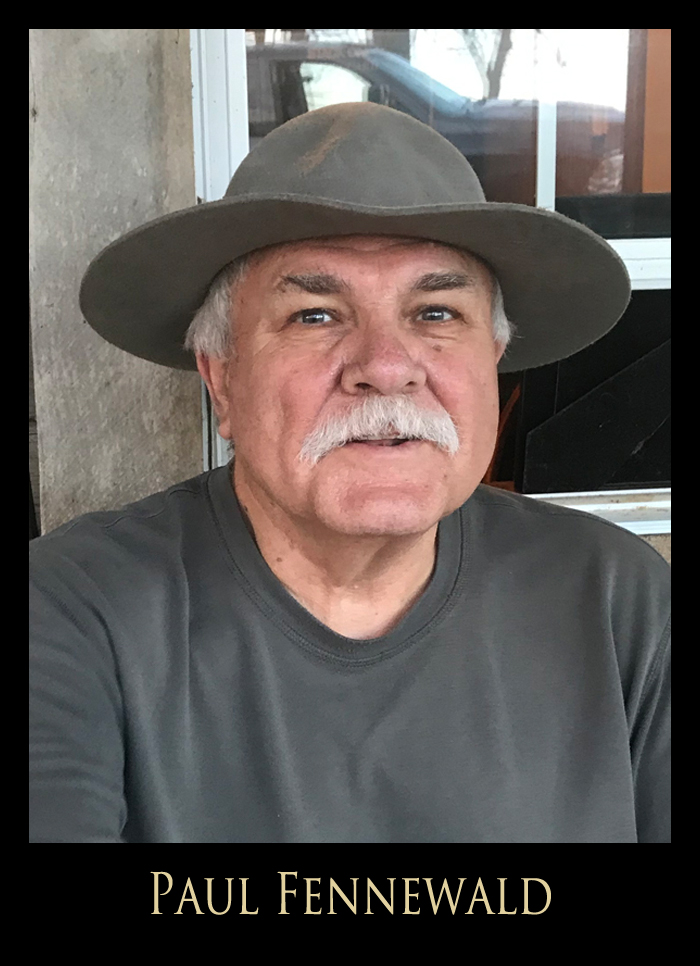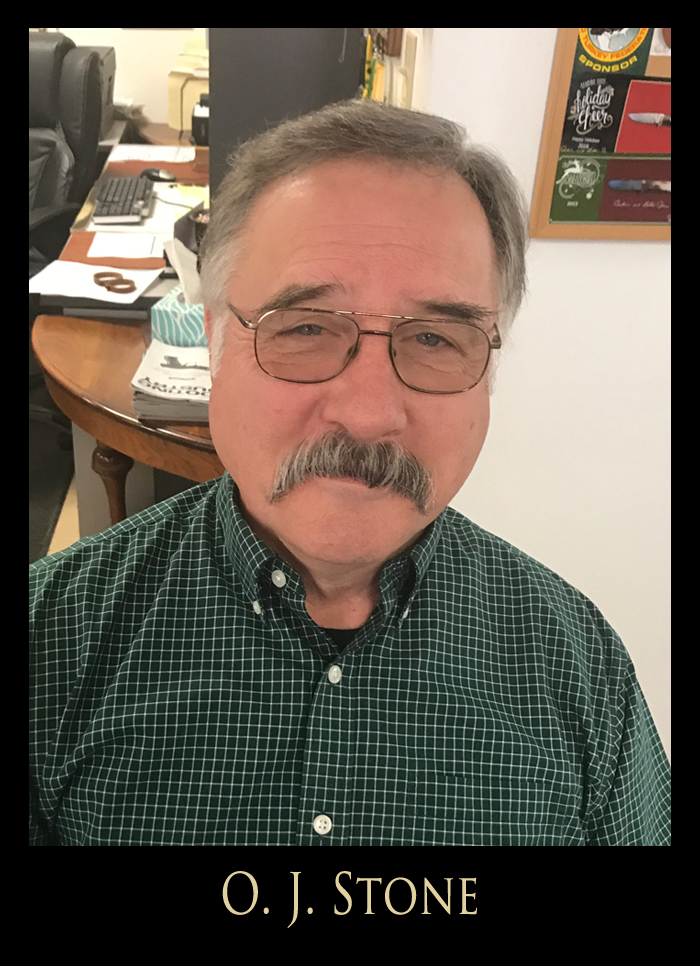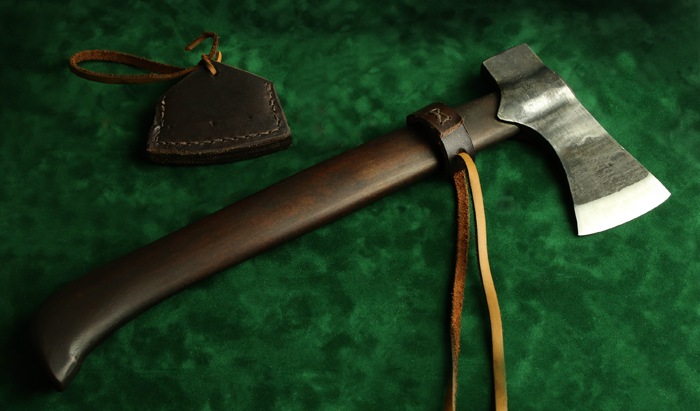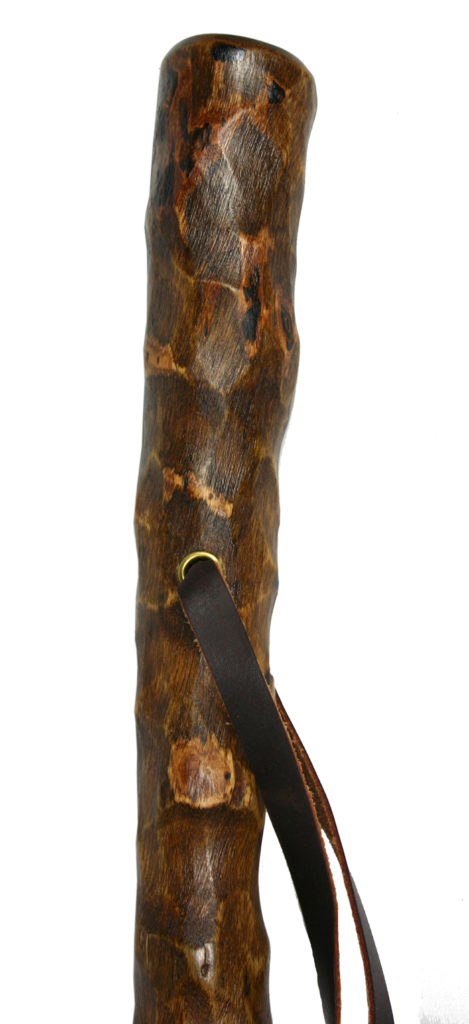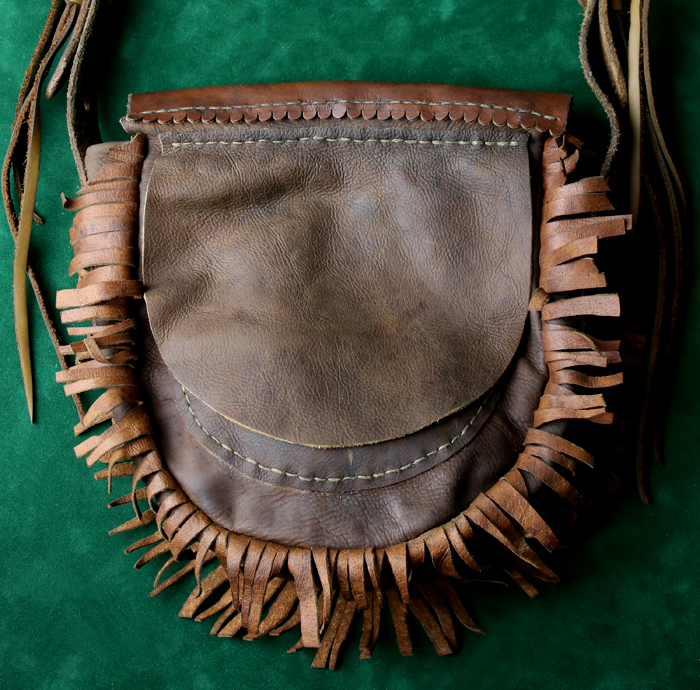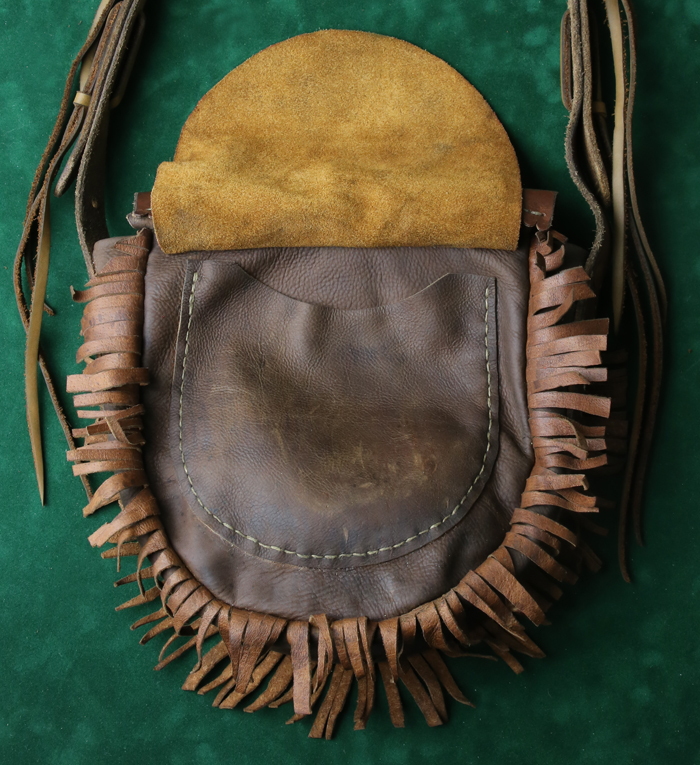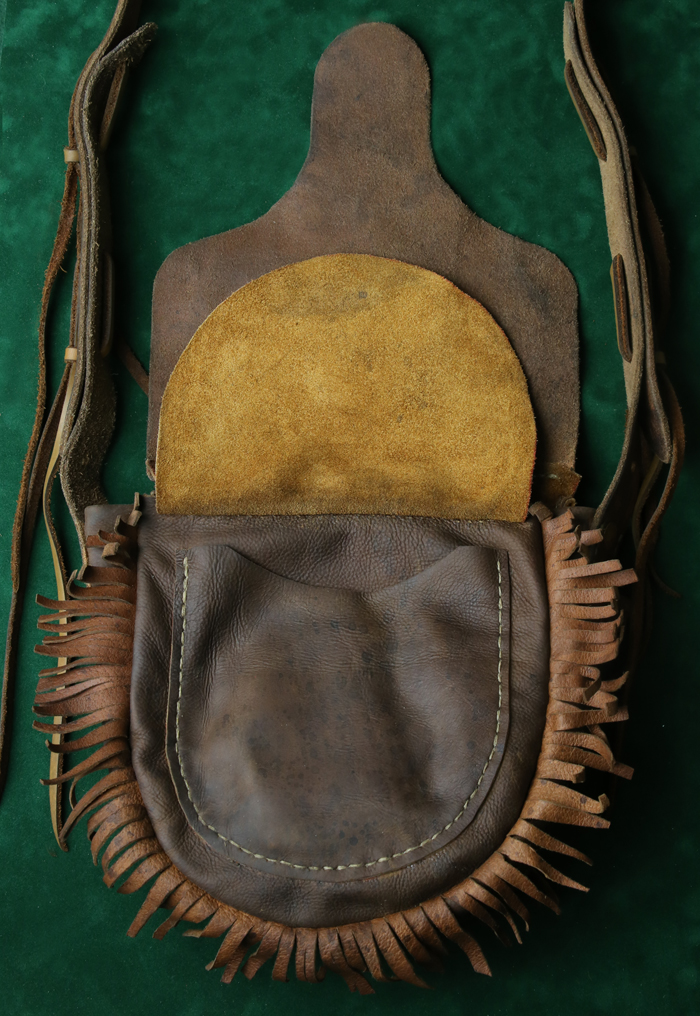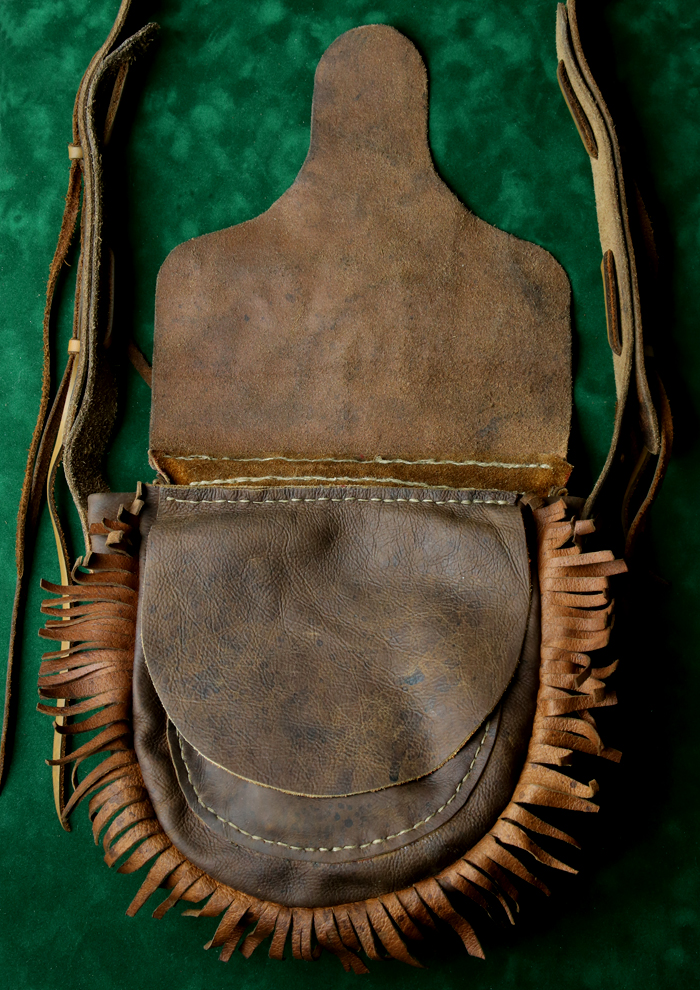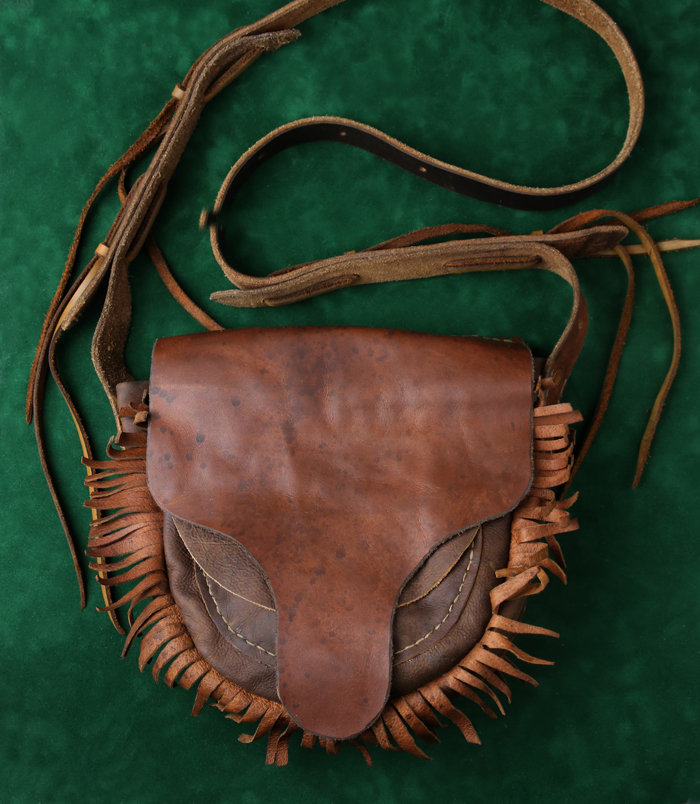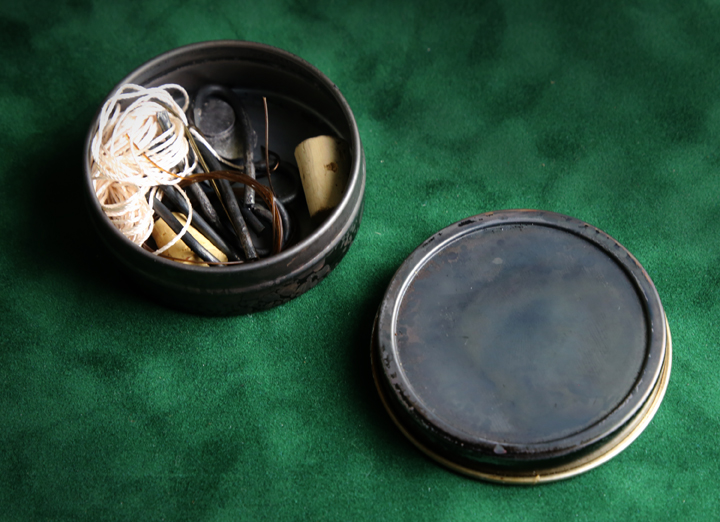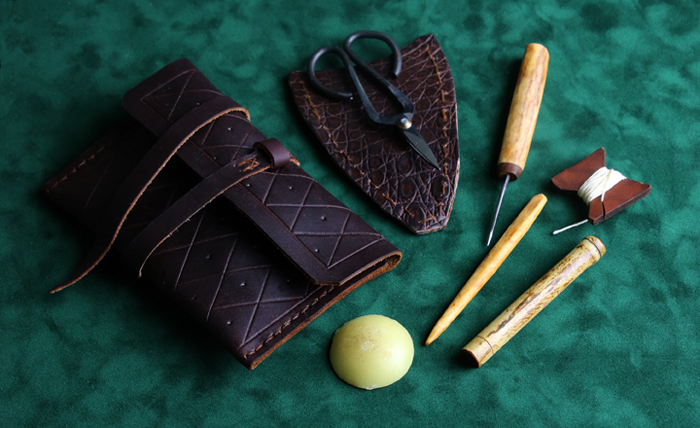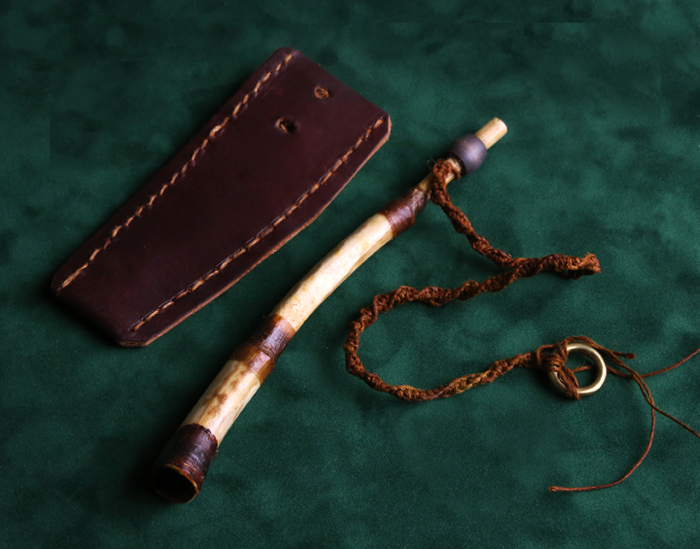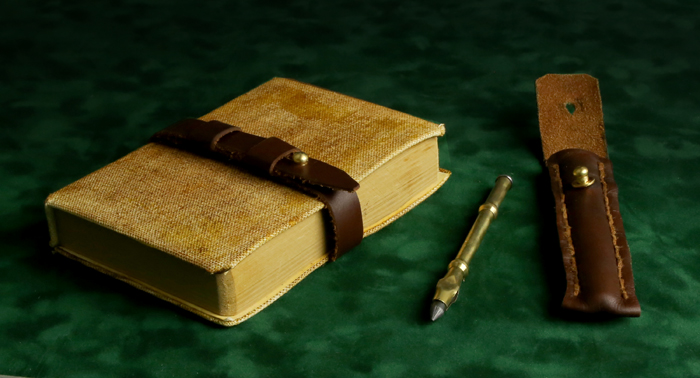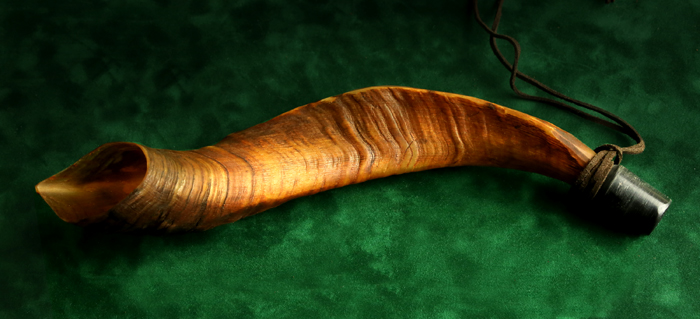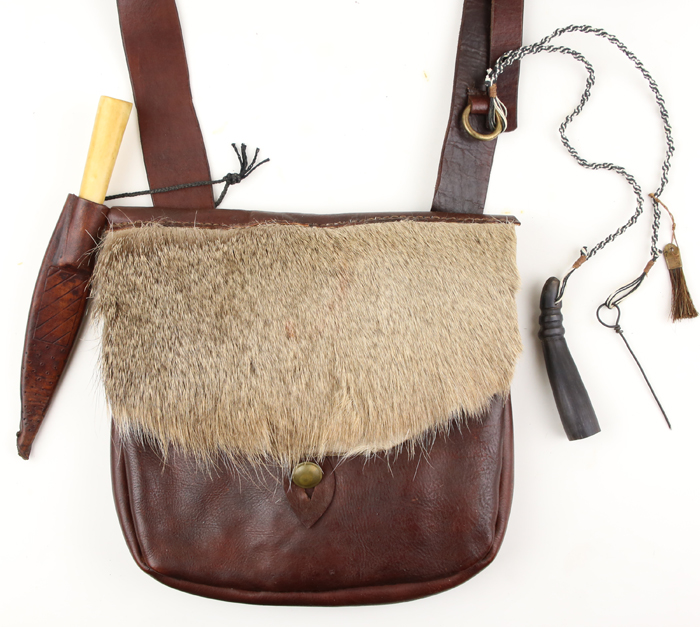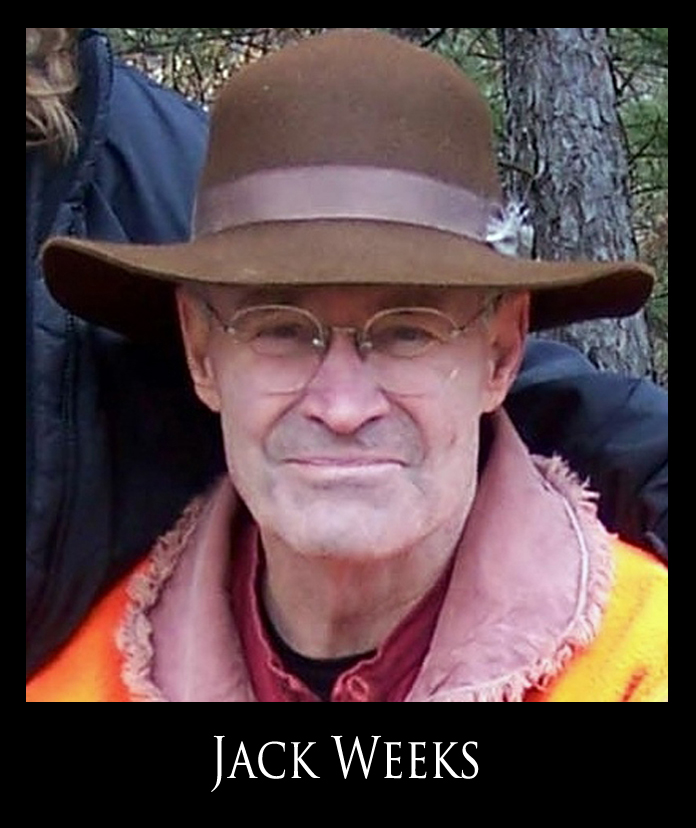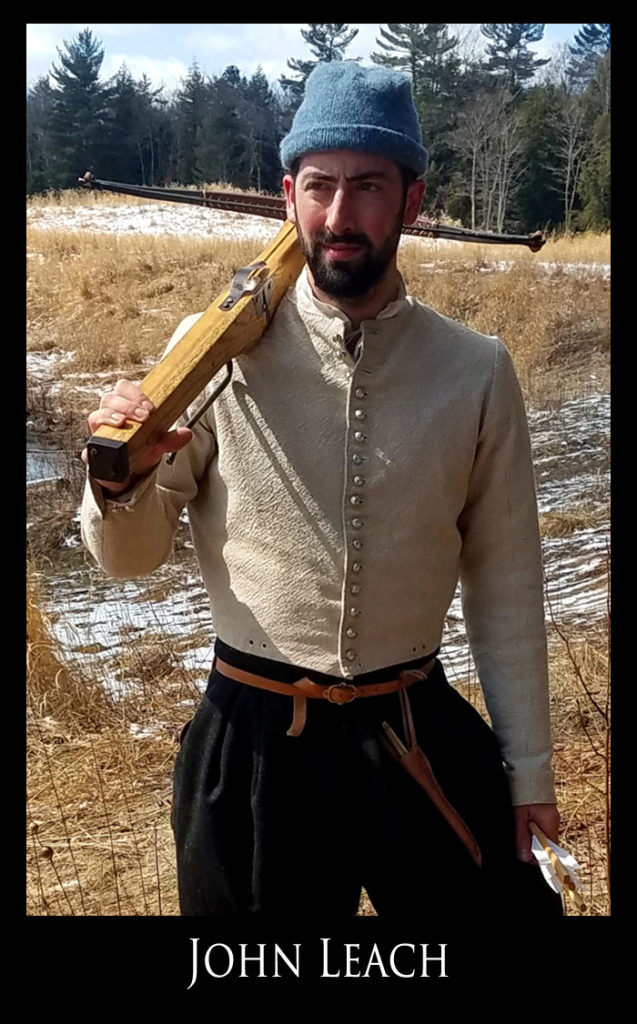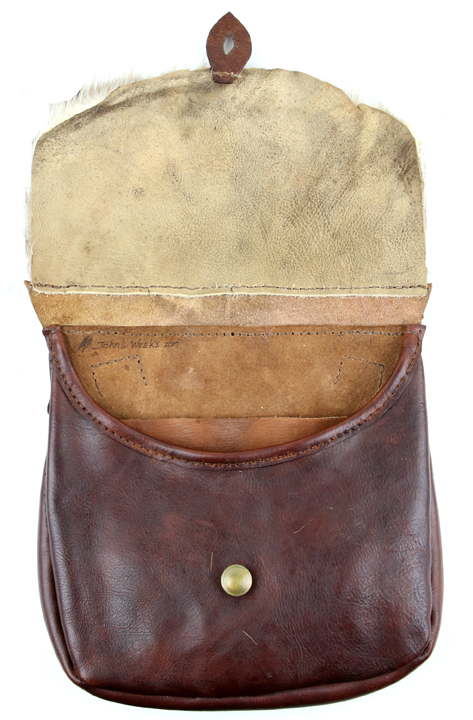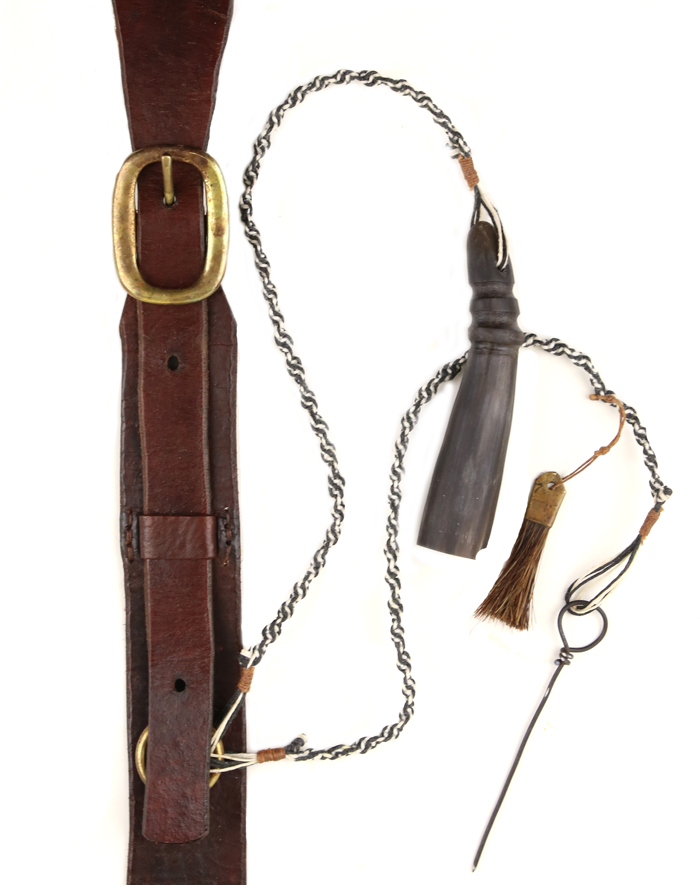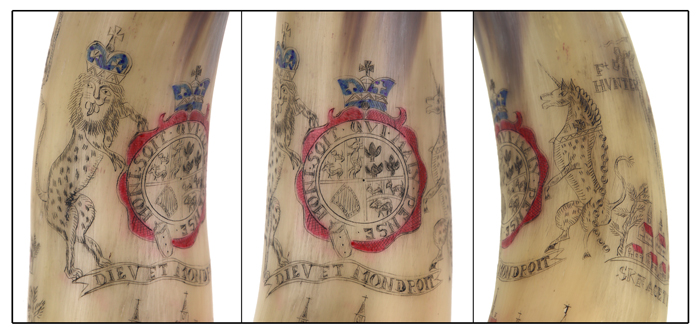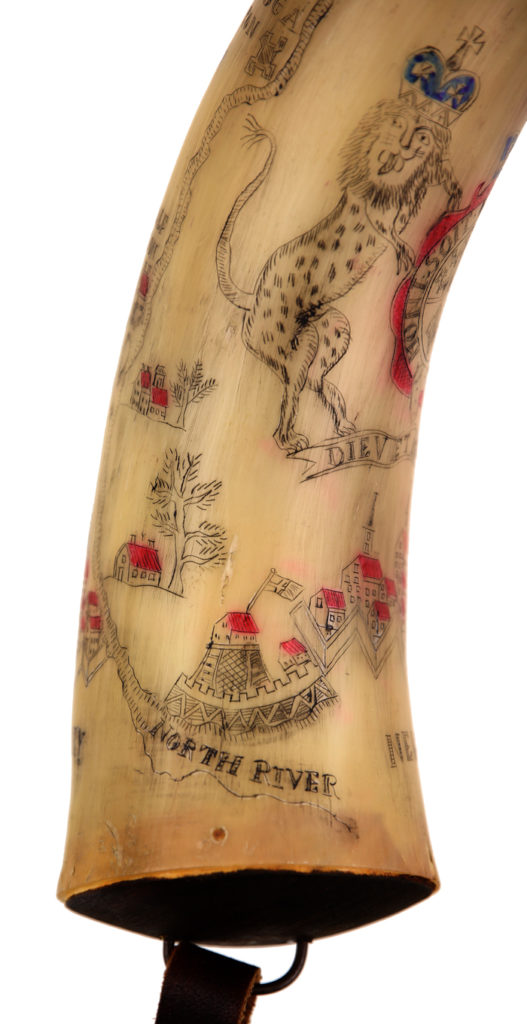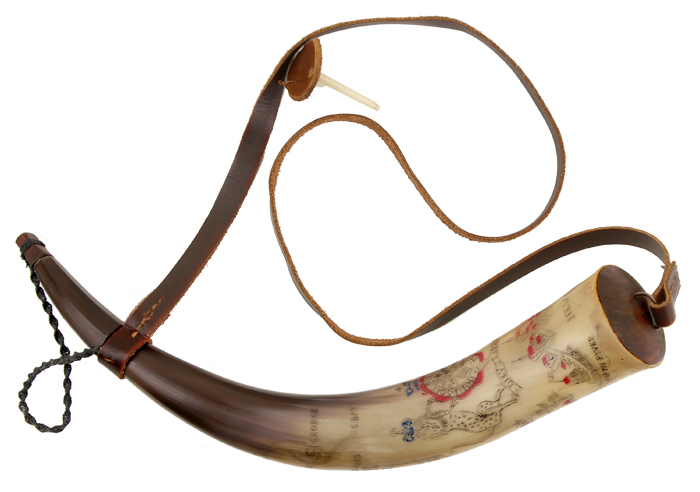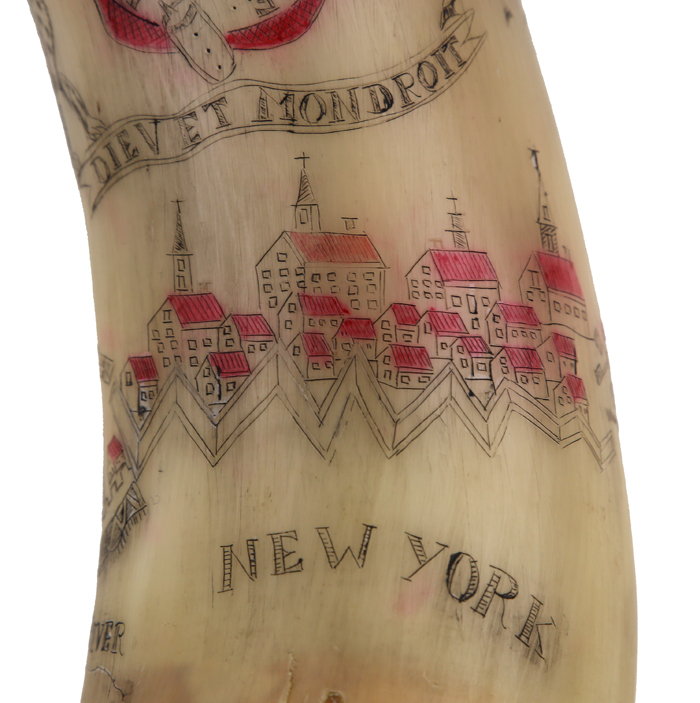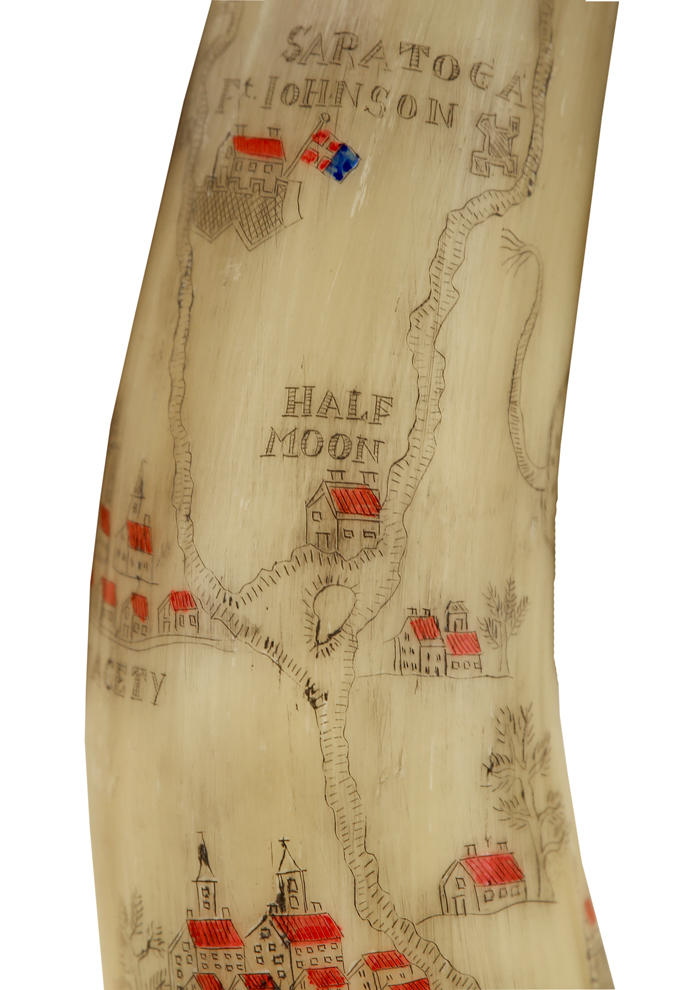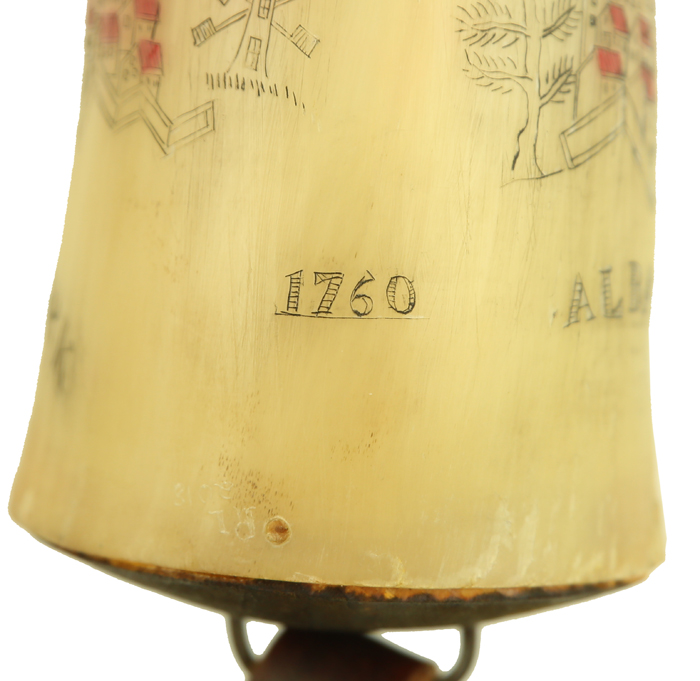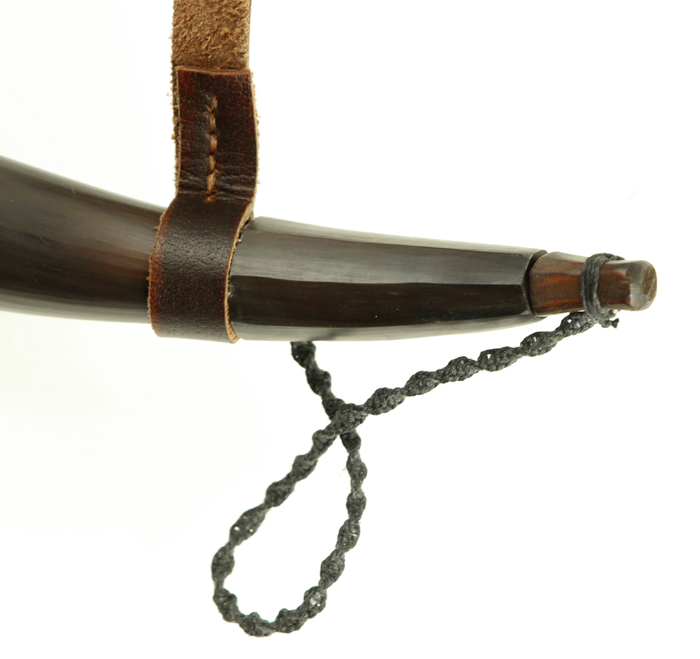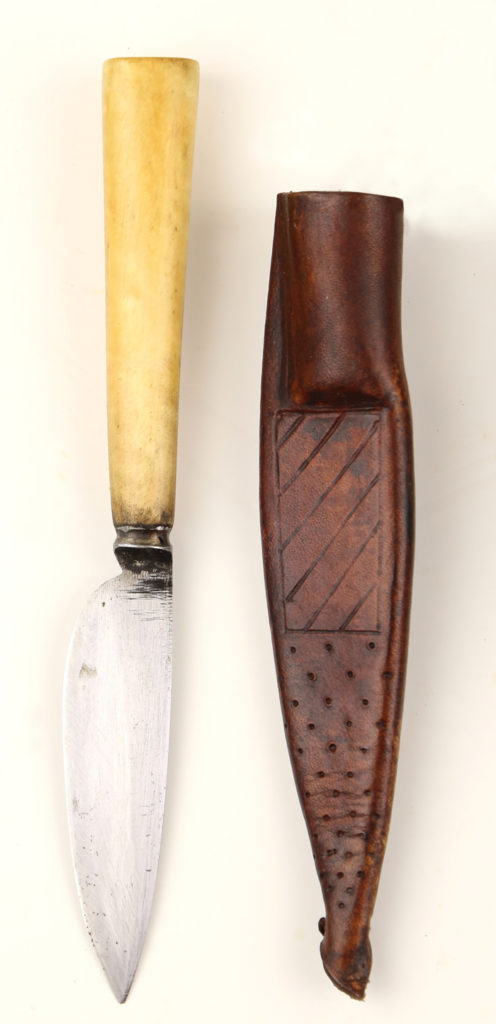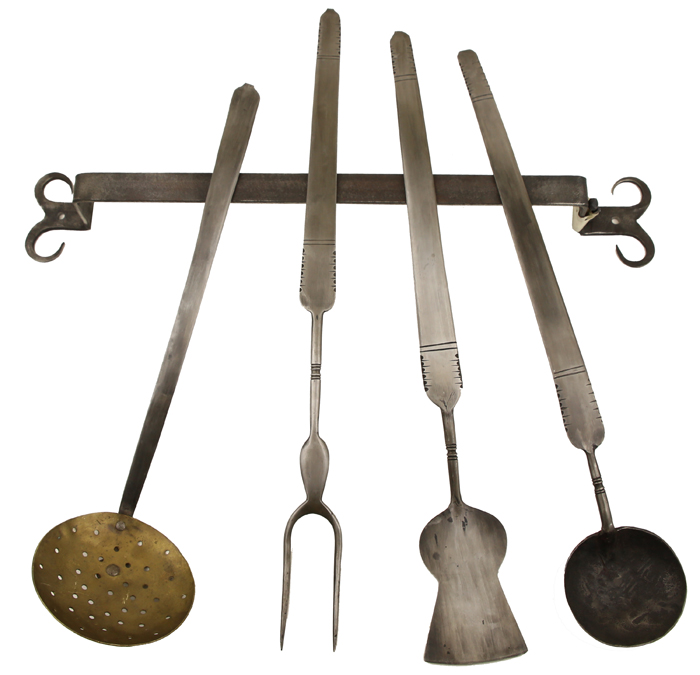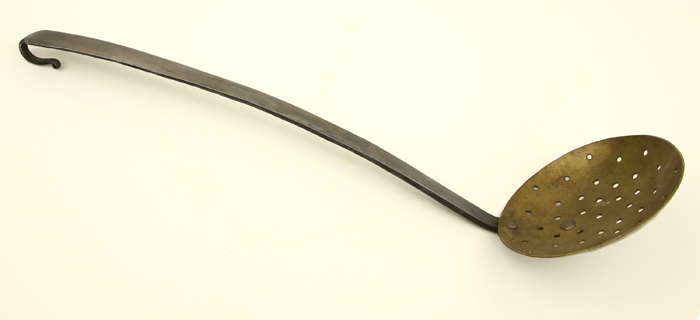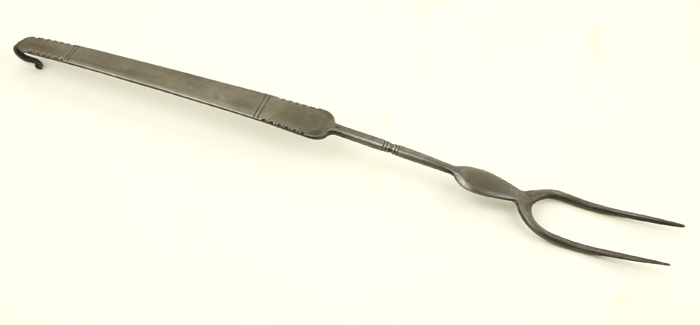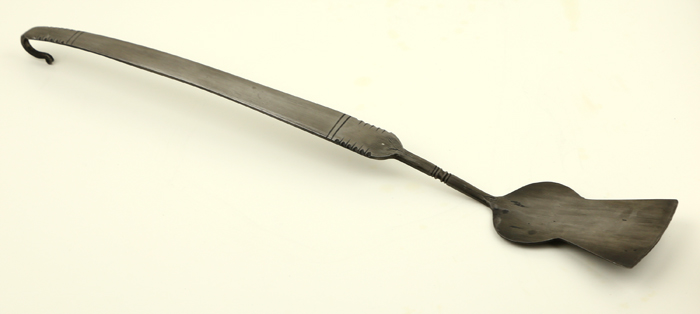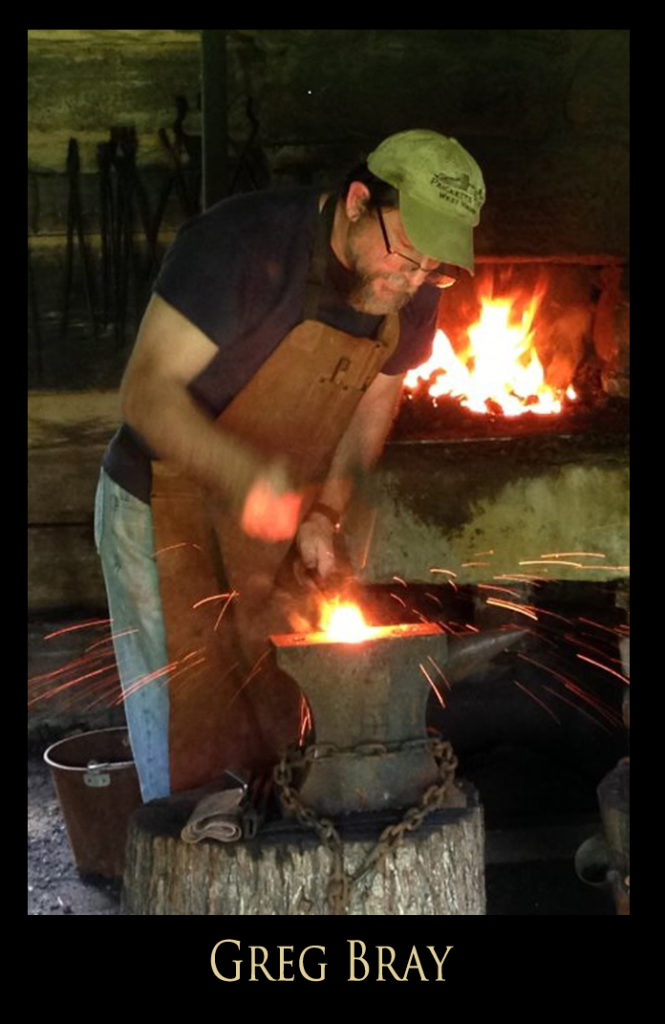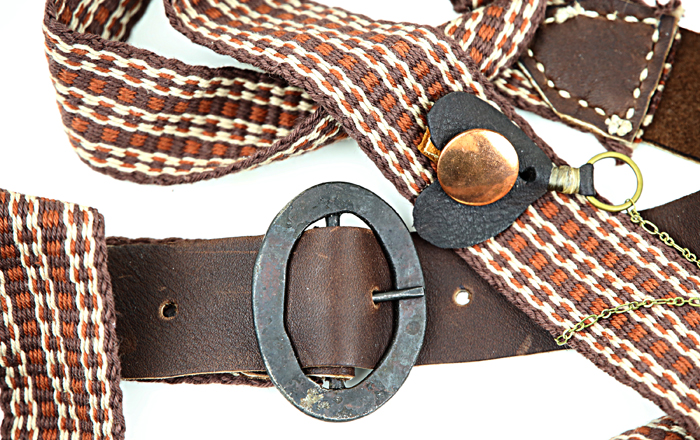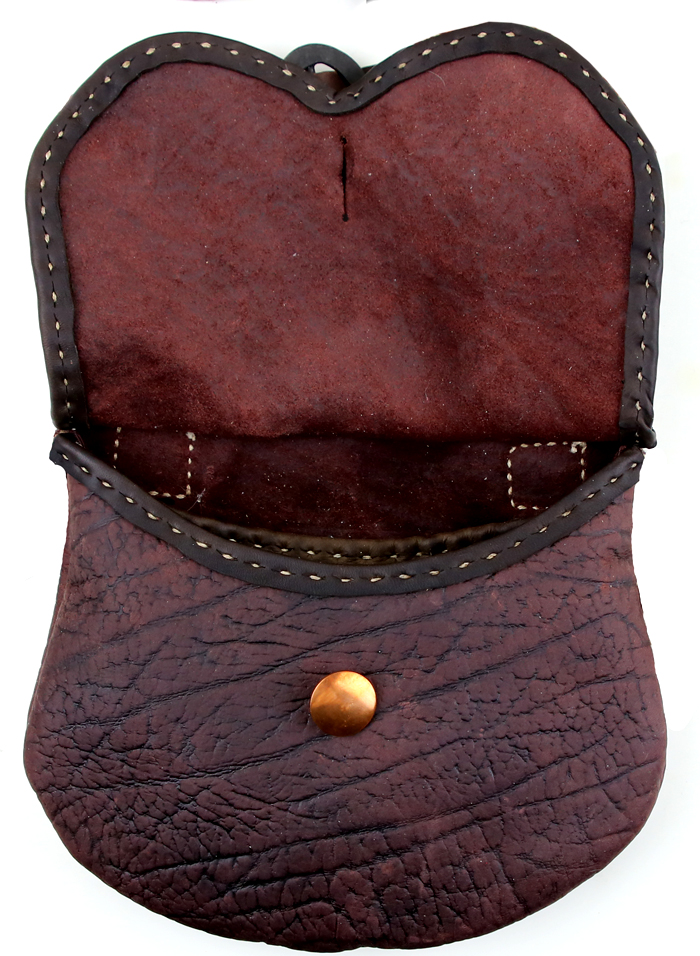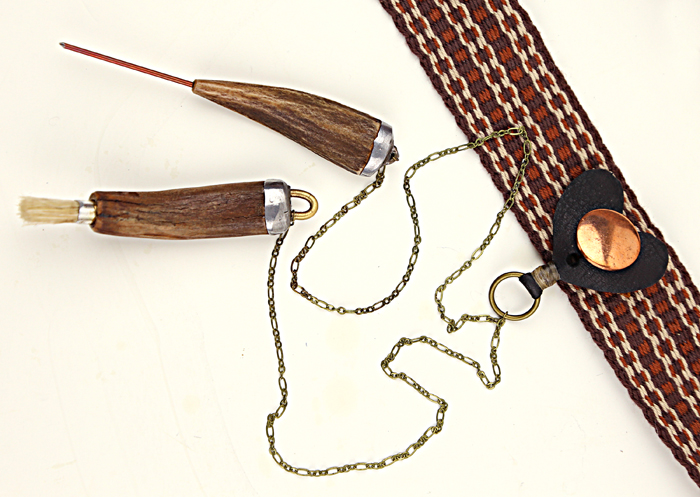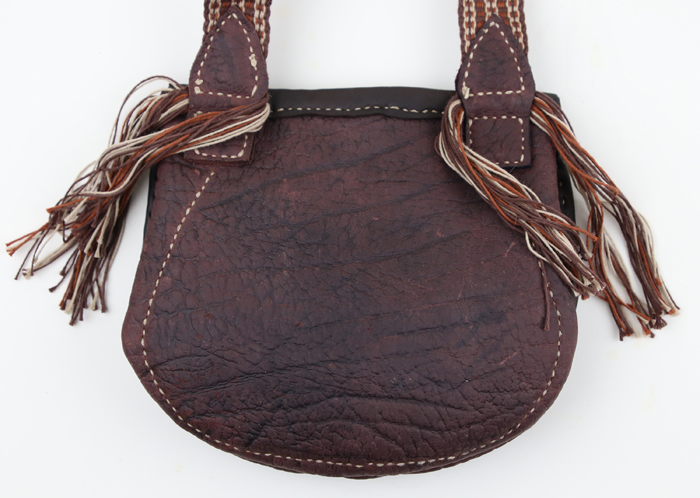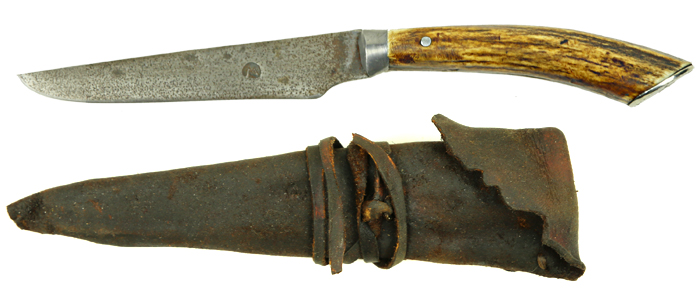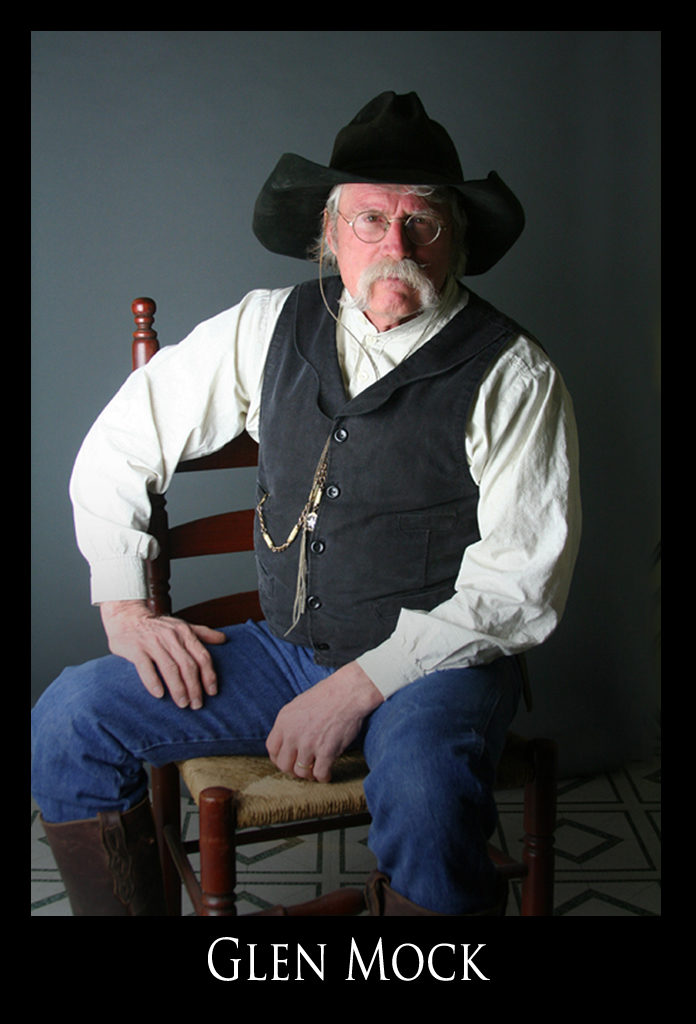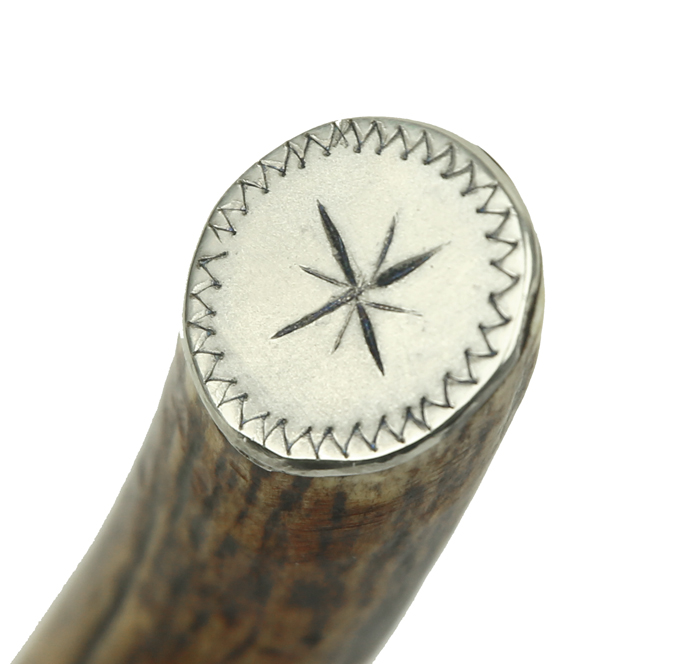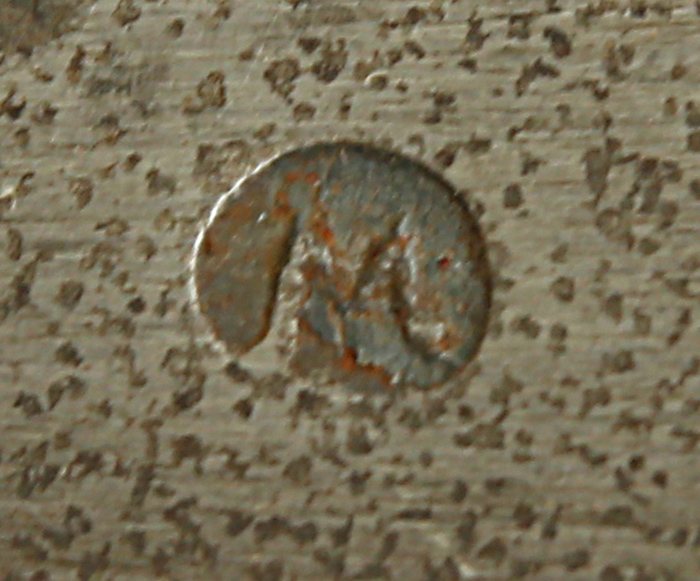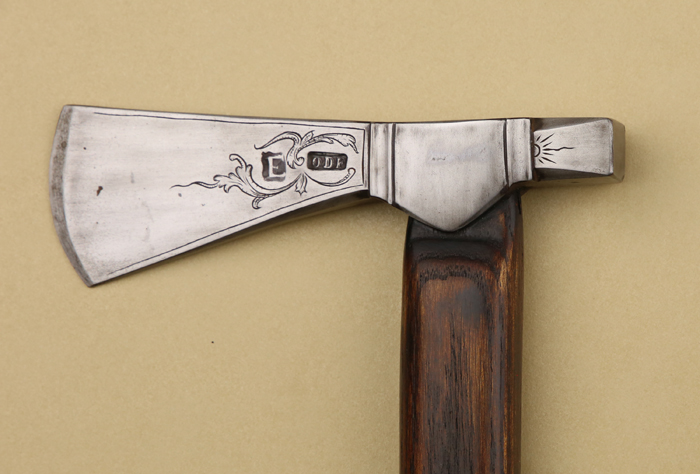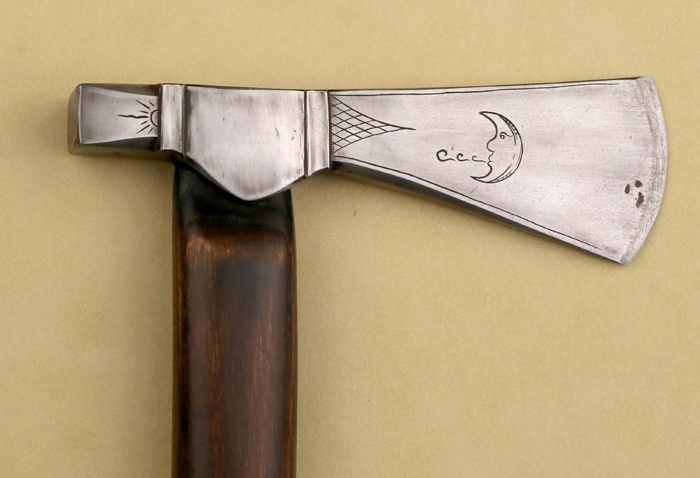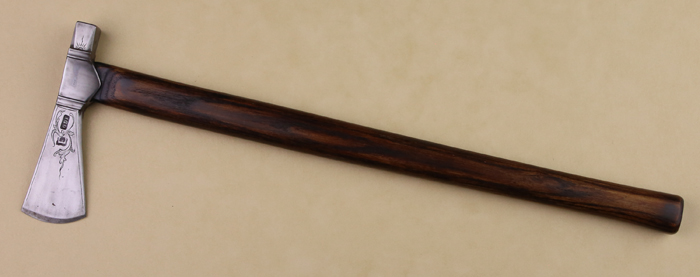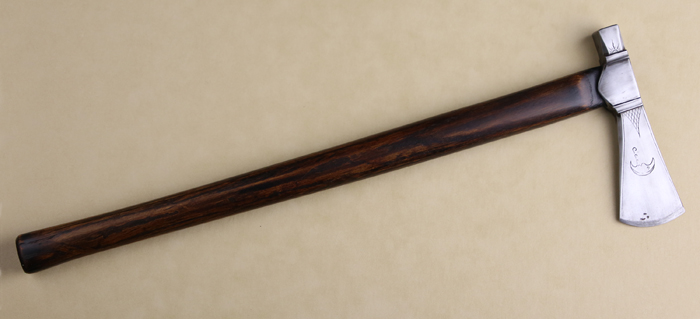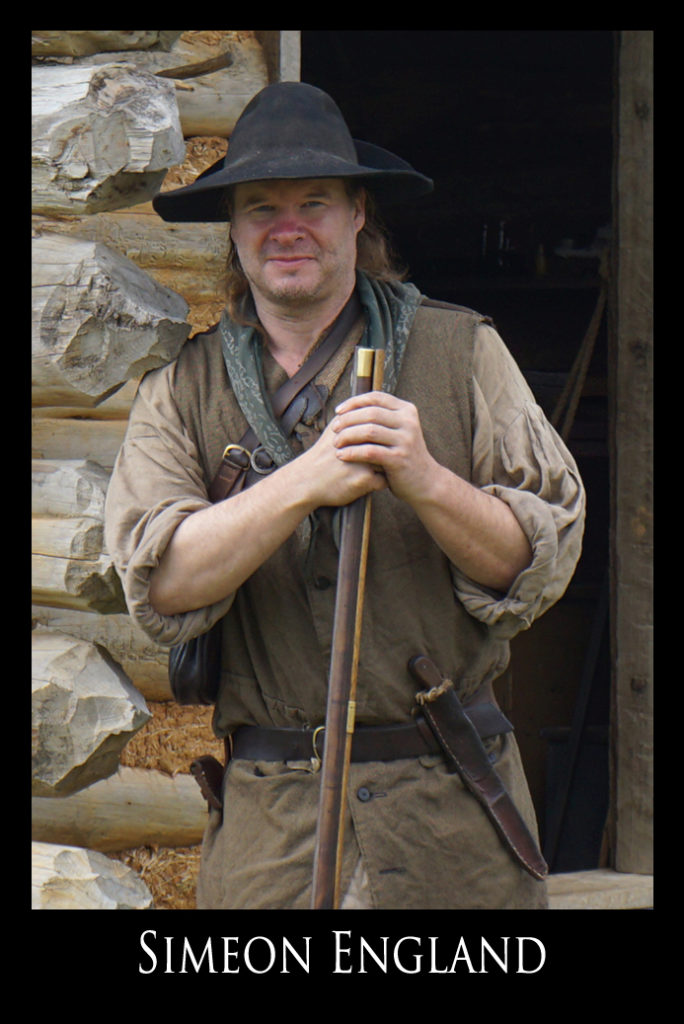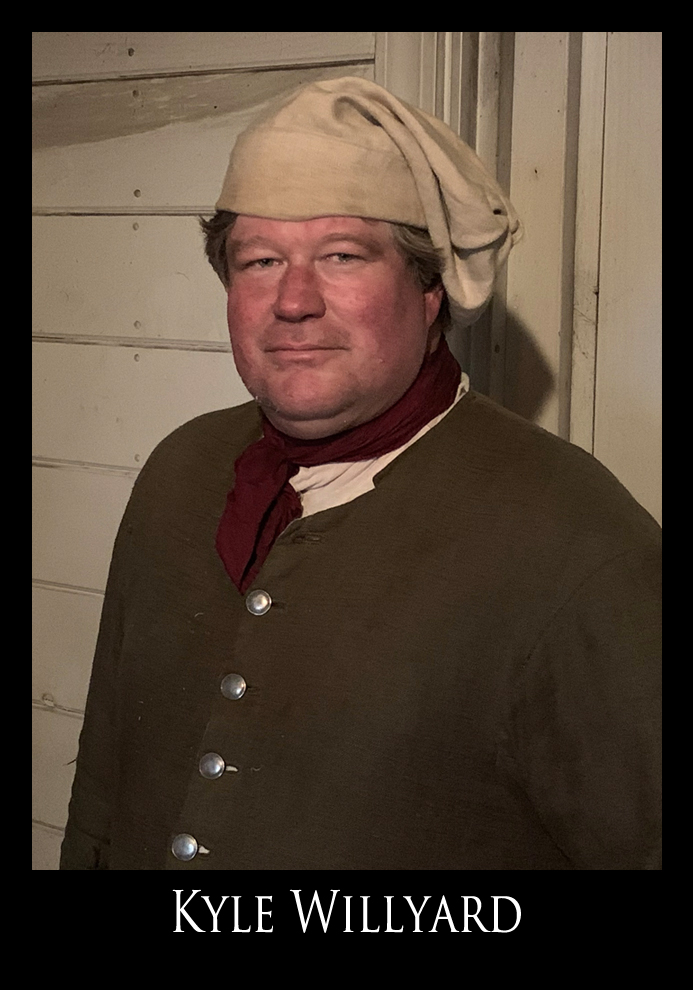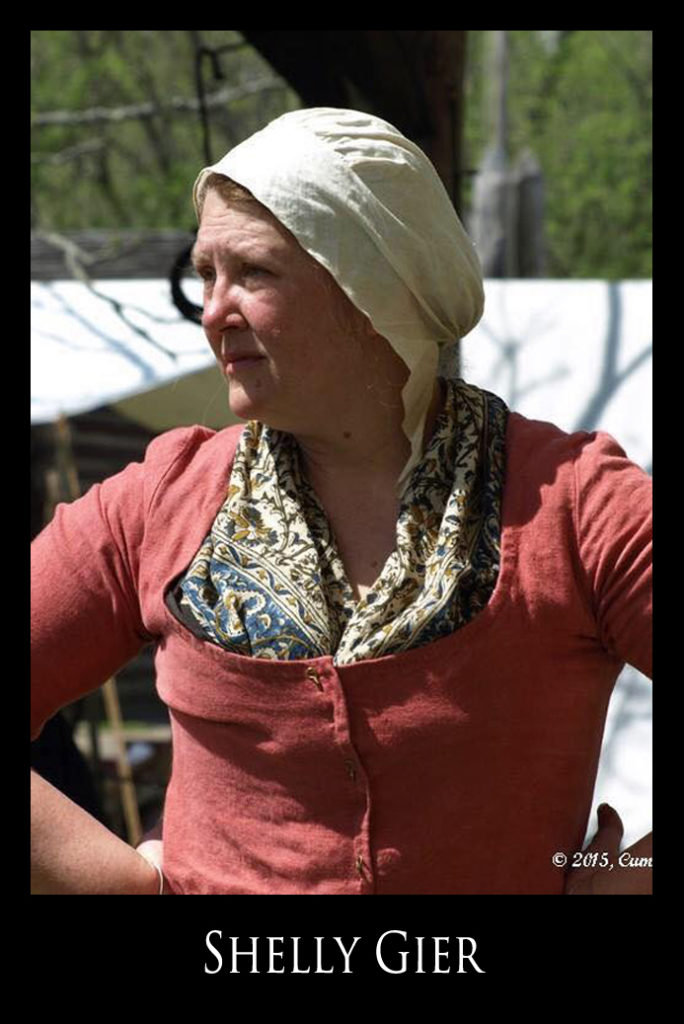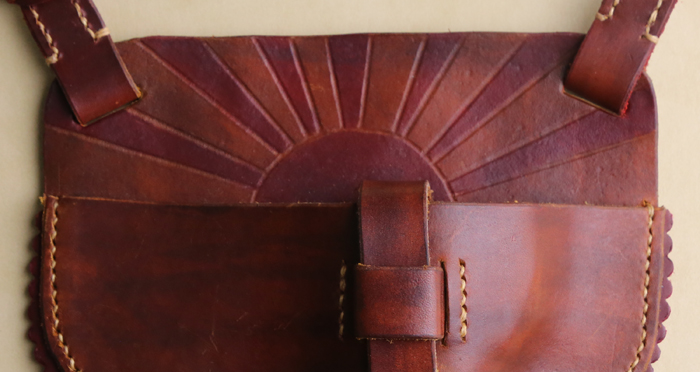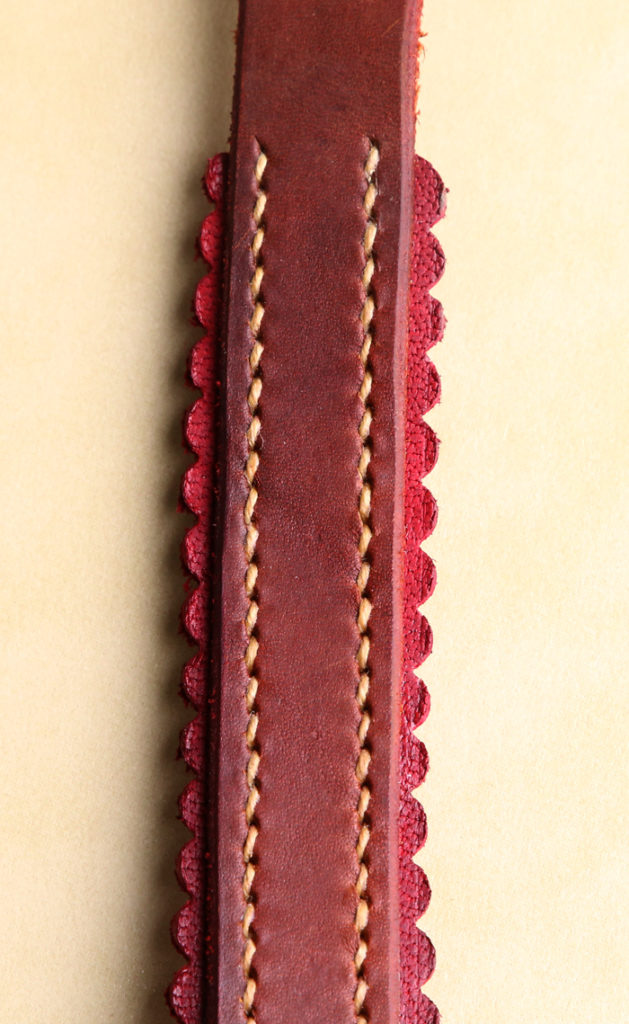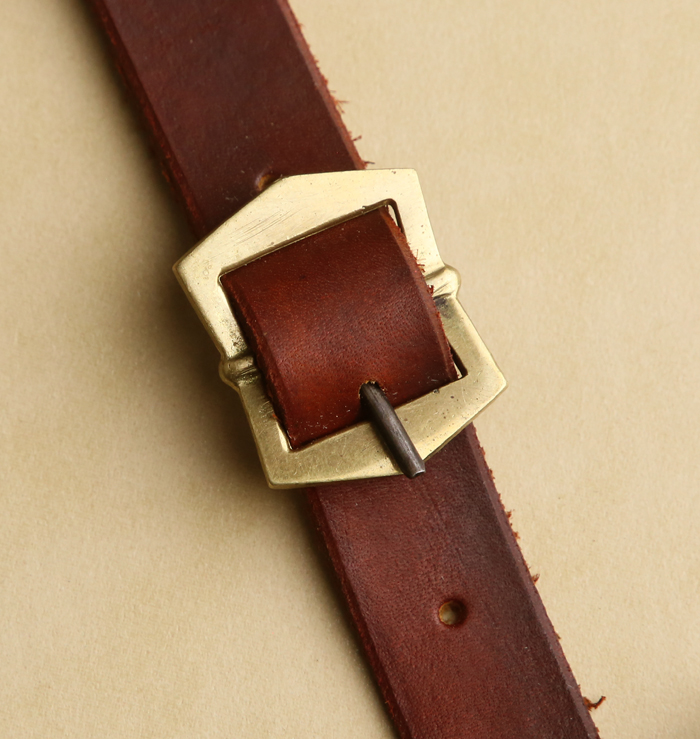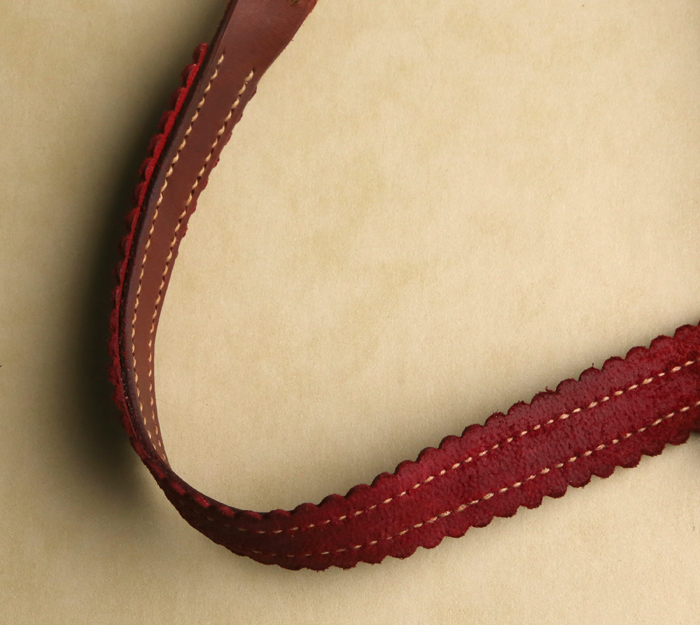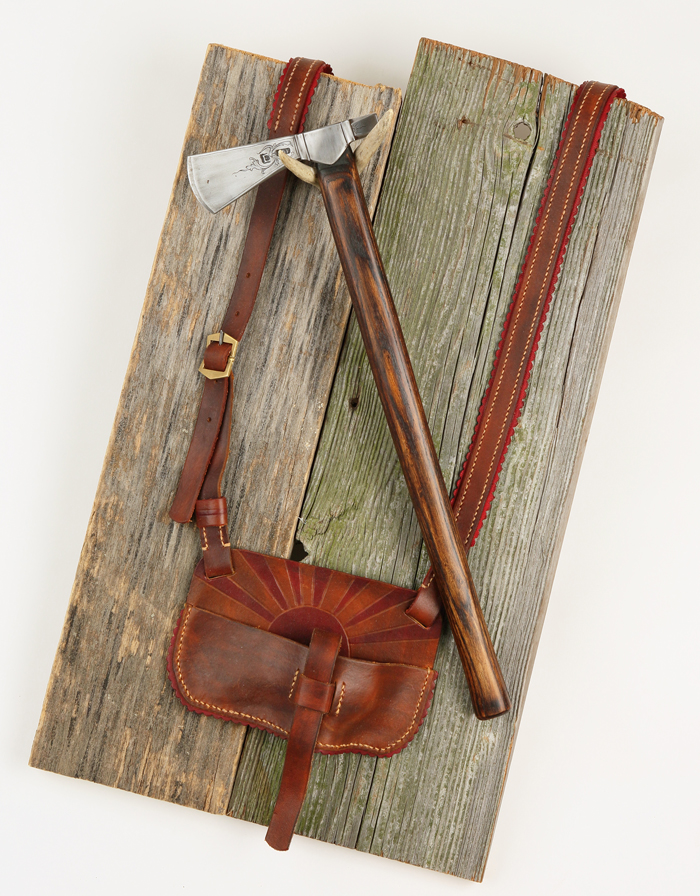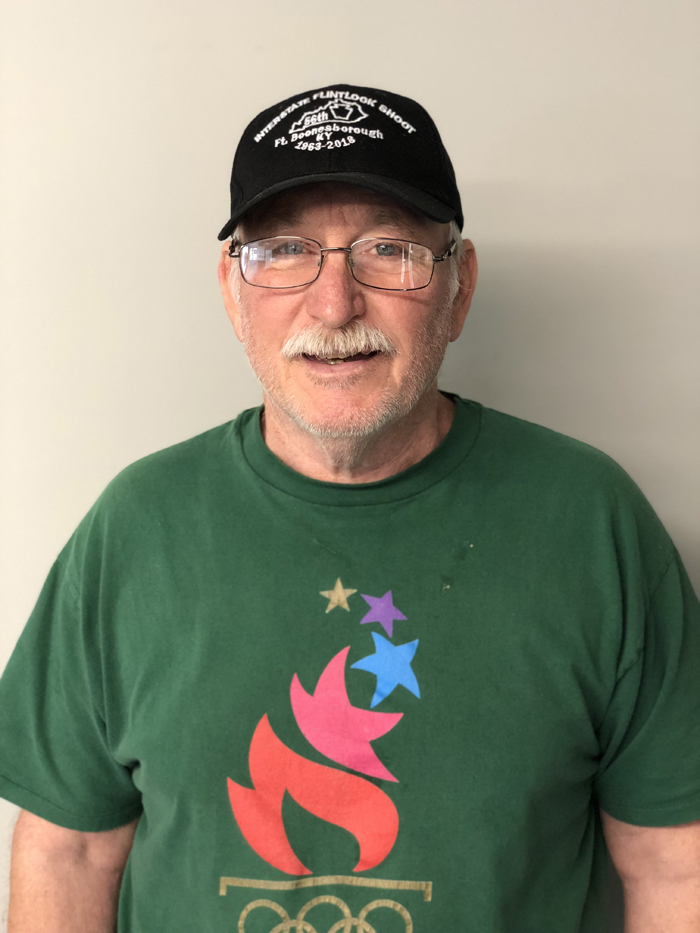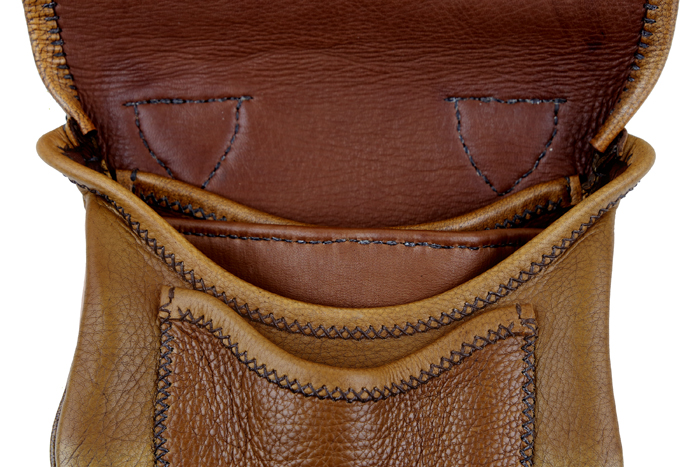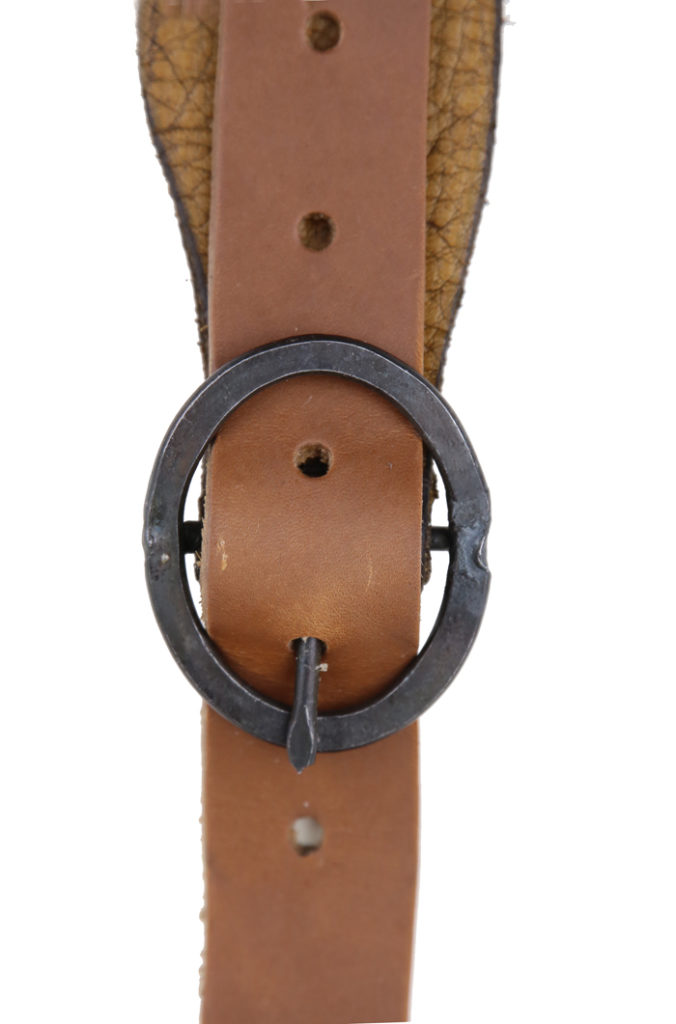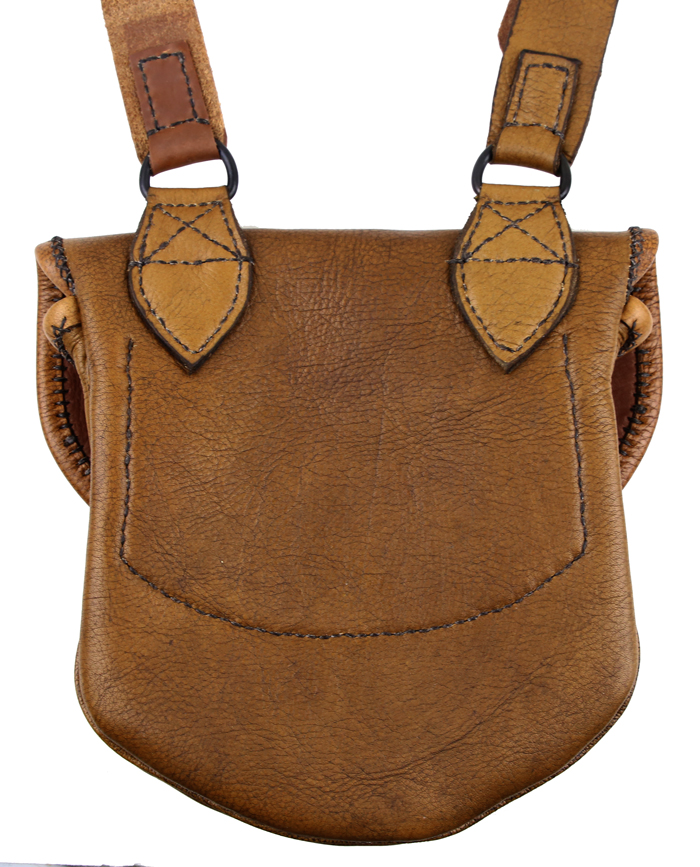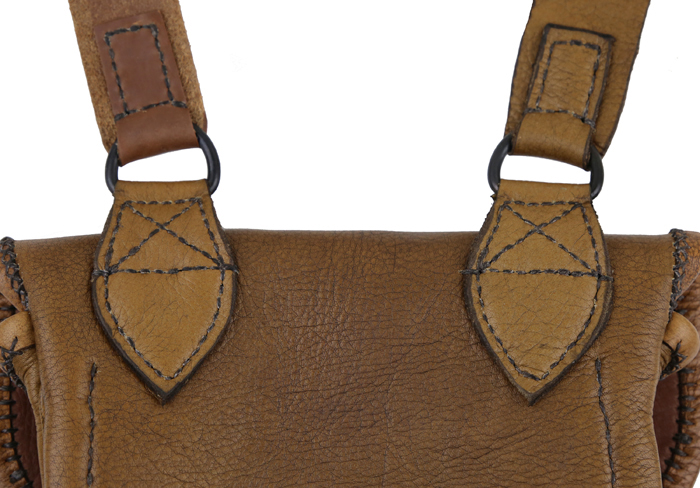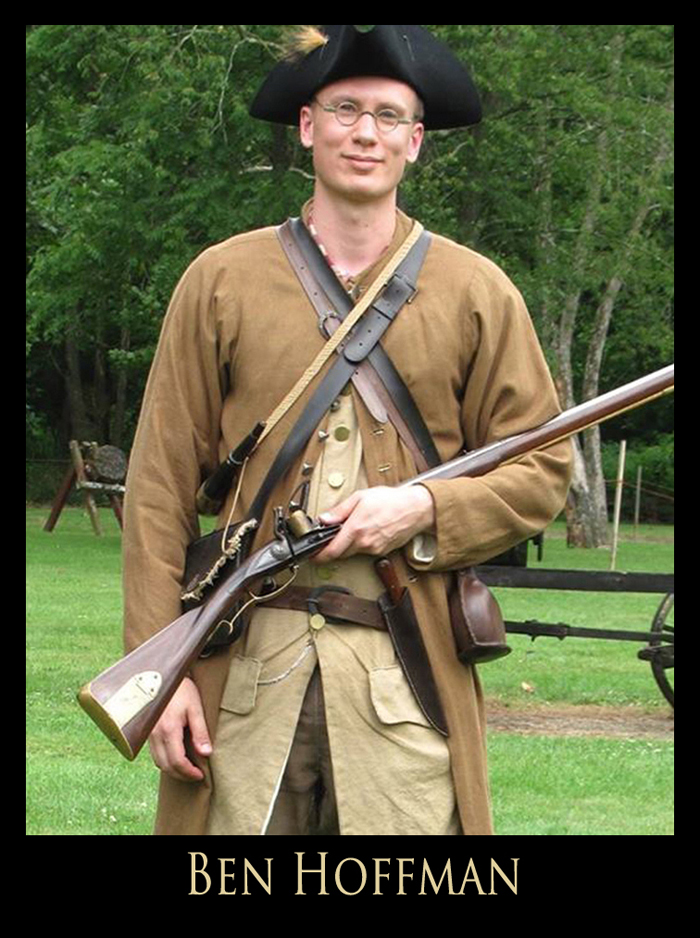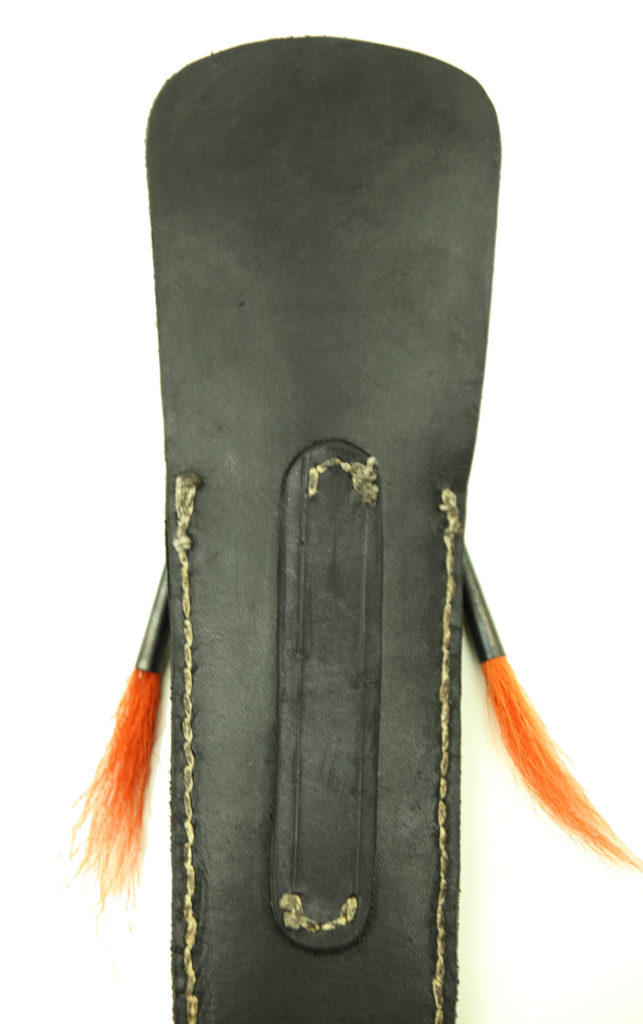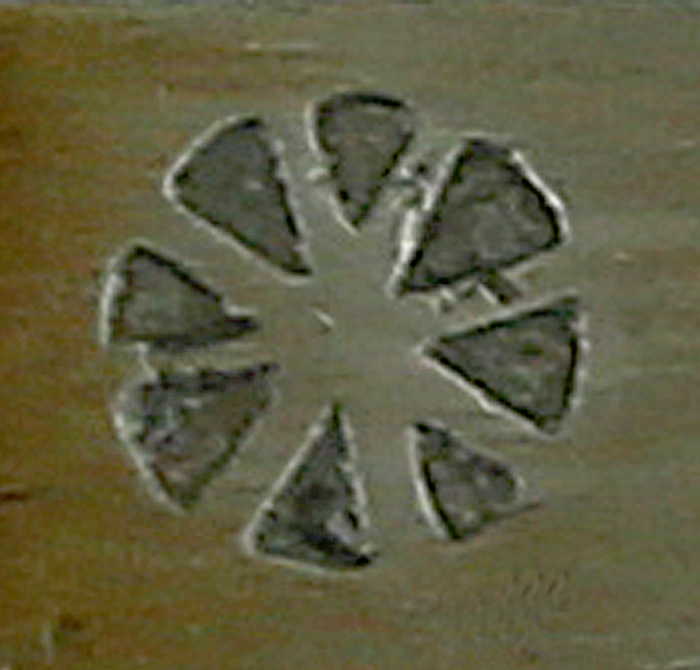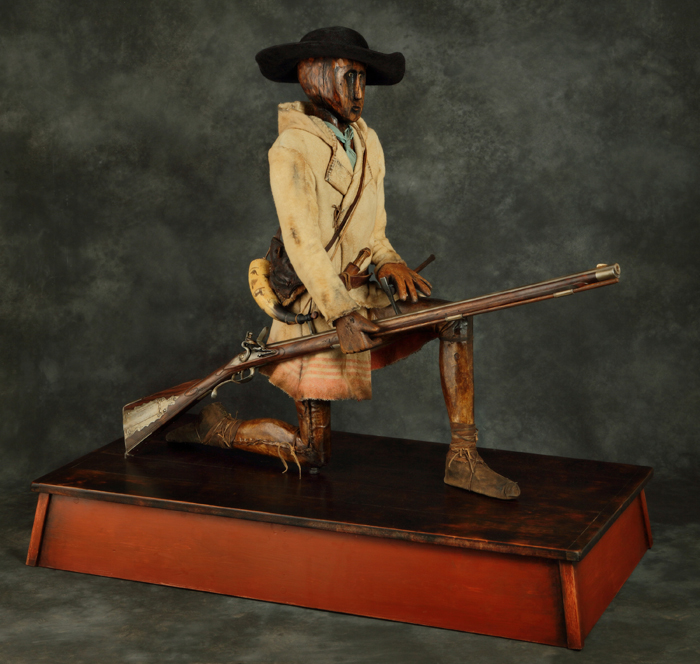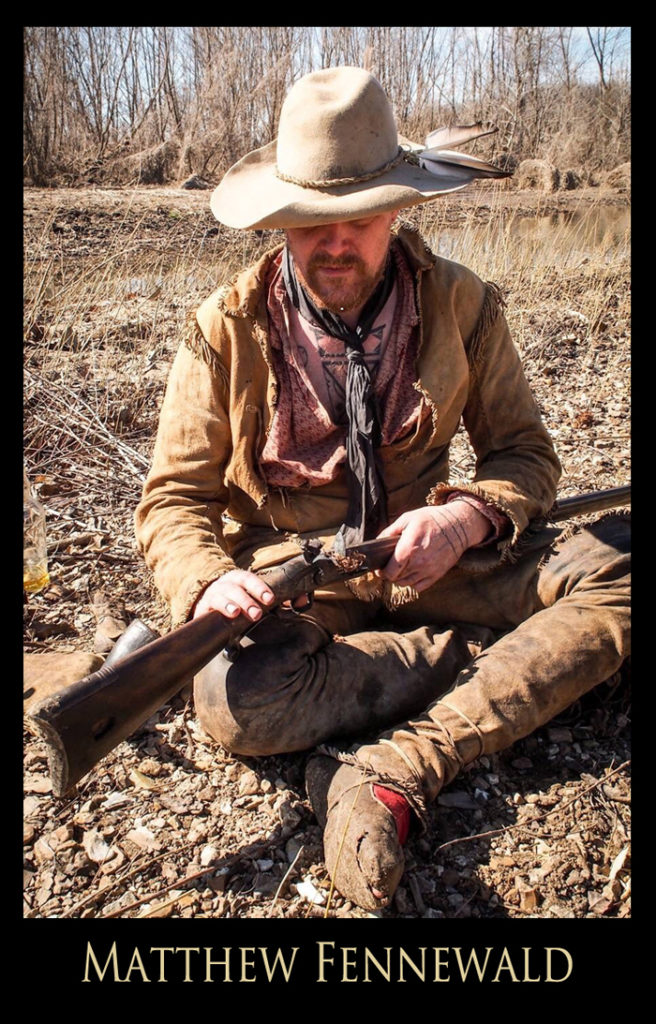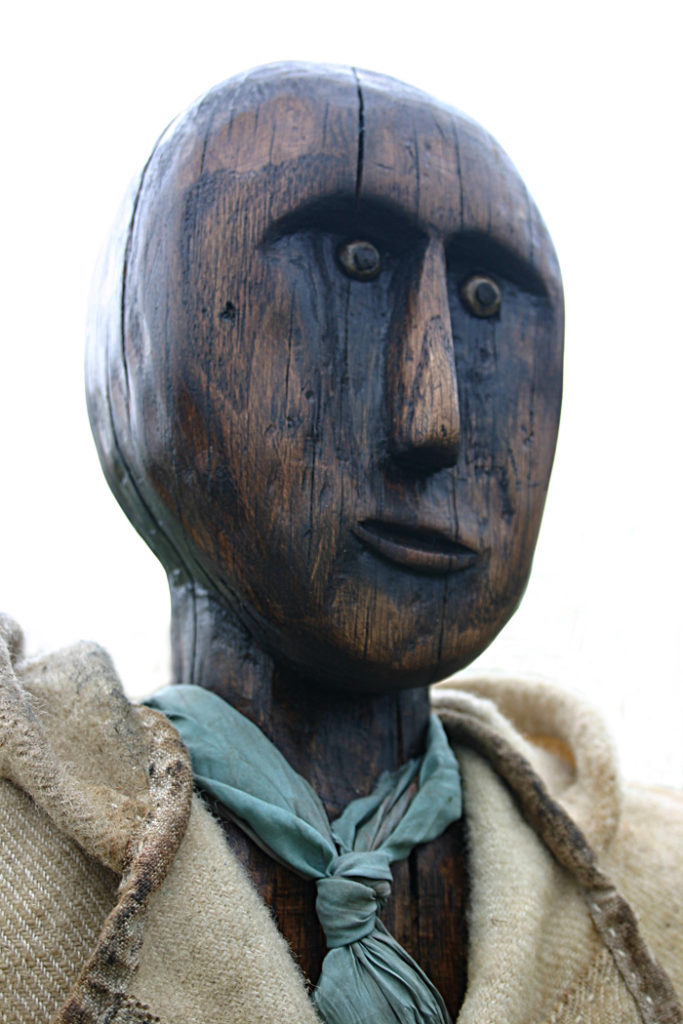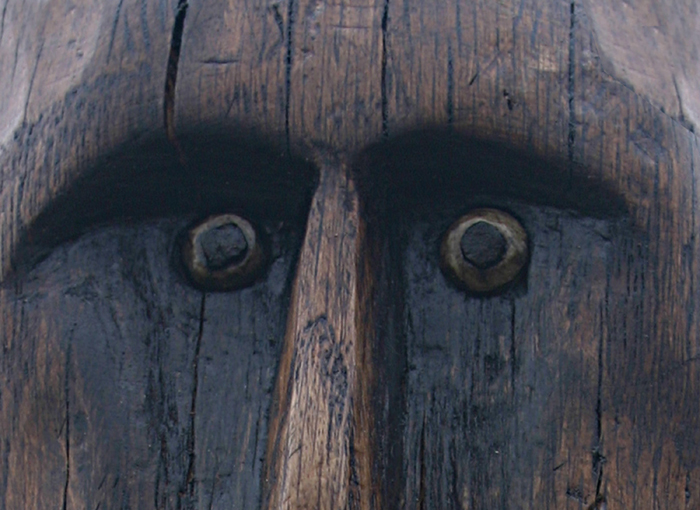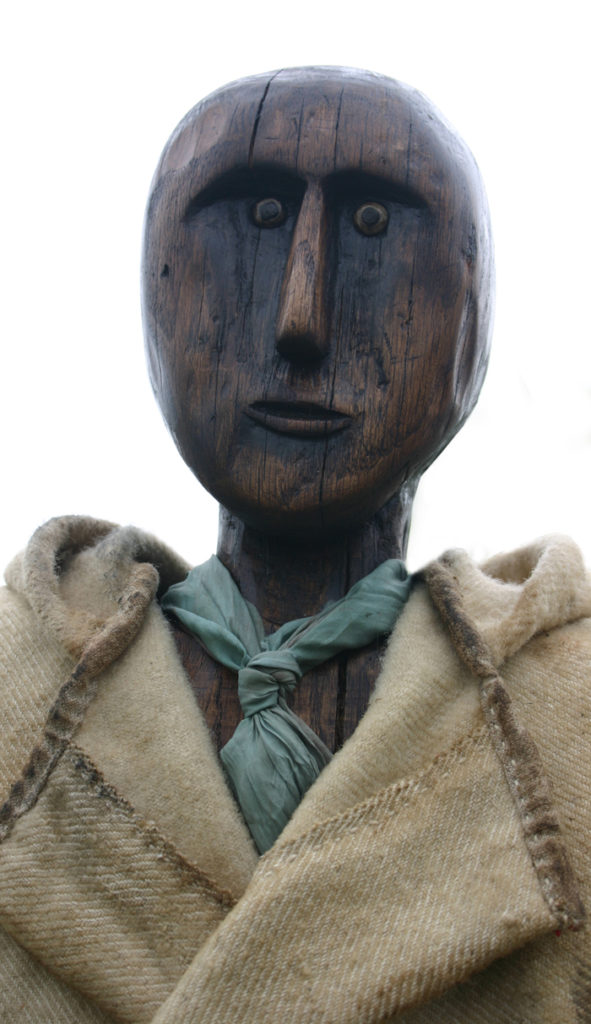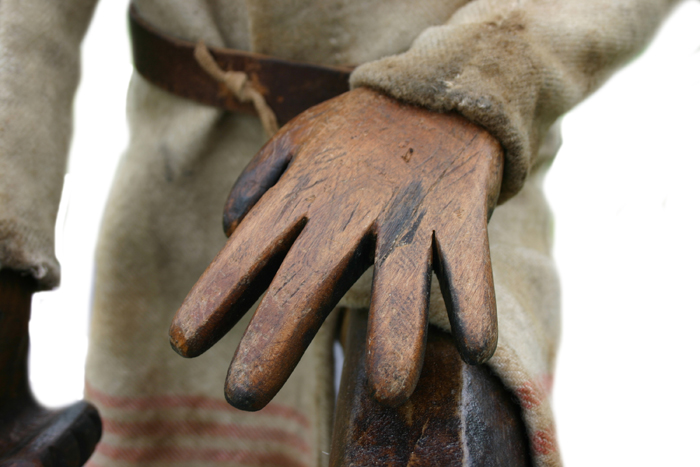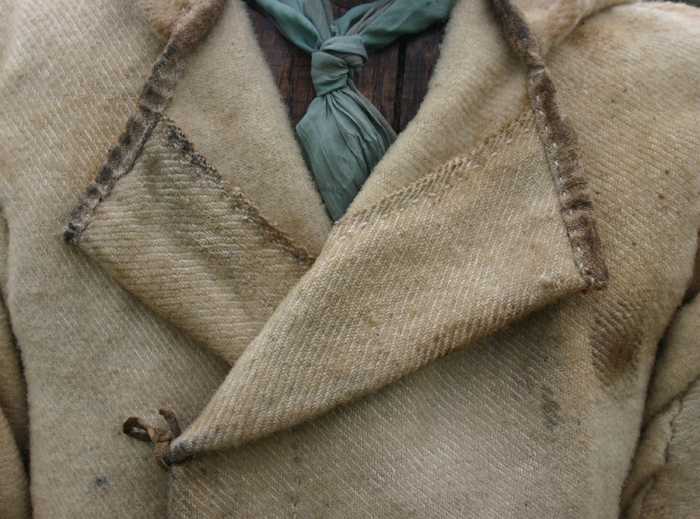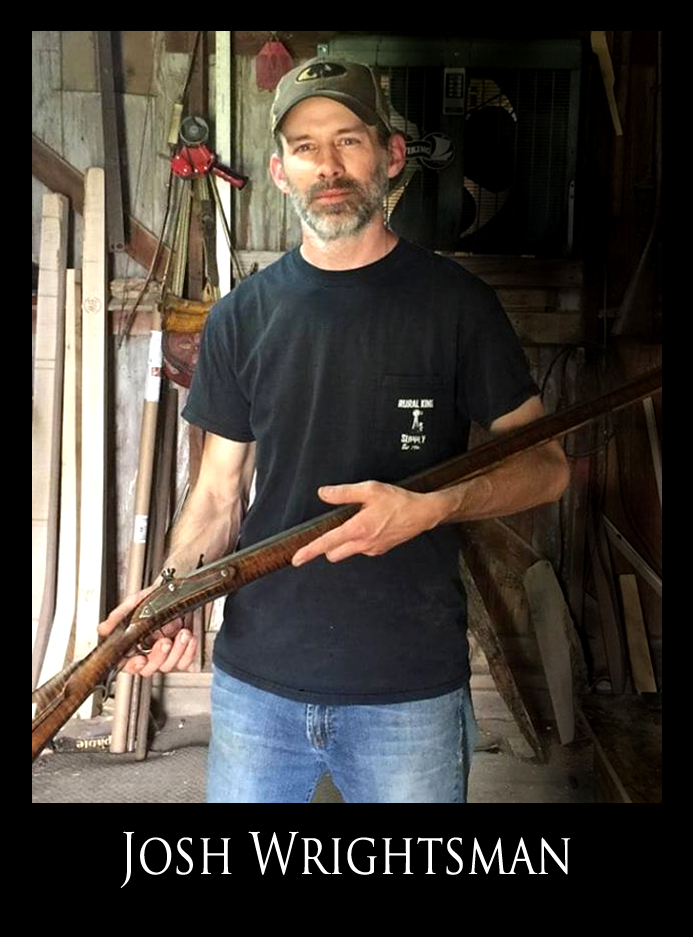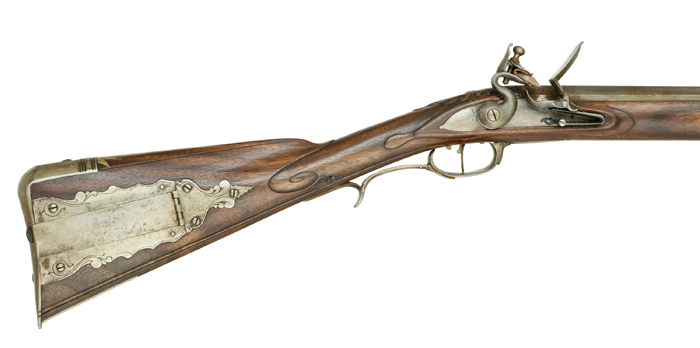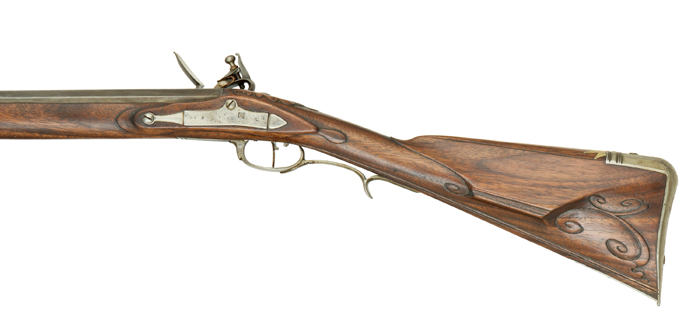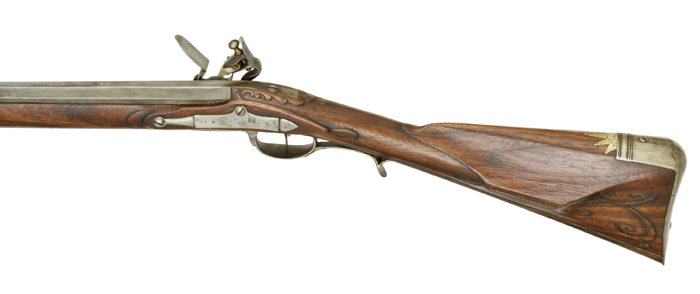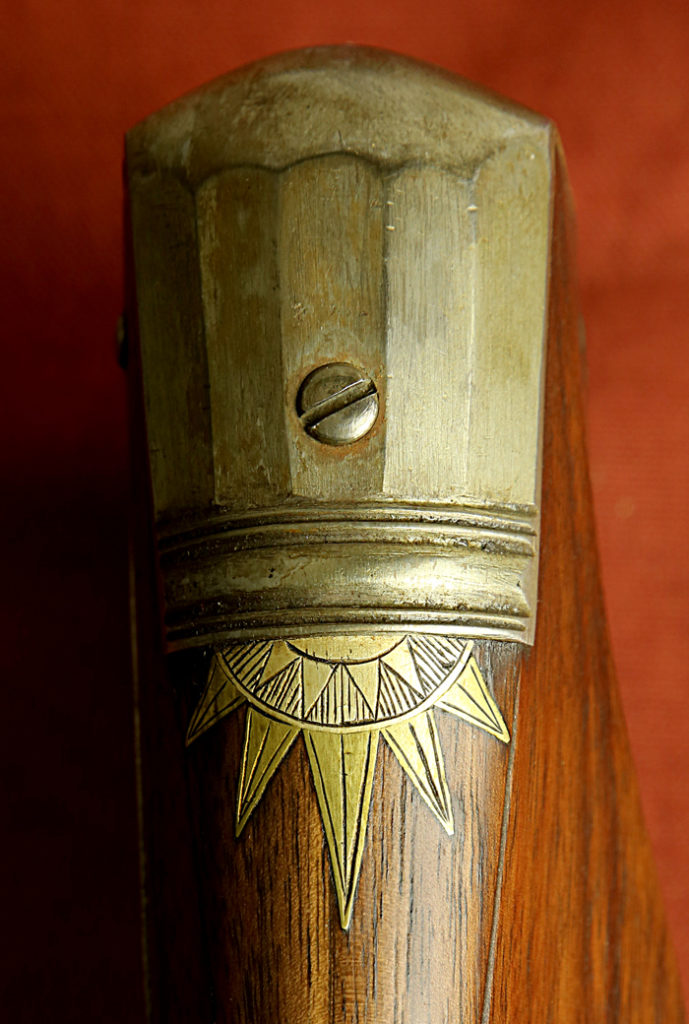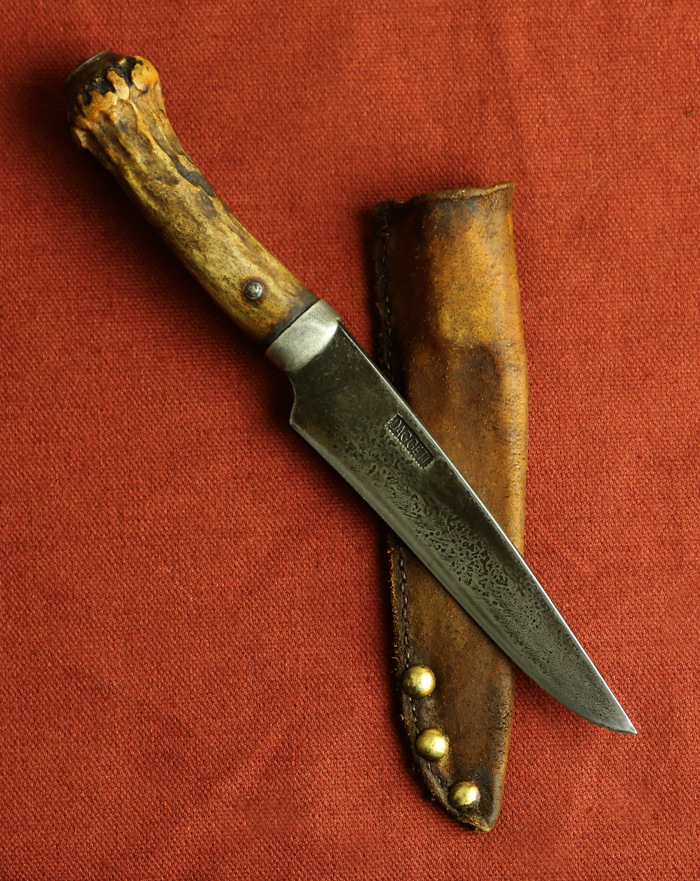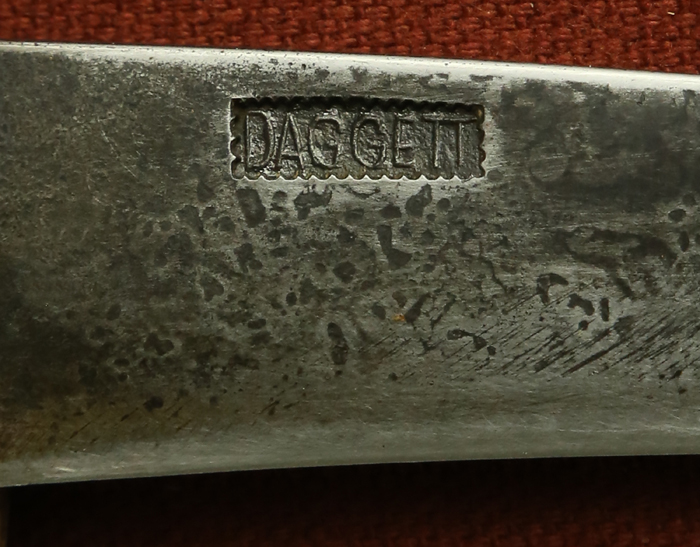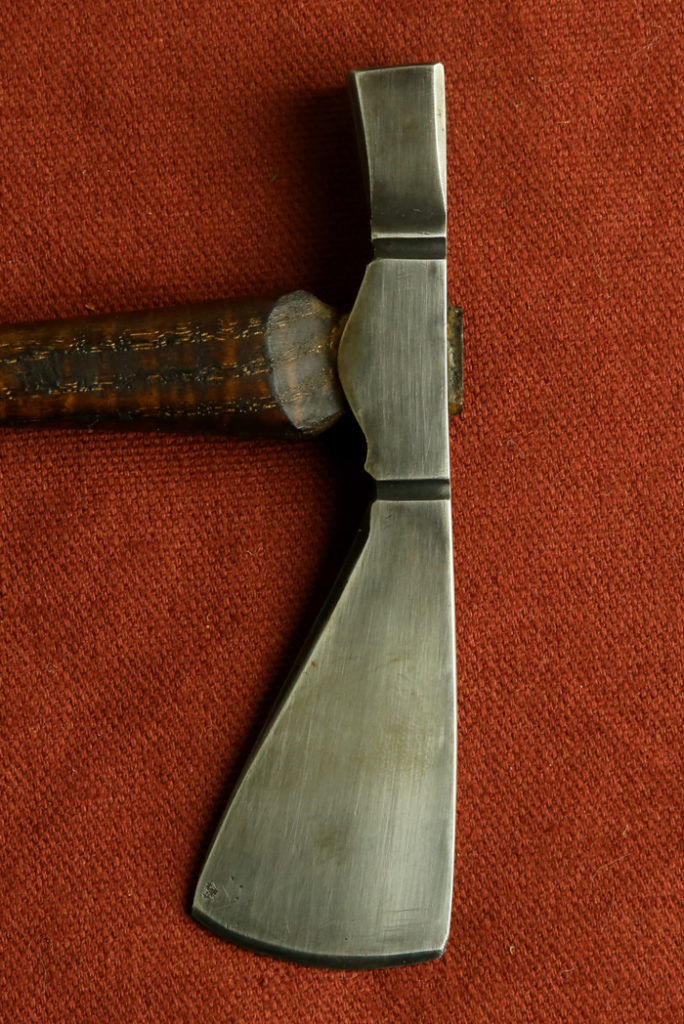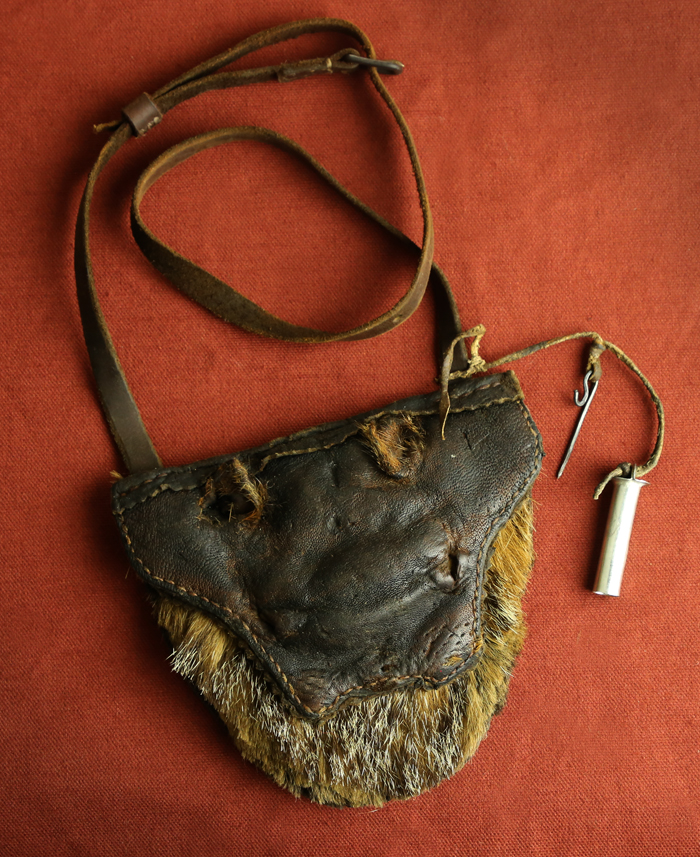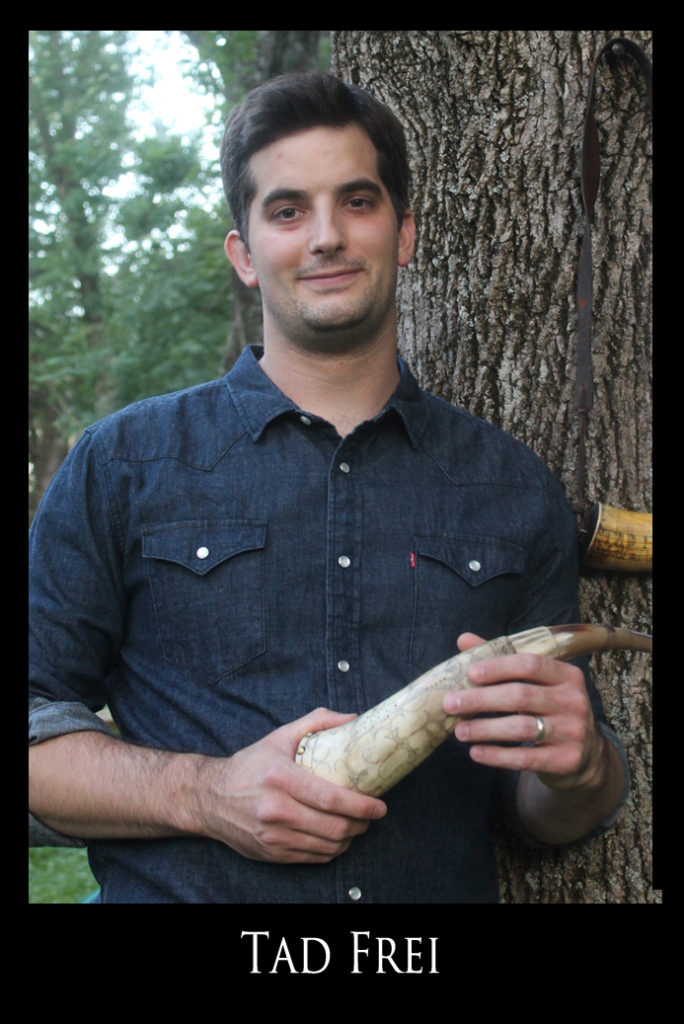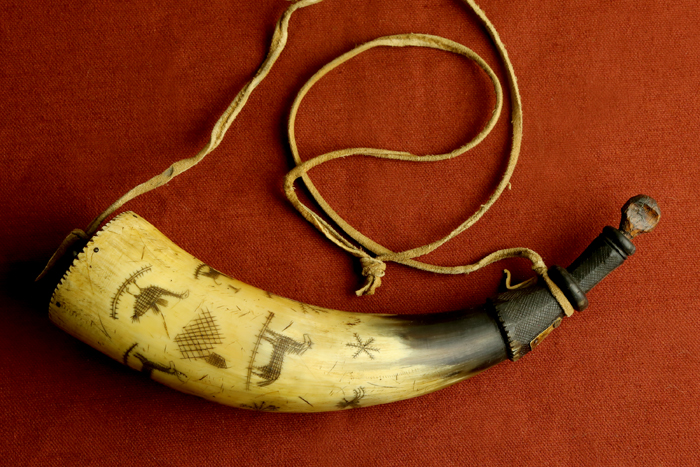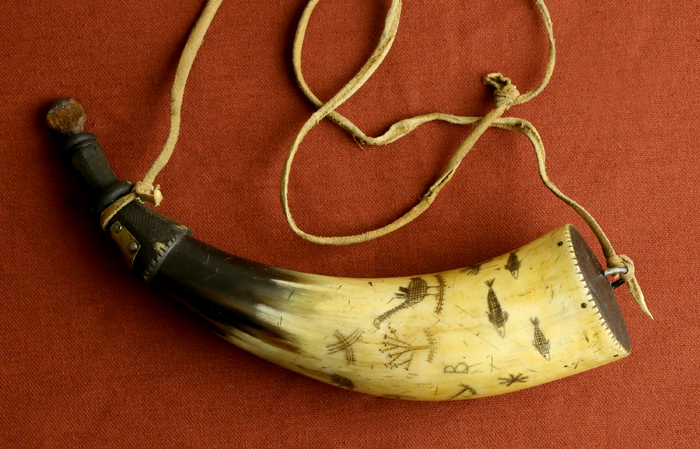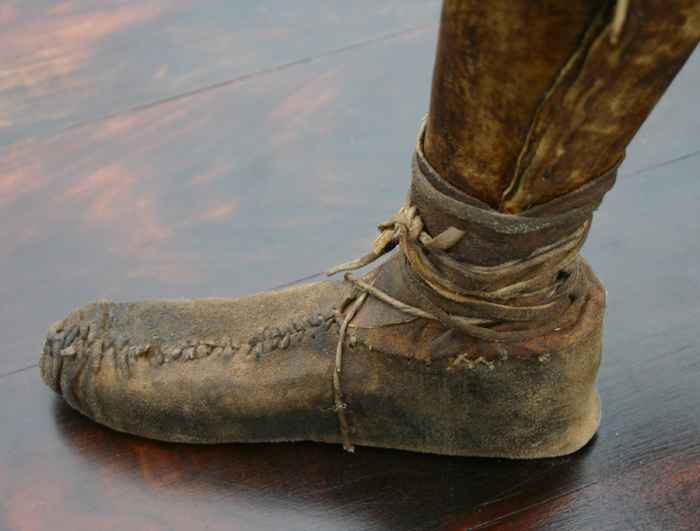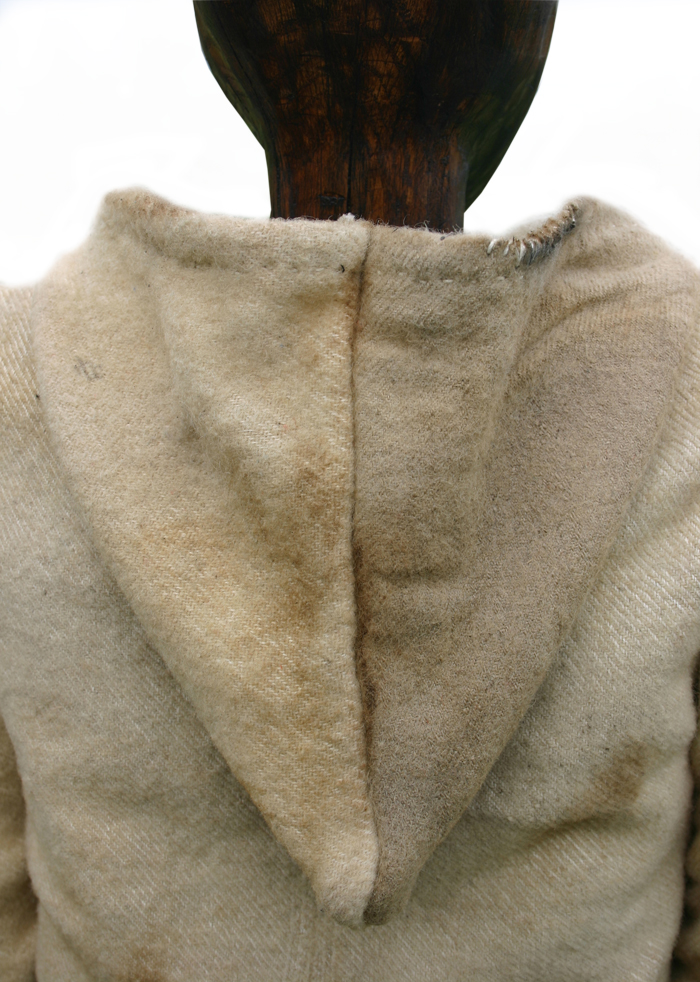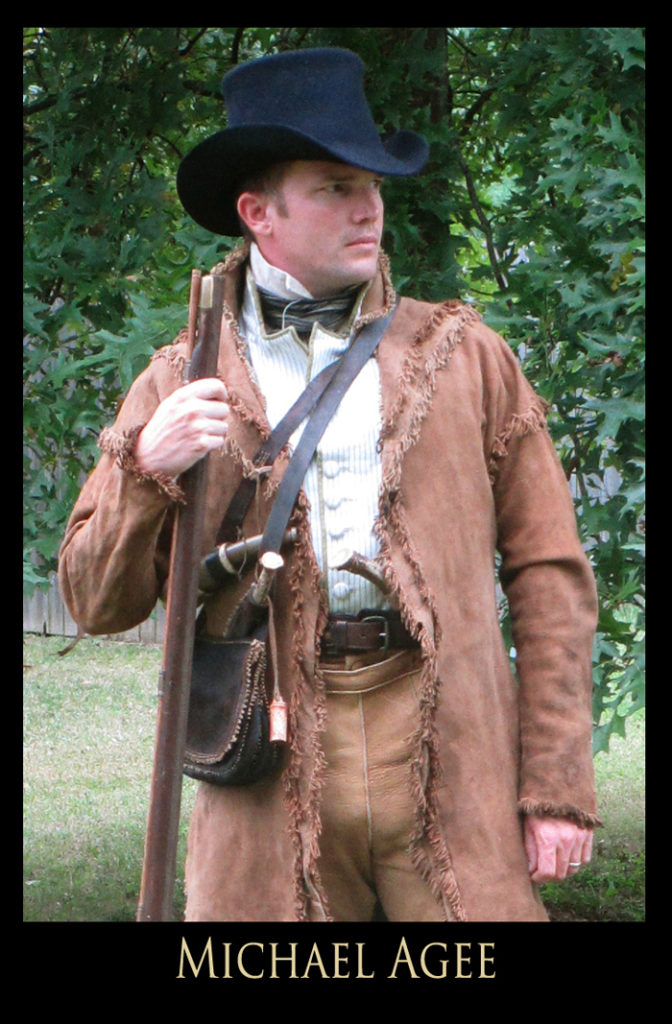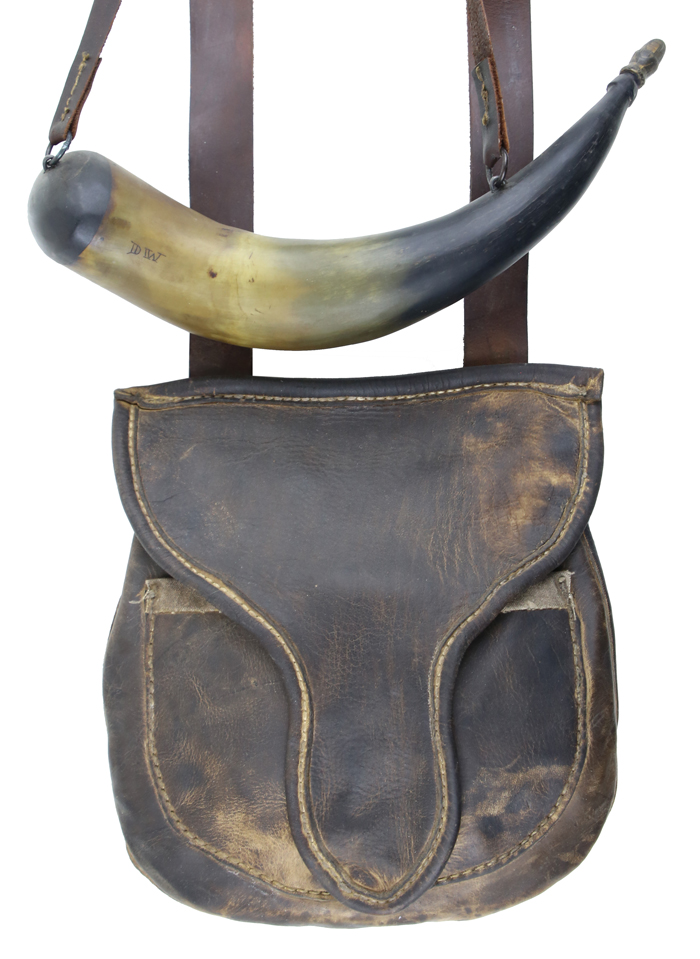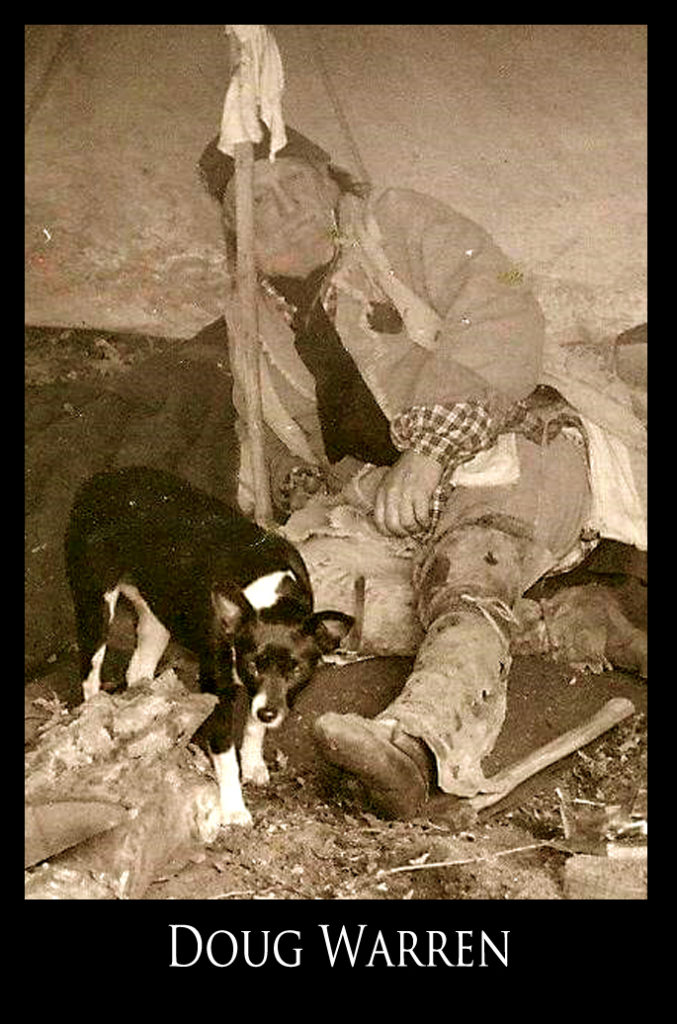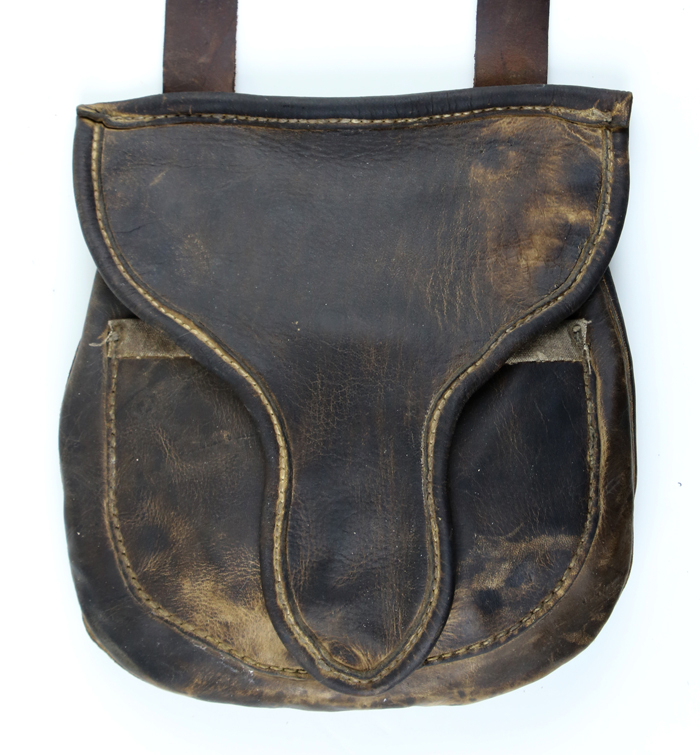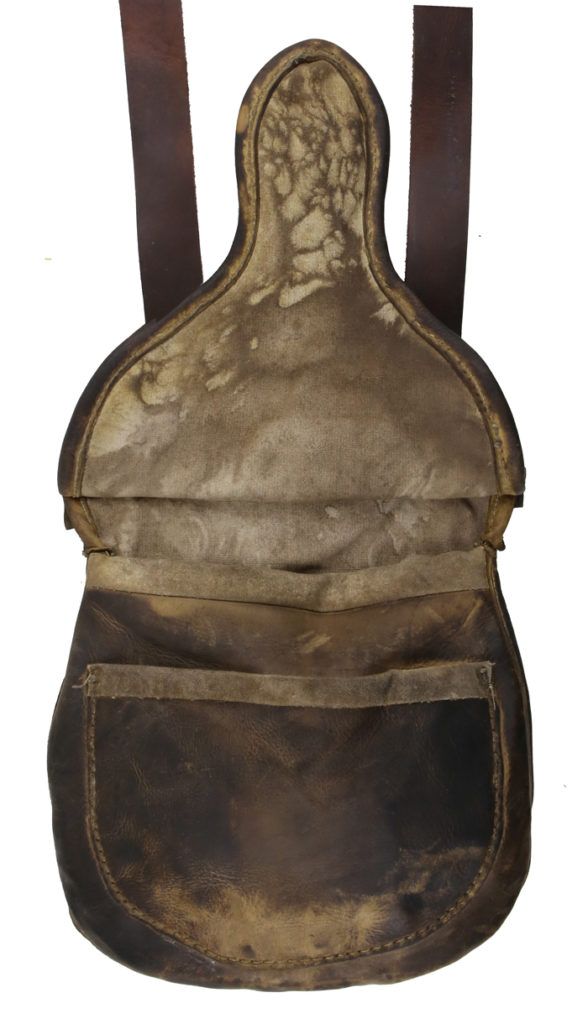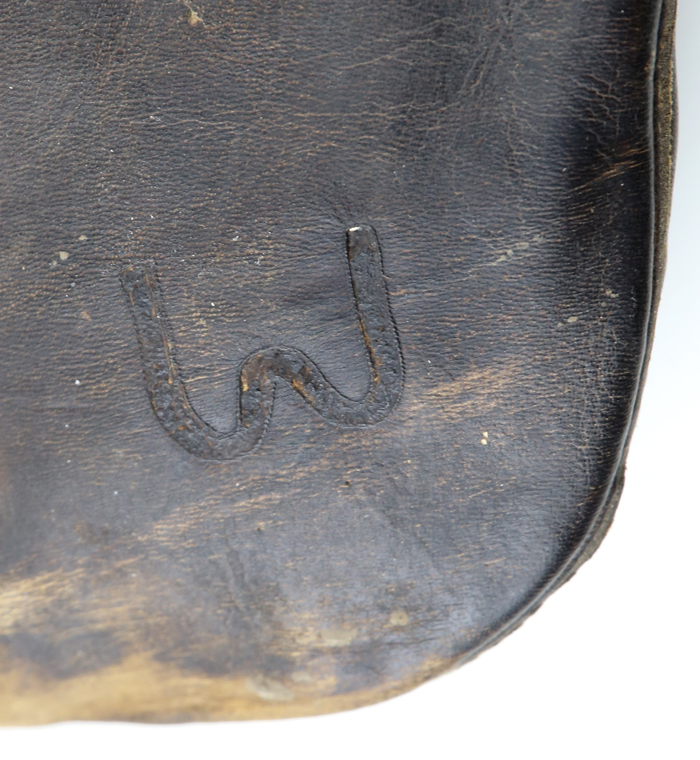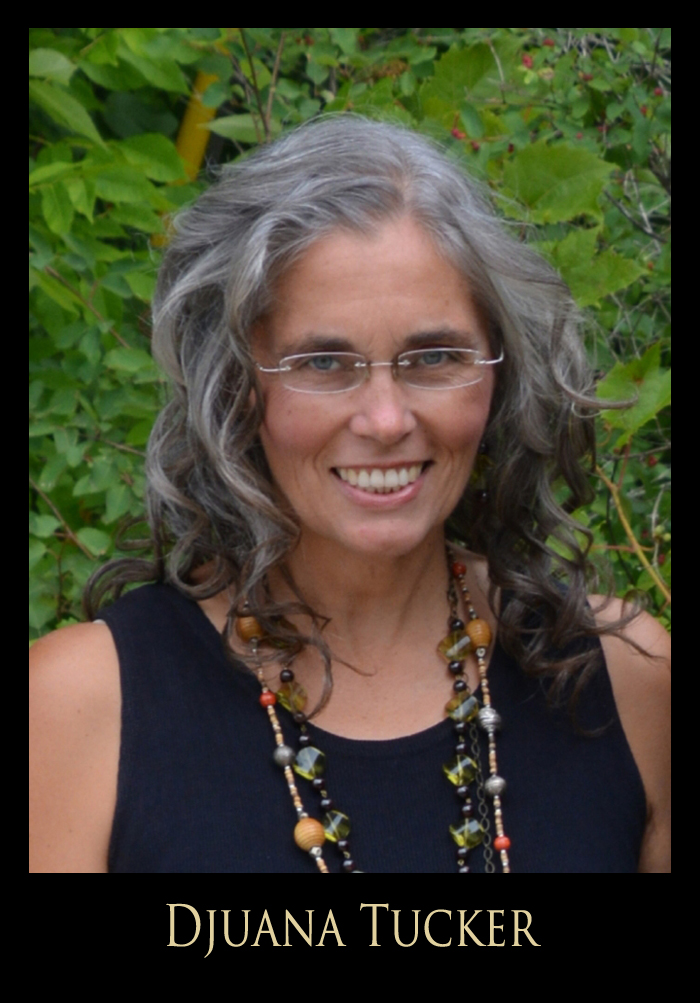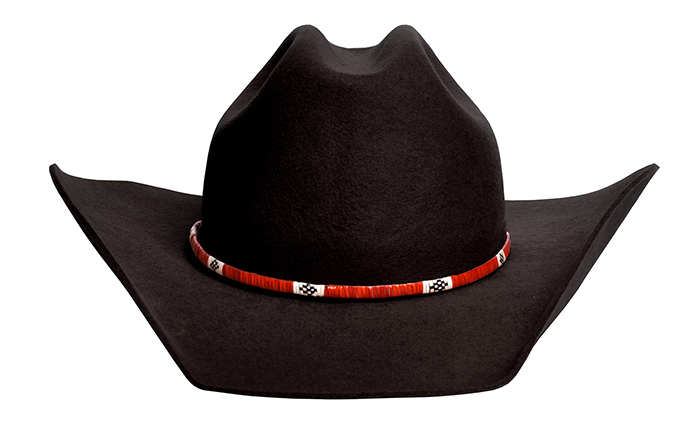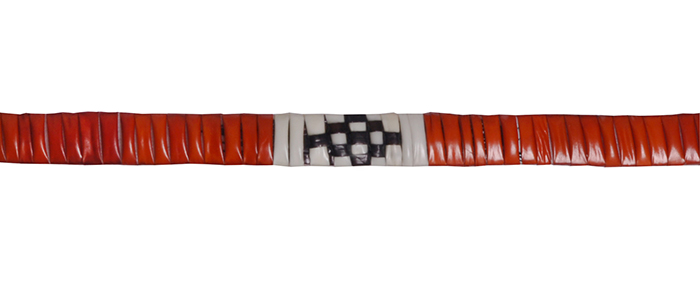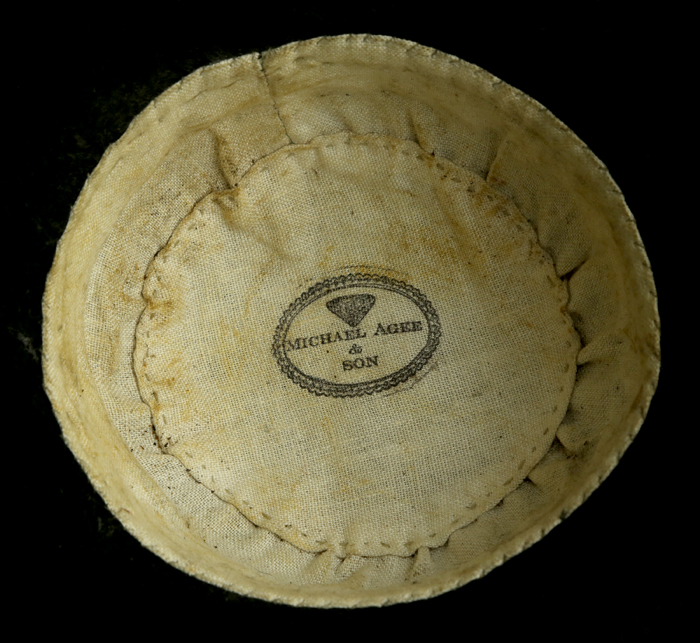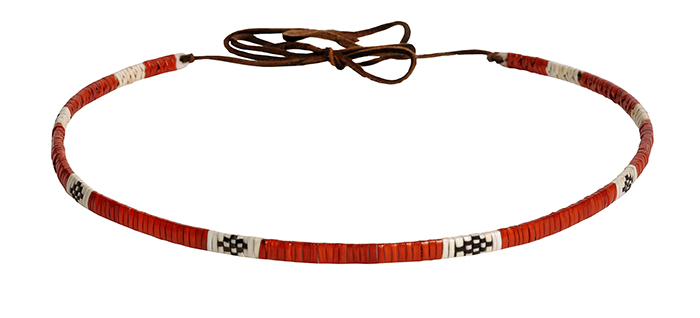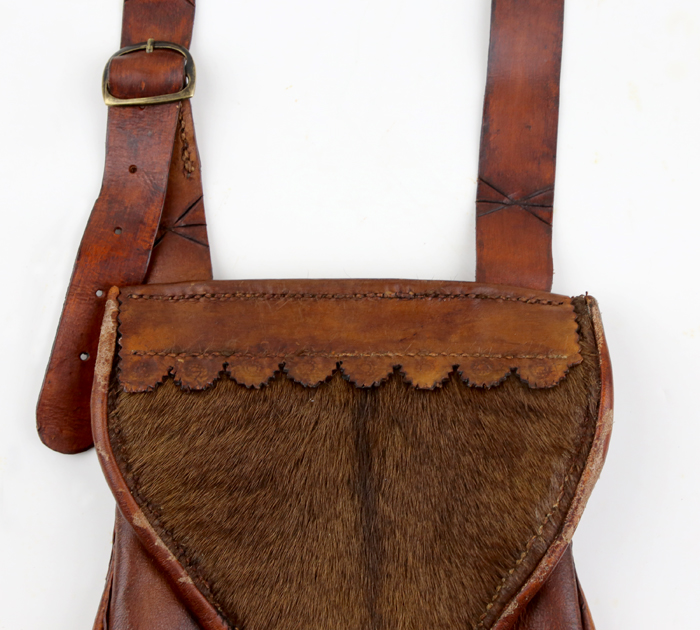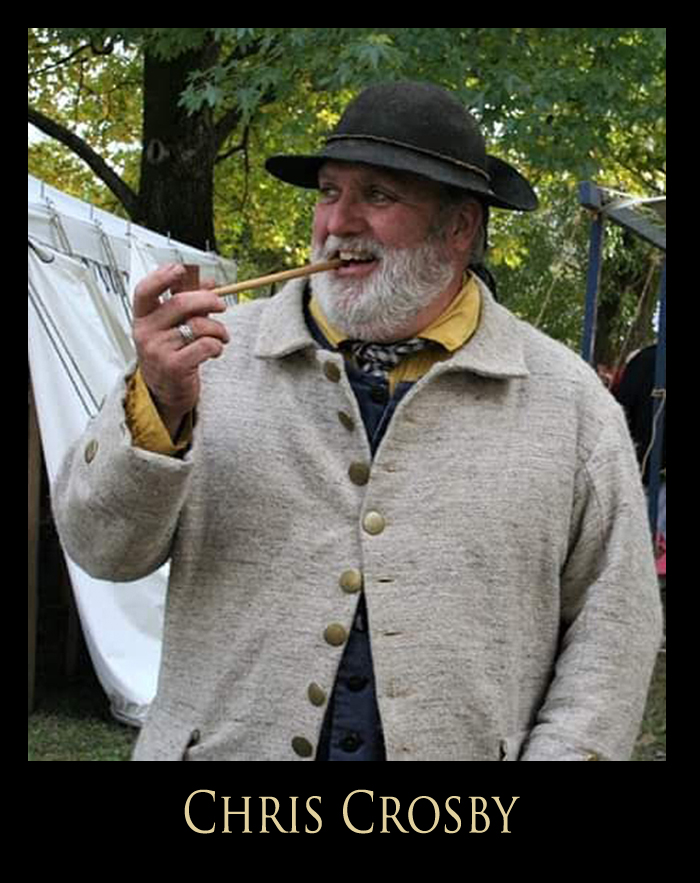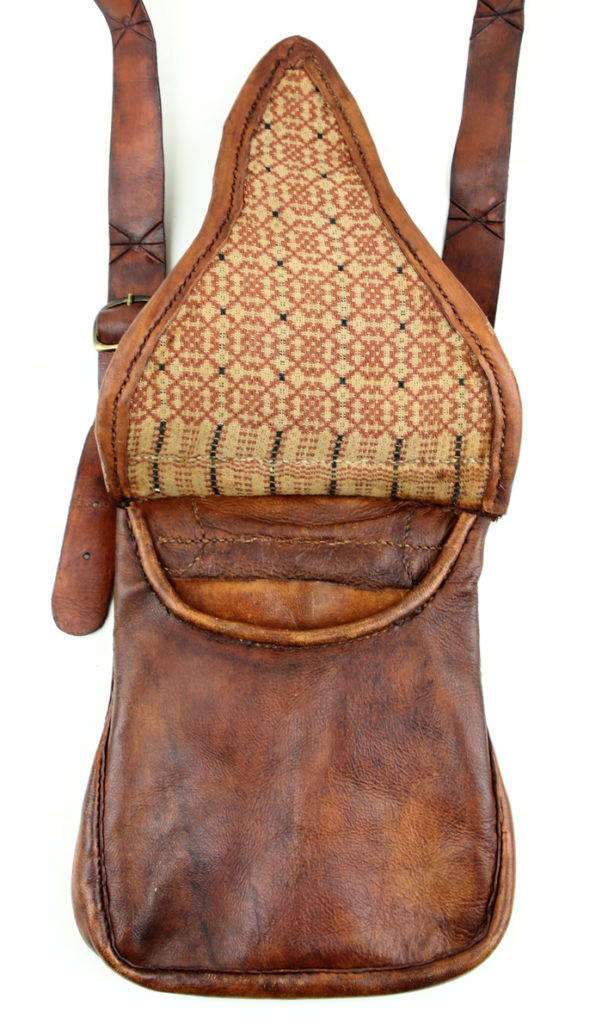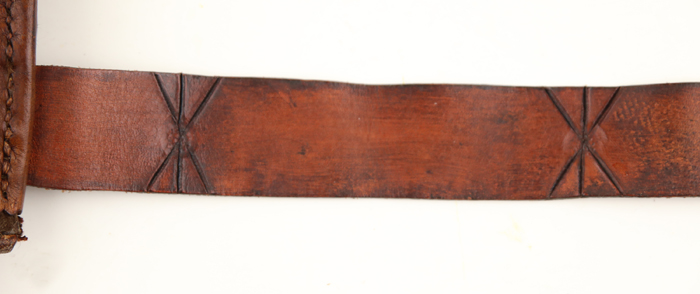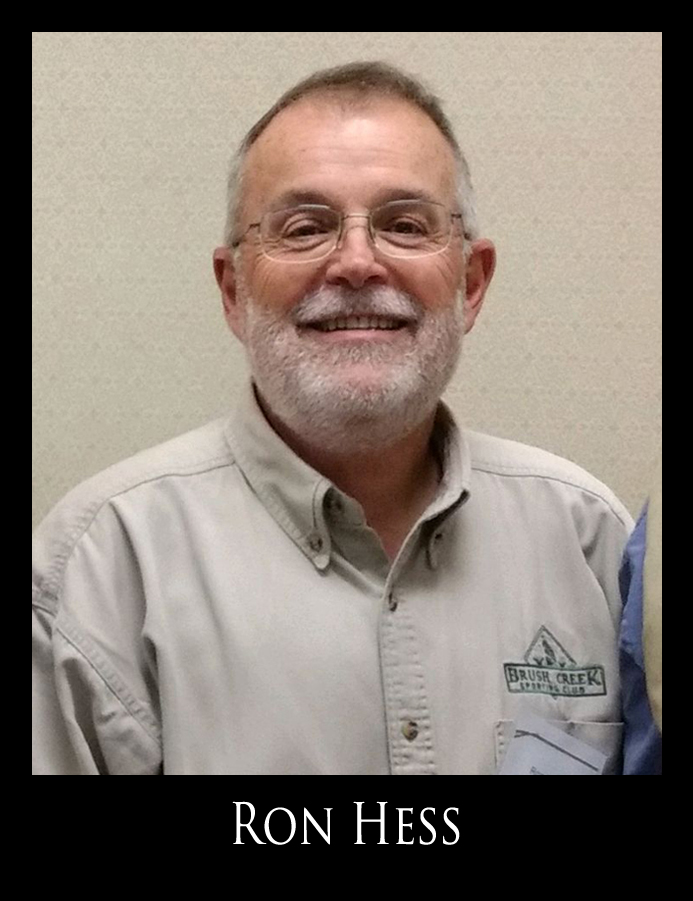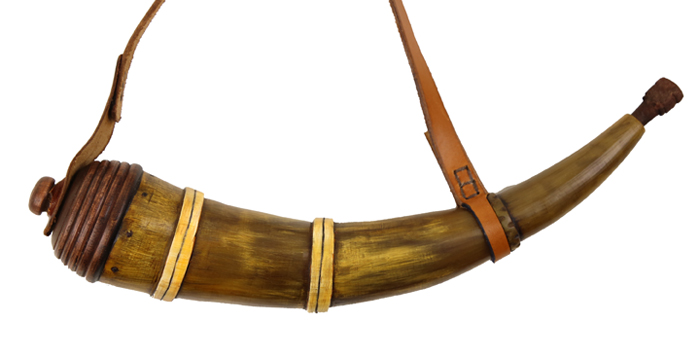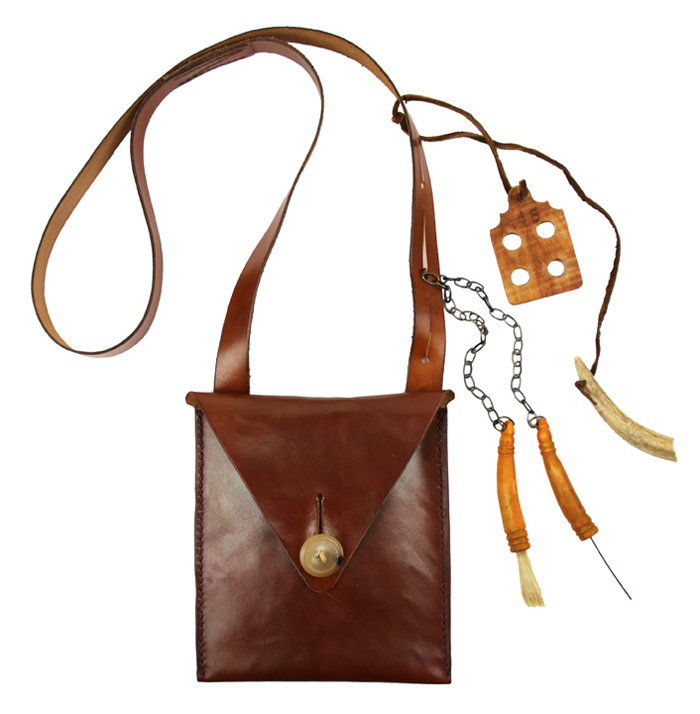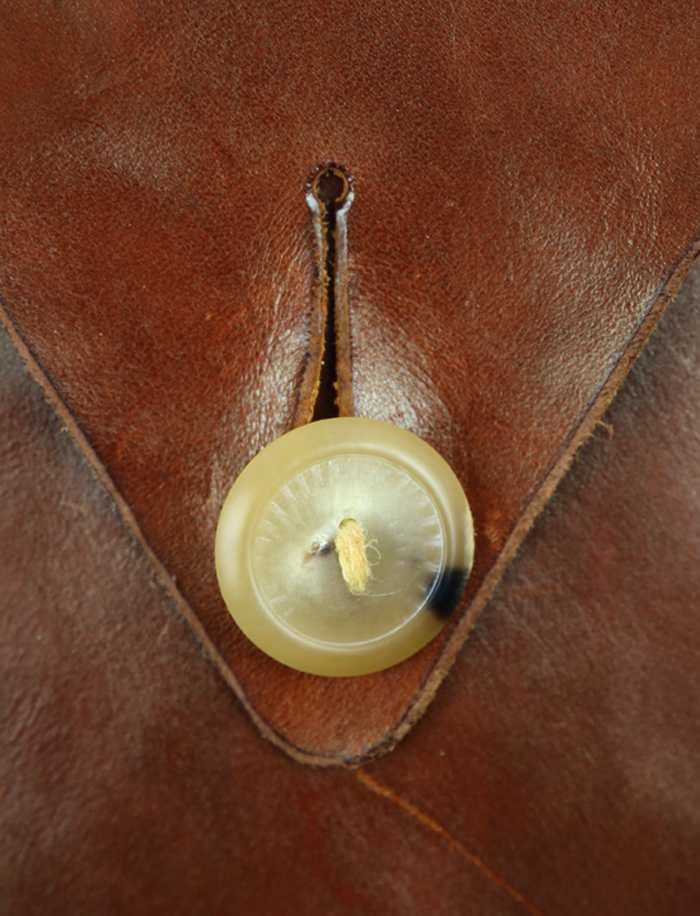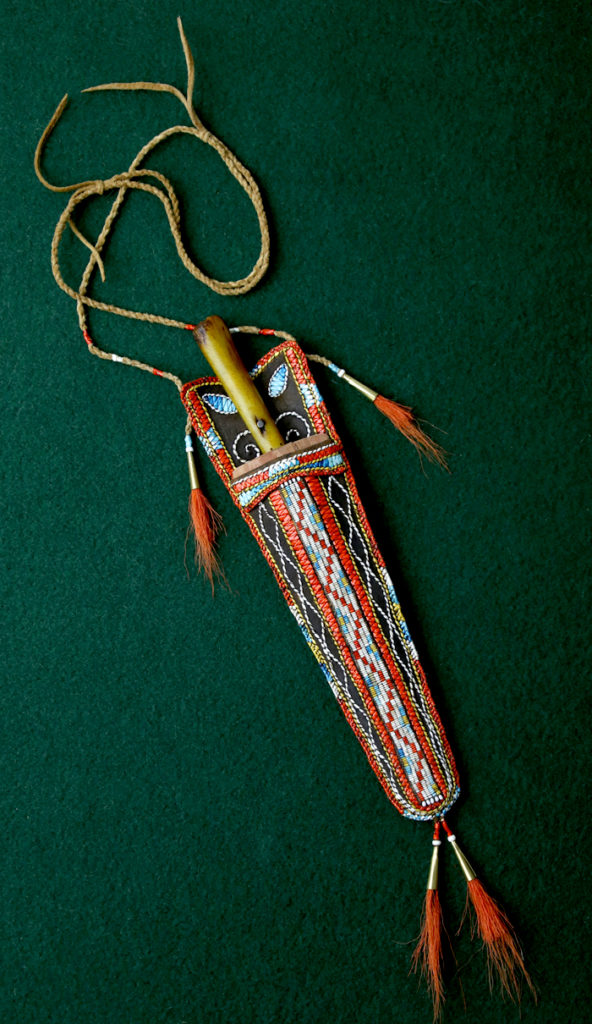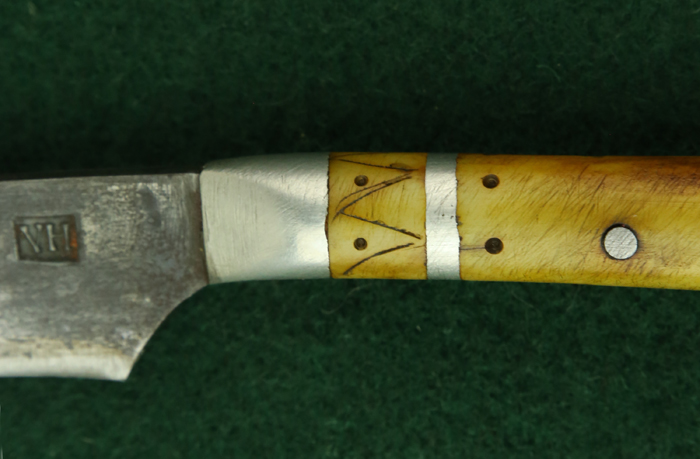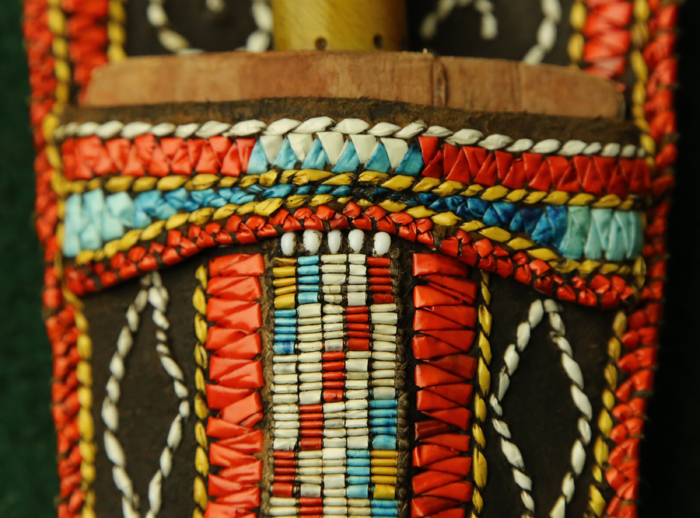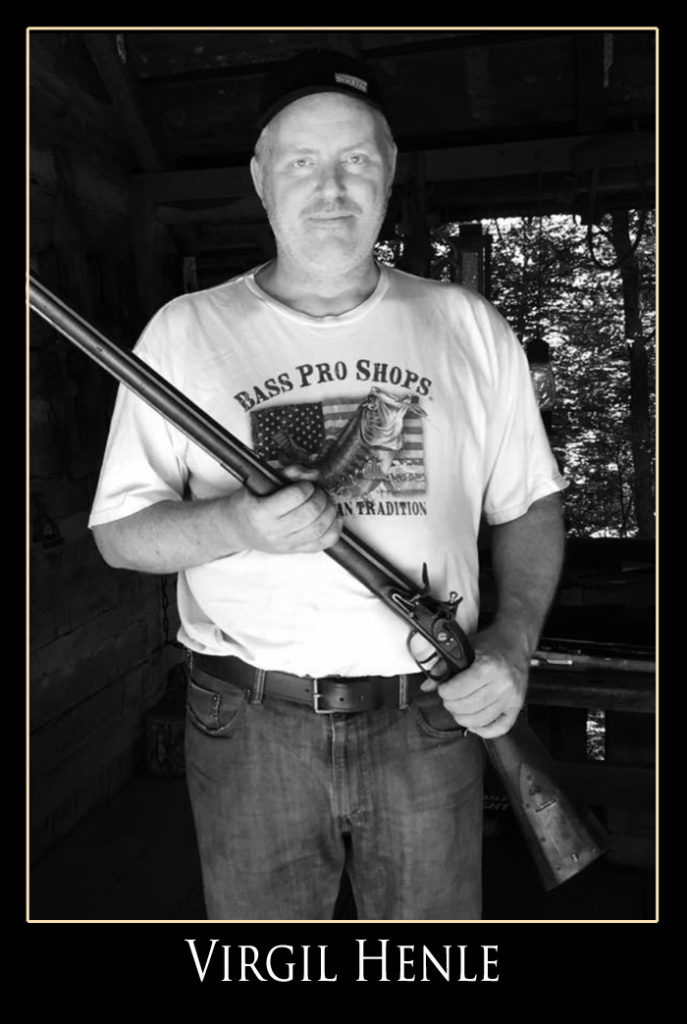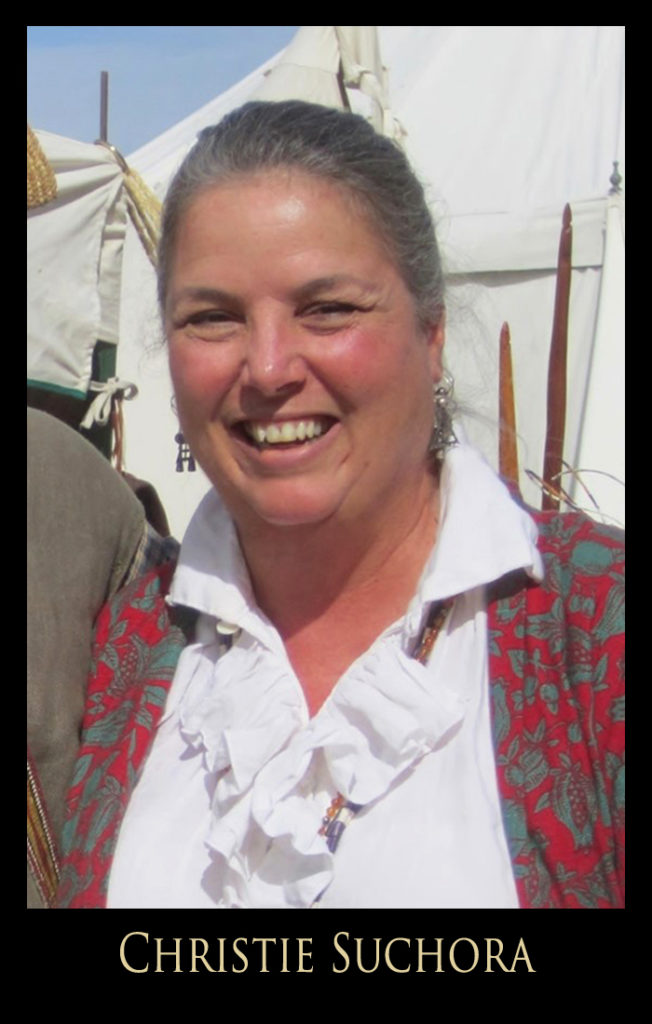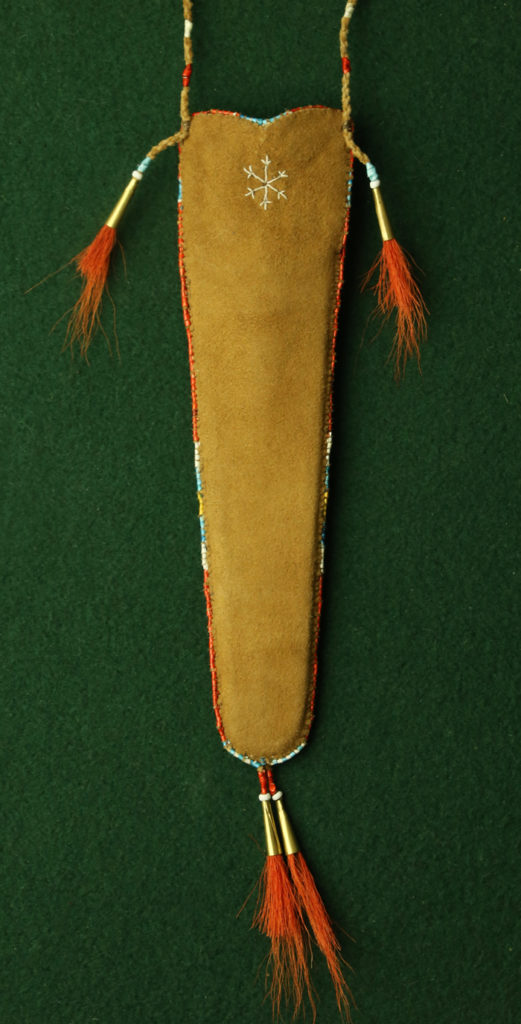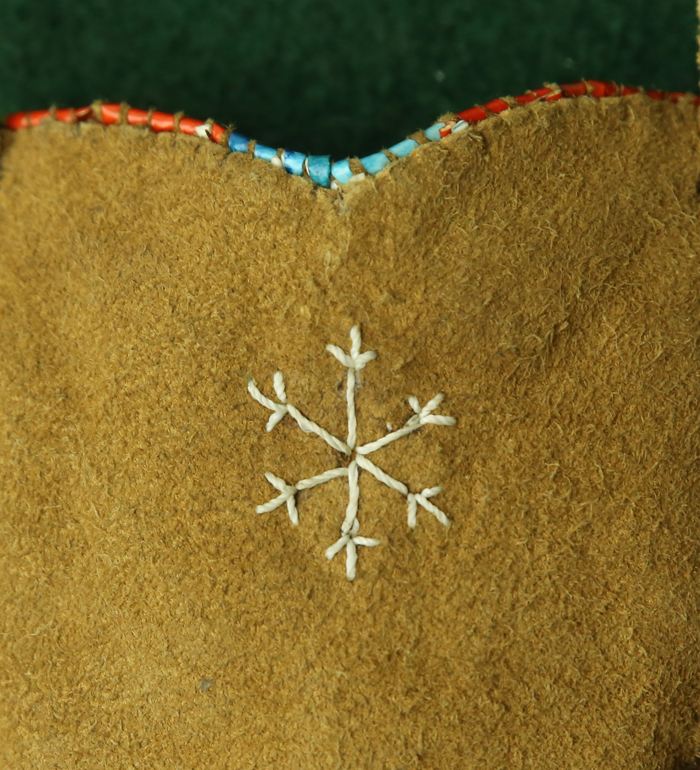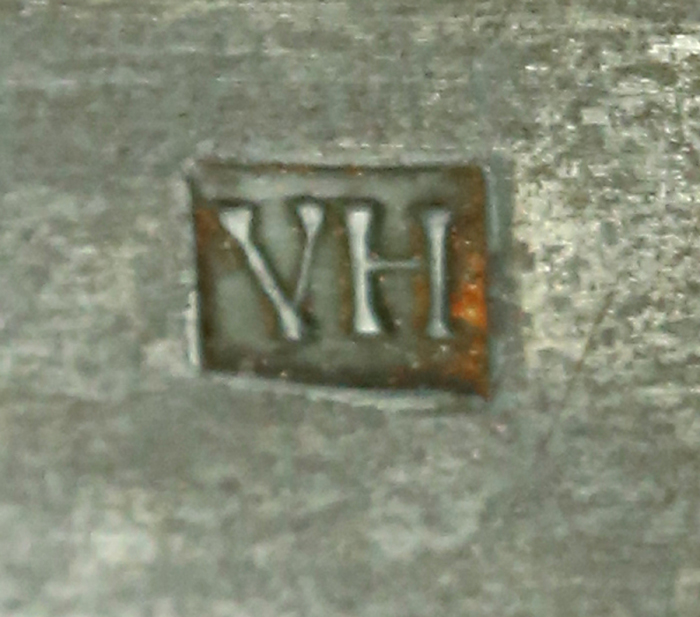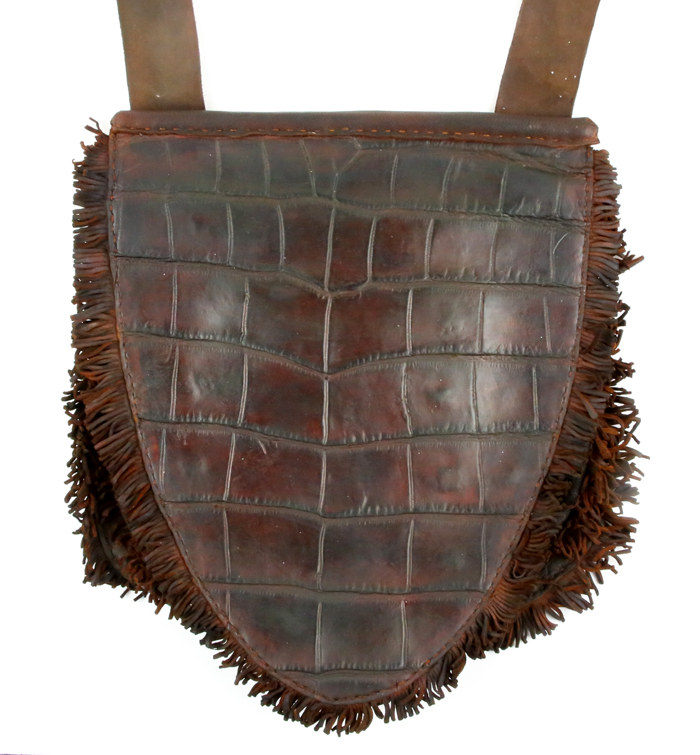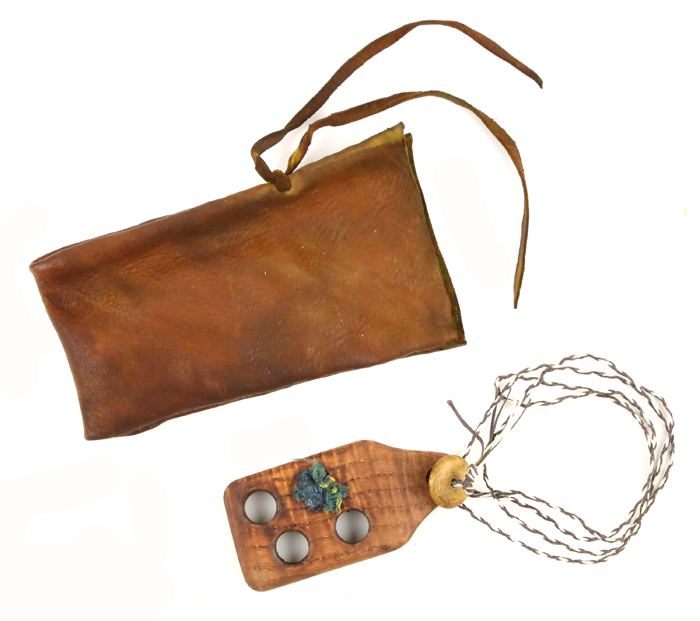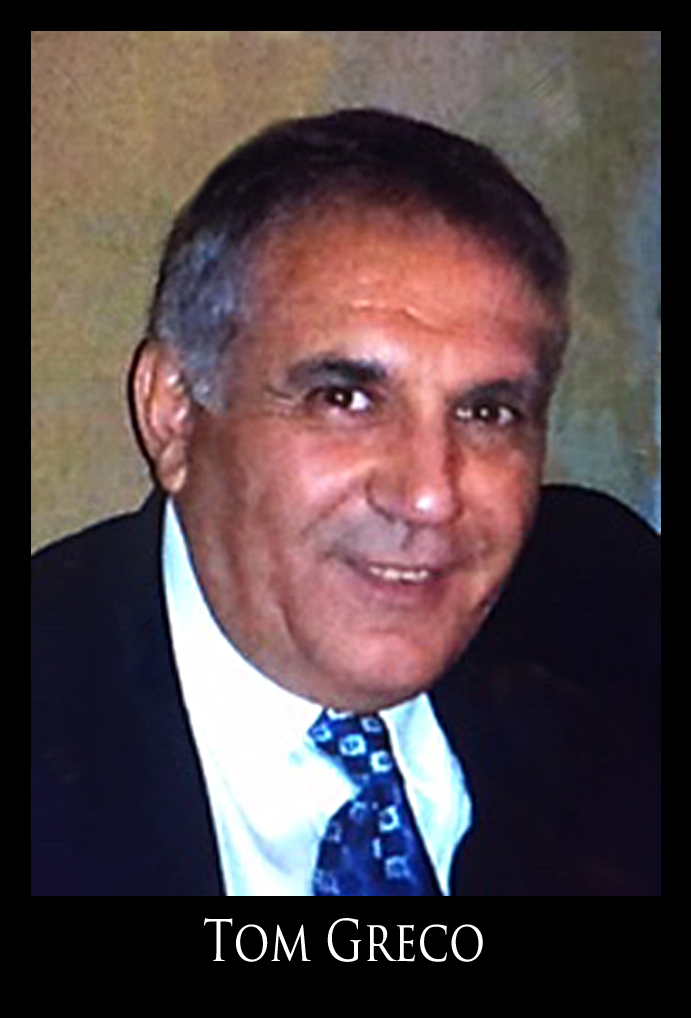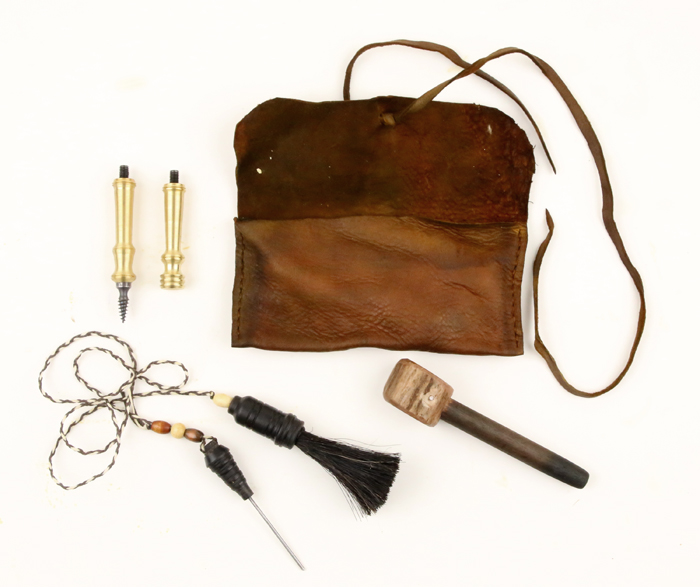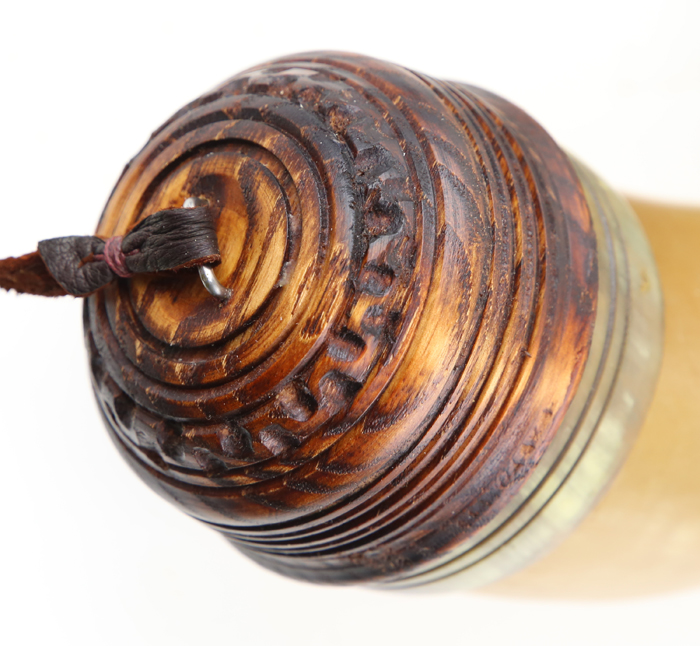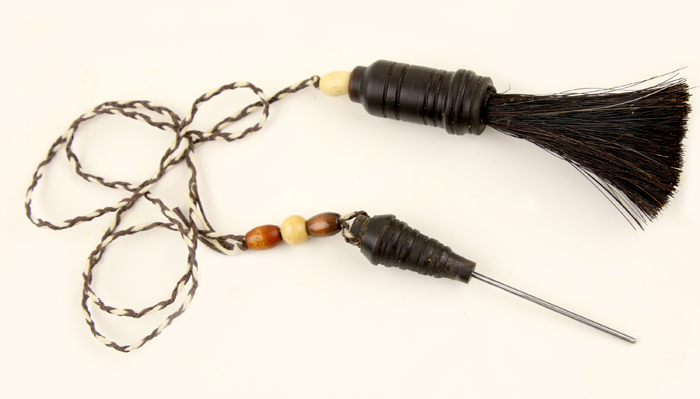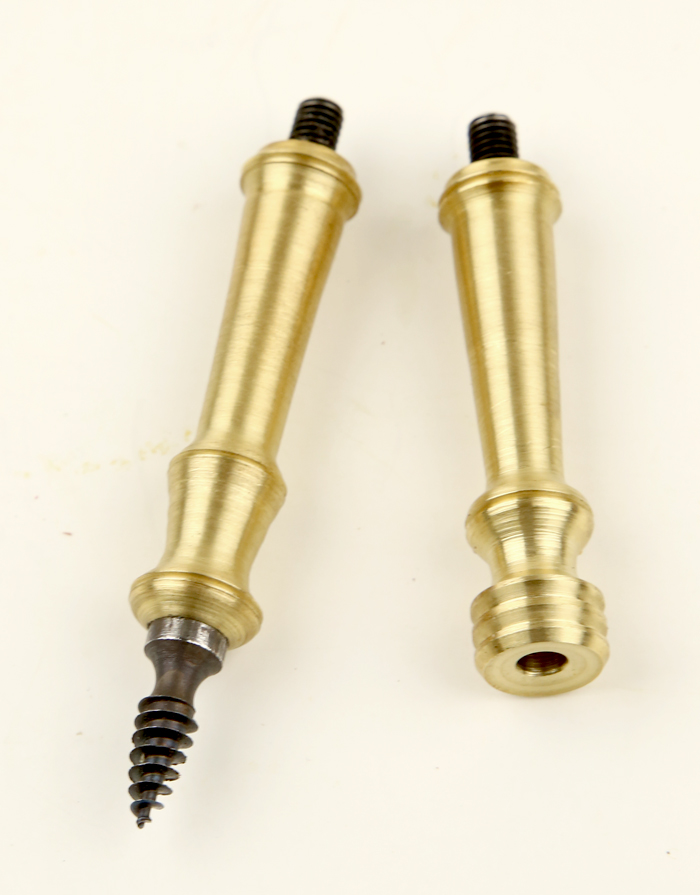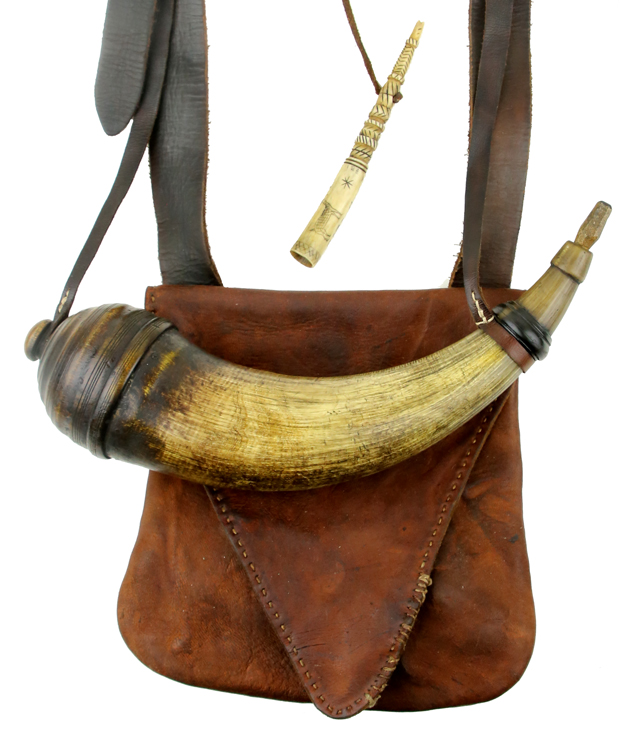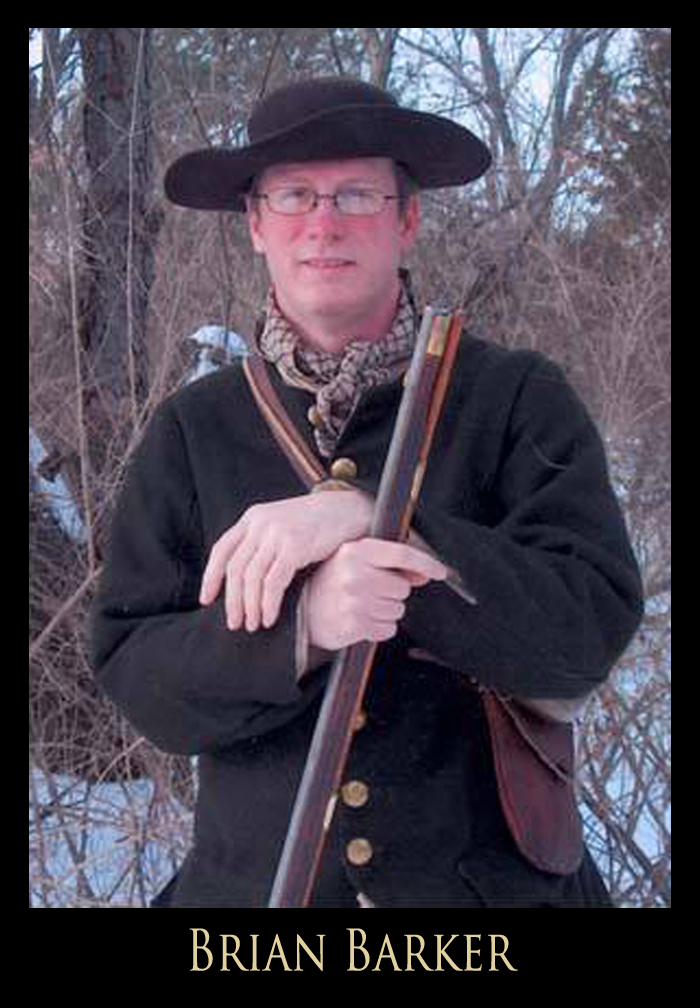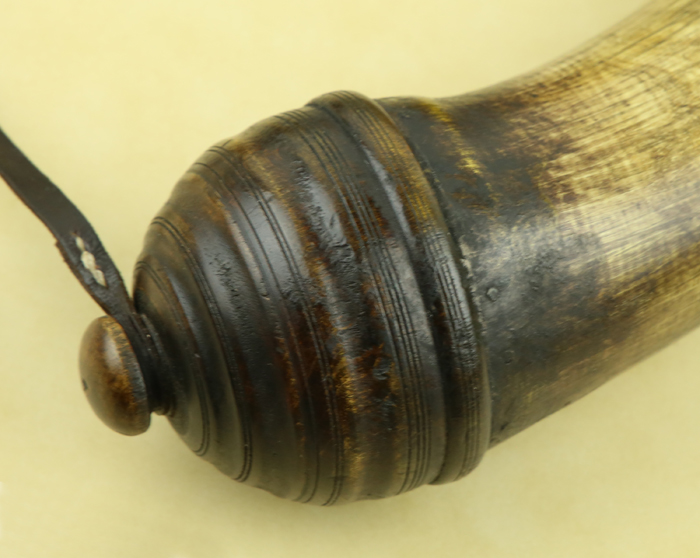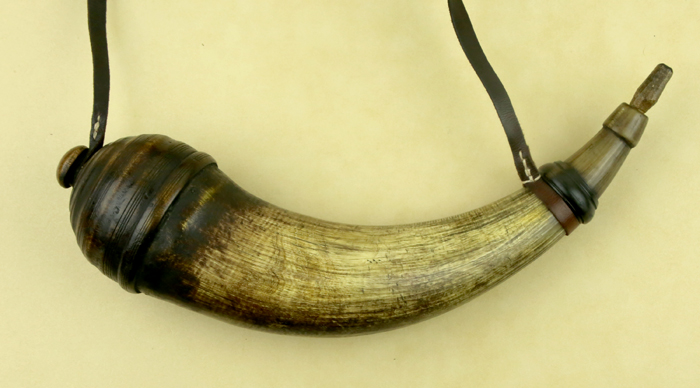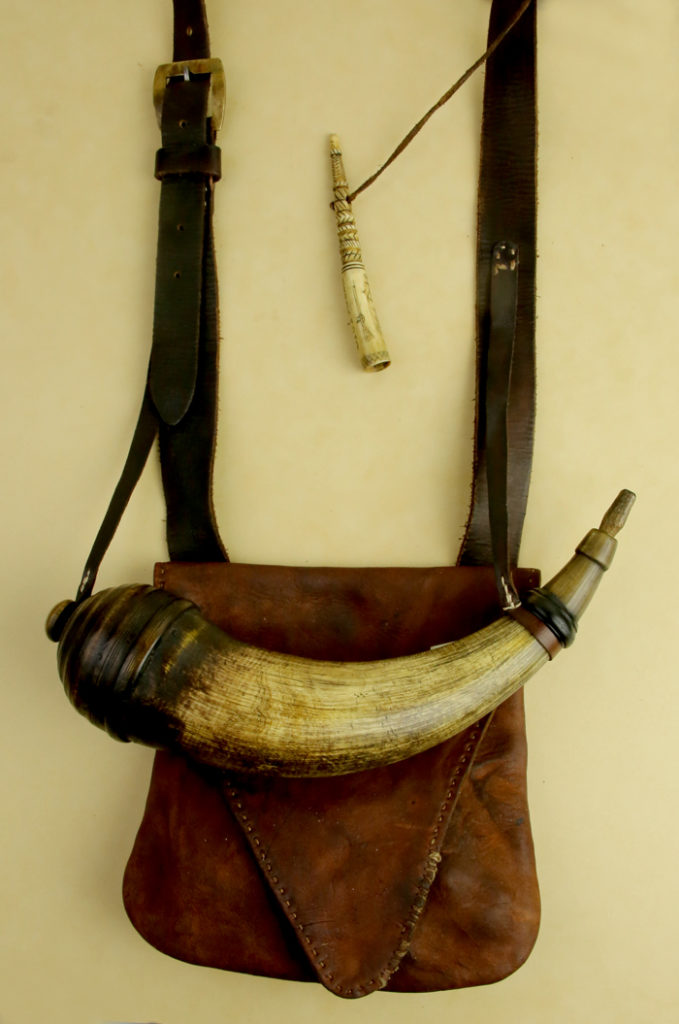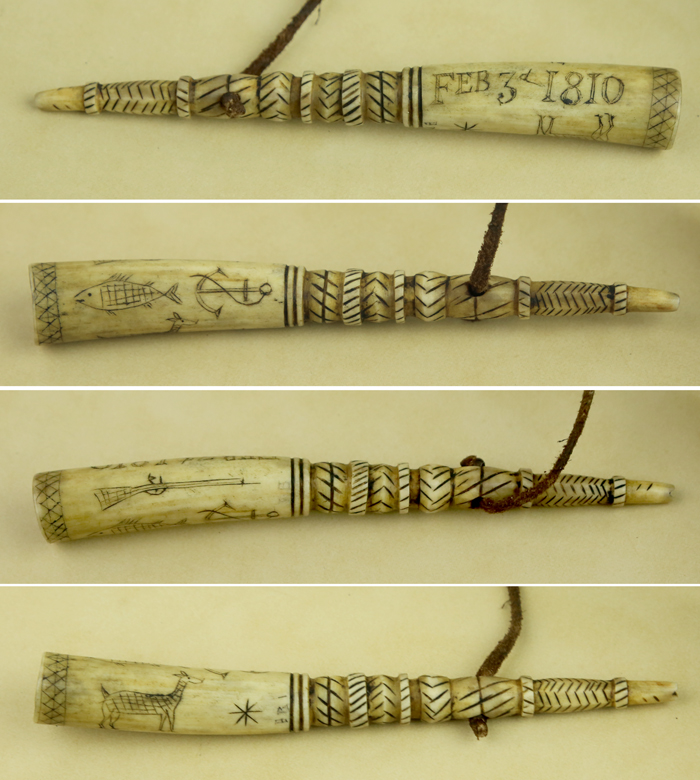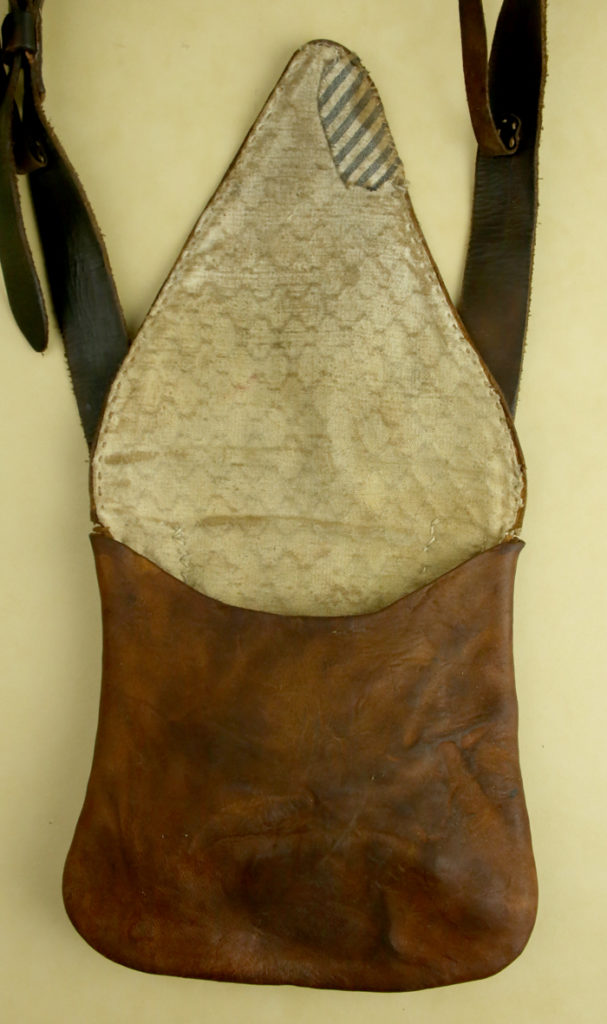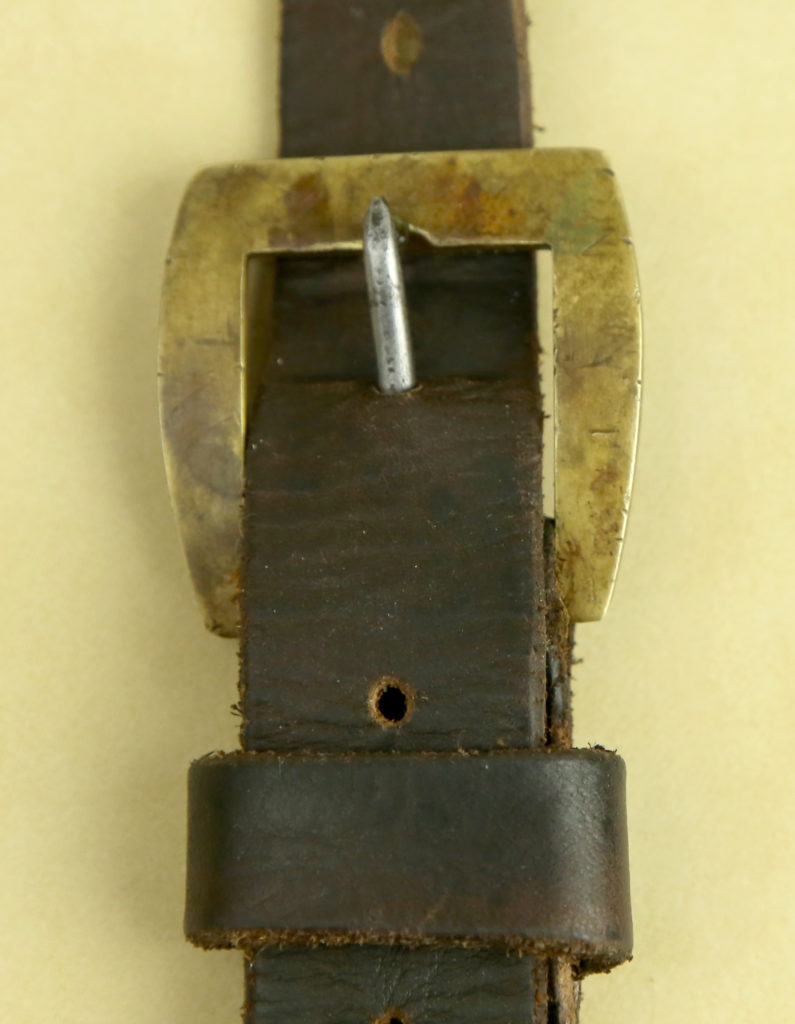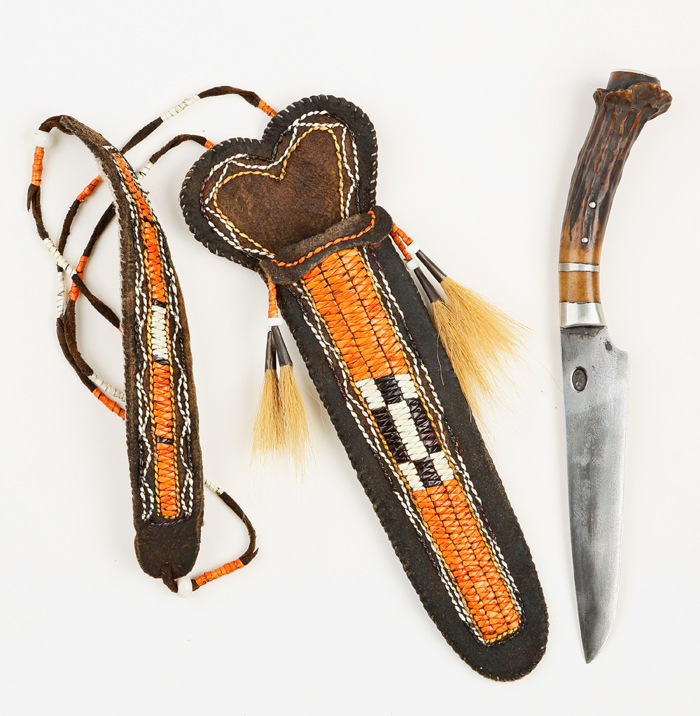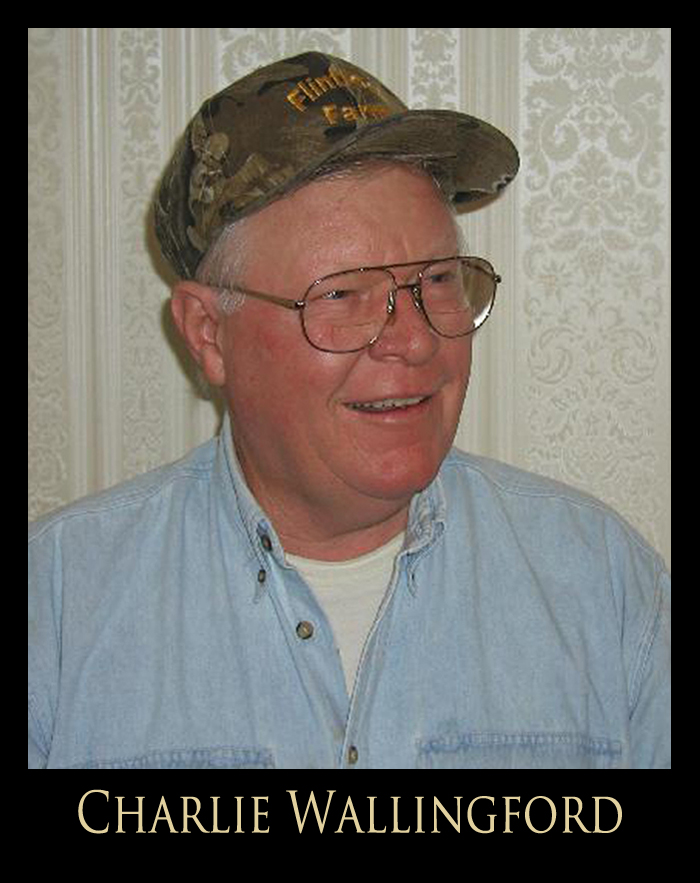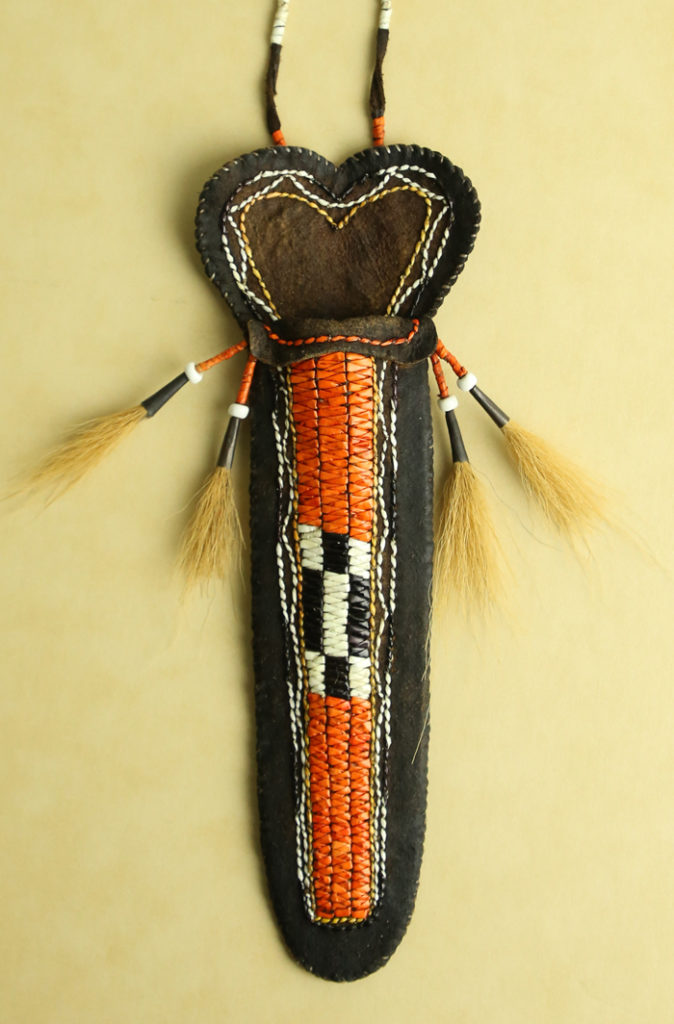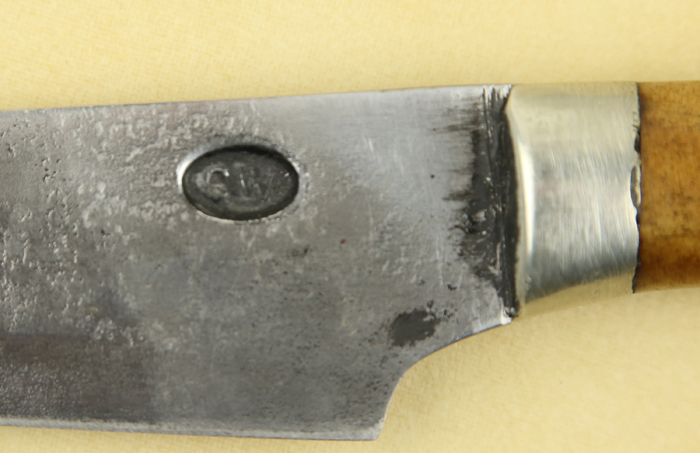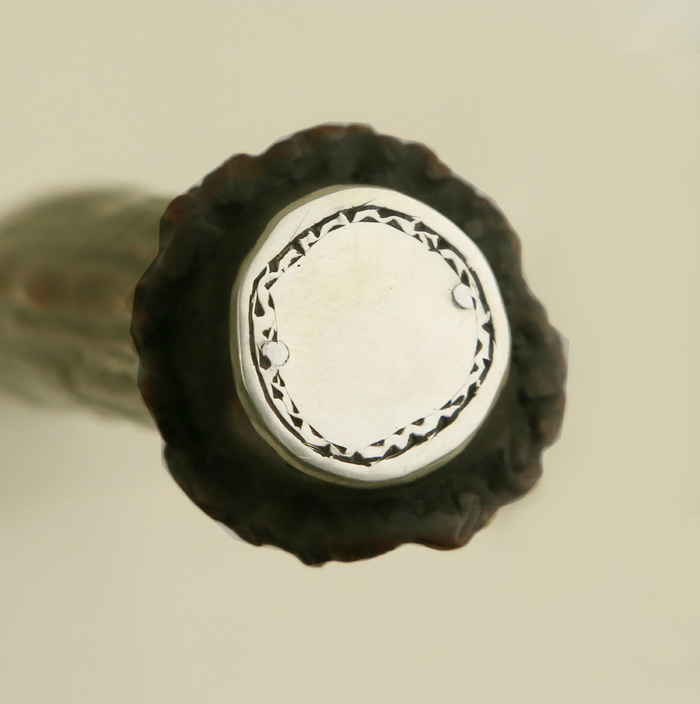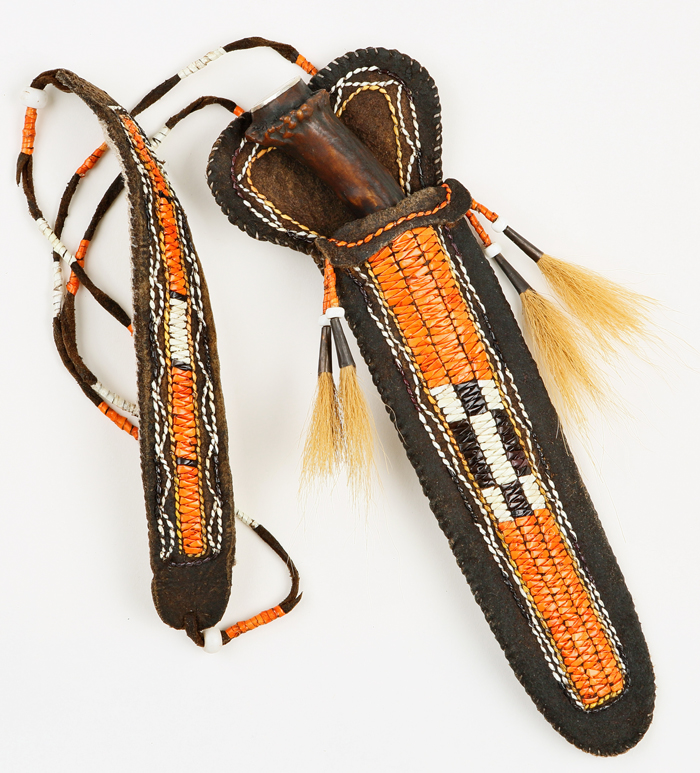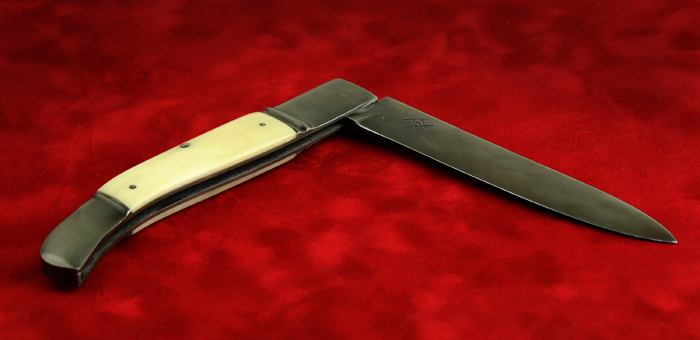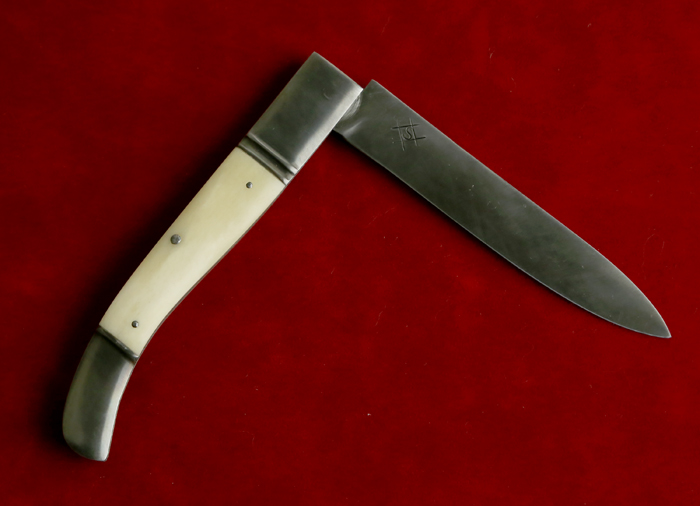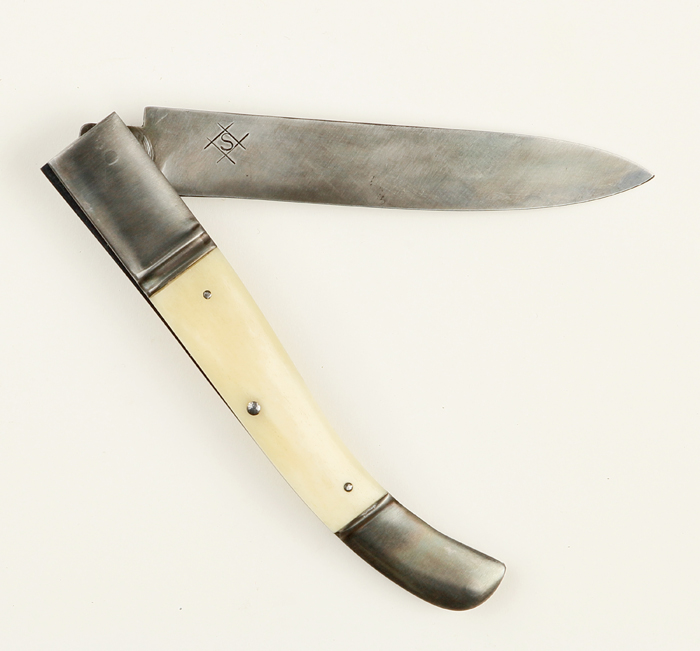Here is a list of items at the CLA auction taking place August 16th at 5:00 P.M. in the Grand Ball Room of the Lexington Convention Center, 400 Vine Street, Lexington, Ky. After examining an item use the back button to return to the list.
Category: CLA 2019
-
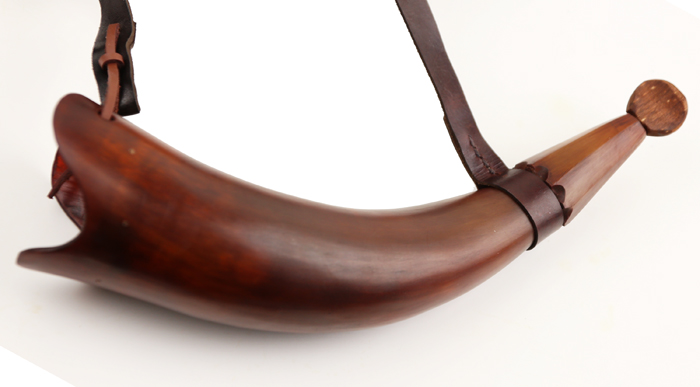
CLA 2019 Auction: Lobed horn and hunting bag by Tim Crosby and Marc Hamel
Lobed horn and hunting bag by Tim Crosby and Marc Hamel
Tim Crosby and Marc Hamel teamed up to create a superb colonial era bag and horn set for this year’s CLF fundraising auction. The architecture of Hamel’s cowhide hunting bag is inspired by an eighteenth century engraving that depicts a rifleman wearing a similar bag. The bag is made from 2-3 ounce cowhide, tooled and dyed by Hamel. The main flap is 4-5 ounce cowhide, and the saddle stitching is waxed linen. The welt, edge binding and internal pocket are soft cowhide. The bag is 11” wide at the widest, 8” wide at the top, and 8” tall.
Crosby’s 10-inch-long lobed horn is about 12 ½” around the outside curve. The horn is ornately decorated with a paneled and scalloped tip, and is fitted with a pine base plug. Crosby imparted a warm patina to this piece, using his own custom blend of dark dyes followed by dark brown oil-based leather dye while the horn was still hot from the color bath.
The entire set comes complete with a flint accessory kit by Crosby. The horse-tail brush and the pick handle are from lathe-turned cow horn tips. The pick itself is copper to minimize touch-hole damage. The powder measure is also horn, and has eight panels. The accoutrement hangers were made from iron clock chain, and attach to the strap via a copper “octopus”hanger attachment.
For more information on the work of the artists, contact them directly at:
Tim Crosby: ccrosby004@columbus.rr.com
Marc Hamel: bodneytower@gmail.com
Larry Pletcher, editor
-

CLA 2019 Auction: Classic patch knife by Verlin Cossel
Classic patch knife by Verlin Cossel
Every blackpowder shooter needs a dependable patch knife in his kit, and this year’s CLF fundraising auction will afford attendees the opportunity to own a truly fine example by knifemaker Verlin Cossel.
Cossel’s patch knife is an evocative classic that conjures images of the early American frontier. Starting with reclaimed steel from an antique hay rake tine, Cossel handcrafted the blade at the coal forge in his home workshop. The blade is fitted in its tastefully-aged antler handle with a German silver pin, and sports a hand-cast pewter end cap. Cossel’s knife will also see double duty on the range: the base of the antler handle is fitted with a handy bullet starter.
The sheath for this piece is ruggedly appealing. The blade itself is cradled in an inner rawhide sleeve. The body of the outer sheath is handcrafted from walnut-dyed deerskin and is entirely hand-sewn.
Cossel’s utilitarian blade comes complete with a unique display stand suitable for home or office. The stand, which accommodates both the knife and the sheath, is made from apple and nectarine branches held by a nicely-patterned spalted hackberry base.
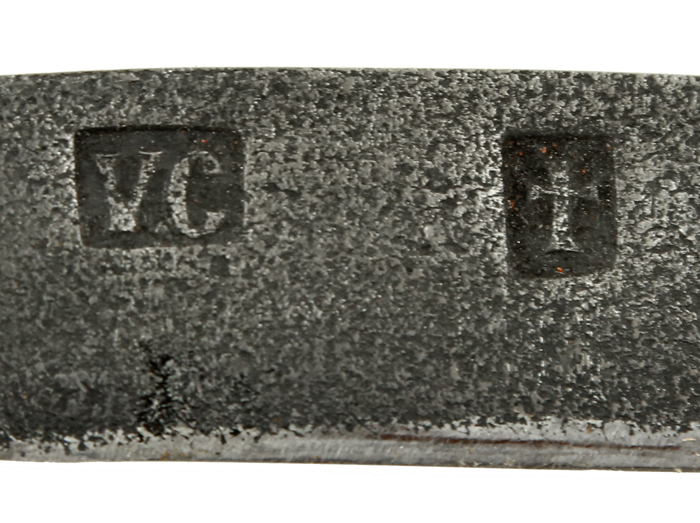 For more information on the work of Verlin Cossel, contact the artist directly at: verlin@hotmail.com
For more information on the work of Verlin Cossel, contact the artist directly at: verlin@hotmail.comLarry Pletcher, editor
-

CLA 2019 Auction: .54 Caliber Gentleman’s Pistol by Ken Stanley and Chuck Edwards
.54 Caliber Gentleman’s Pistol by Ken Stanley and Chuck Edwards
Few weapons capture the artistic grandeur of the flintlock era quite like a refined gentleman’s pistol, and this year the CLF is pleased to present a truly stunning example by gunsmiths Ken Stanley and Chuck Edwards.
Inspired by a pistol originally created by Pennsylvania’s legendary Kuntz family of gunsmiths, Stanley created this exquisite handgun around a .54 caliber, 10 3/4”, rifled barrel, stocked in curly maple. Stanley entirely scratch built the sterling silver furniture for this piece, including the nose cap, thimbles, and trigger guard.
Chuck Edwards lent his considerable talents in finishing this piece, engraving the barrel and furniture and checkering the grip. Edwards finished the pistol with aquafortis stain and a hand-rubbed oil finish. The original Kuntz pistol’s lock was engraved “Ashmore Warranted”; in a fitting homage to the modern lock’s maker, Edwards engraved the lock on this pistol with the words “Chambers Warranted.”
A remarkable combination of elegant lines and fine craftsmanship, Ken Stanley and Chuck Edwards’ gentleman’s pistol is nothing short of a masterpiece of the gunsmith’s art.
For more information on the work of the artists, contact:
Ken Stanley: bakcntryrider@live.com
Chuck Edwards: wipingstick@msn.com
Larry Pletcher, editor
-

CLA 2019 Auction: Early American hanging shelf by Patrick Thevenow
Early American hanging shelf by Patrick Thevenow
While most blackpowder enthusiasts are outdoorsmen by nature, even the most die-hard frontiersman enjoys the comforts of home. For this year’s CLF fundraising auction, artist Patrick Thevenow has donated a fine piece of reproduction home décor that’s sure to tastefully complement a wide range of design schemes.
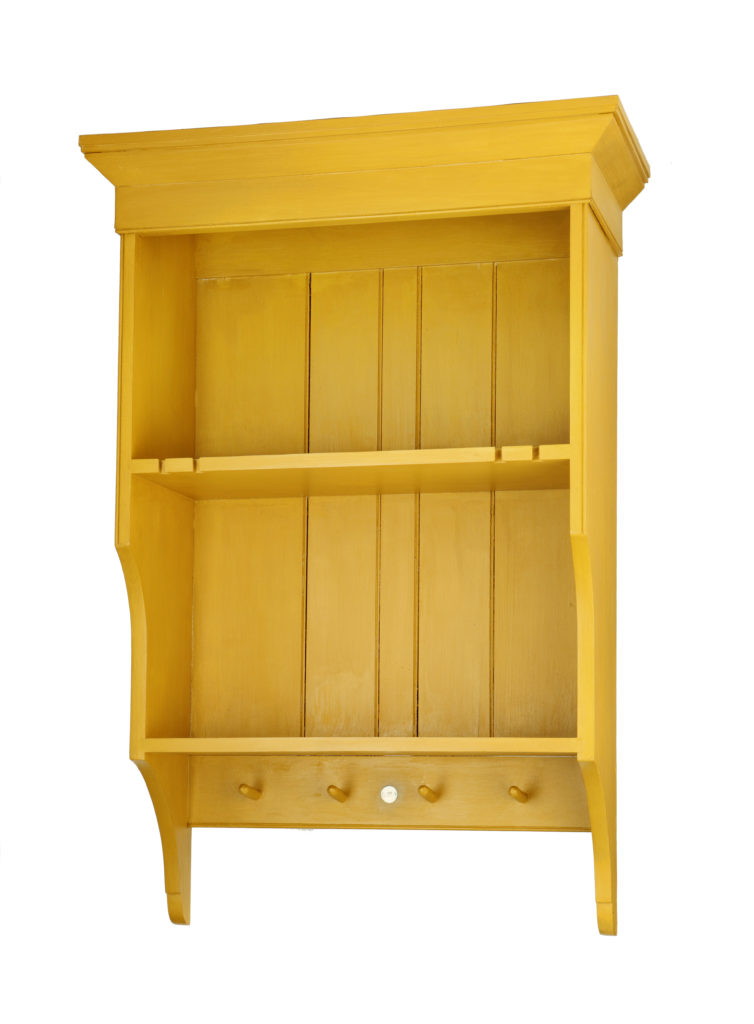
Thevenow’s hanging wall shelf is inspired by an original set of built-in cupboards constructed by an Indiana cabinetmaker circa-1818. Fittingly enough, the piece is constructed of solid tulip poplar, the state tree of Indiana. The shelves are solidly fitted to the body of the cabinet with dado joints, and period fasteners, including original wrought iron nails and slotted screws, were used where appropriate. The artist finished the piece with multiple coats of mustard-colored milk paint and then applied a clear finish for durability and washability.
“The CLA has given me the opportunity to develop friendships with so many wonderful artists,” explains Thevenow. “The more I’ve learned from these folks, the more comfortable I’ve felt spreading my own artistic wings and developing my own skills in woodworking, gun building, and blacksmithing…this is my humble contribution to support a group that continues to keep this art alive.”
For more information on the work of Patrick Thevenow, contact the artist directly at: pthevenow@gmail.com
Larry Pletcher, editor
-
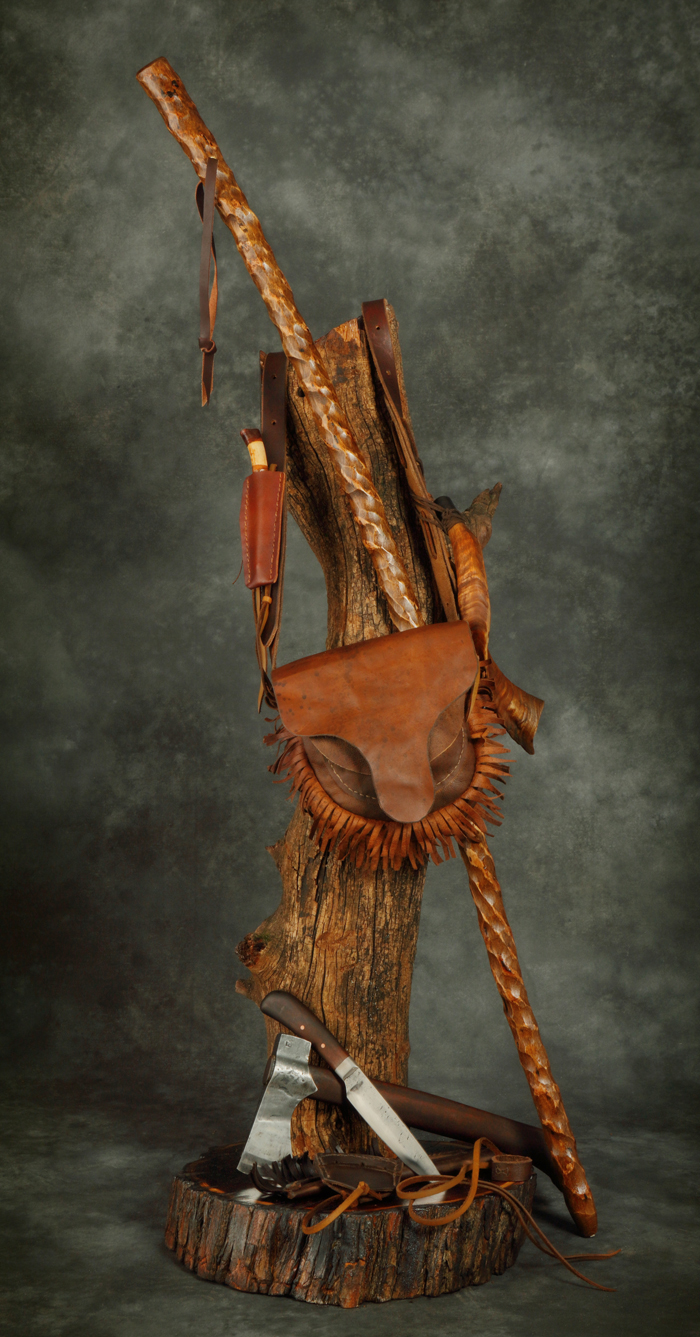
CLA 2019 Auction: Ozarks Trekker by Marty Overstreet, Joel Coash, O.J. Stone, and Paul Fennewald
Ozarks Trekker by Marty Overstreet, Joel Coash, O.J. Stone, and Paul Fennewald
A truly unique offering in this year’s CLF fundraising auction, the Ozarks Trekker set is the collaborative creation of four Missouri artists and constitutes a superb decorative display for the home. This collection pays homage to Henry Rowe Schoolcraft, who explored the Ozarks over the winter of 1819 and later published an account of his journey.
O.J. Stone hand forged a classic frontier hunting knife from 1095 carbon steel, and fitted the blade to a hard maple handle. “The style,” Stone explains, “is somewhat similar to a rifleman’s knife, in a more usable size.” For the head of the hammer polled belt axe, Stone selected 5160 steel, and again used hard maple for the handle. He finished both handles with successive coats of stain, followed by application of a brown leather dye and hand rubbed oil.
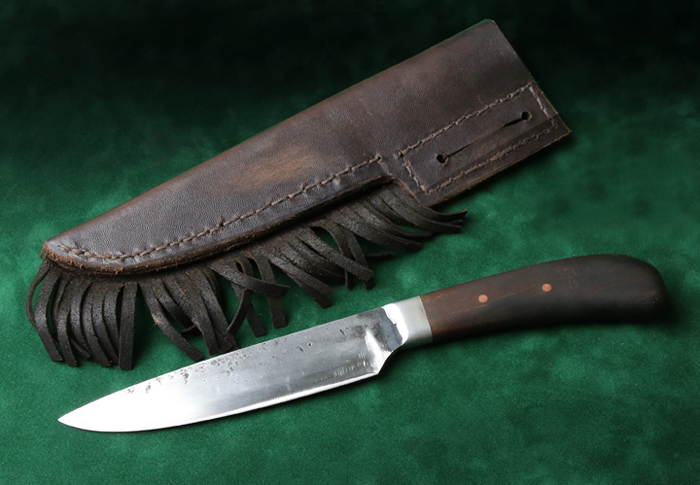
This set comes complete with all the necessary accessories. Marty Overstreet crafted an attractive fringed leather possibles bag. Joel Coash hand carved a deeply-textured walking stick, fit for a trekker of any century, out of Missouri sassafras. Paul Fennewald contributed a hunting horn he made from a goat horn, with a turned cow horn mouthpiece, a turkey wing bone call, and handy sewing, fire making, and fishing kits. Fennewald also included a handmade journal with a port-a-crayon to keep track of one’s journey, as well as an original “Ozark mouth harp” to entertain one’s self sitting around the campfire at night. To showcase the entire set, Fennewald crafted a custom display stand made from osage orange.
For more information on the work of the artists, contact them directly at:
Marty Overstreet: marty@circlebar-t.com
Joel Coash: woodrow70@hotmail.com
O.J. Stone: ojstone@centurytel.net
Paul Fennewald: pfennewald@gmail.com
Larry Pletcher, editor
-
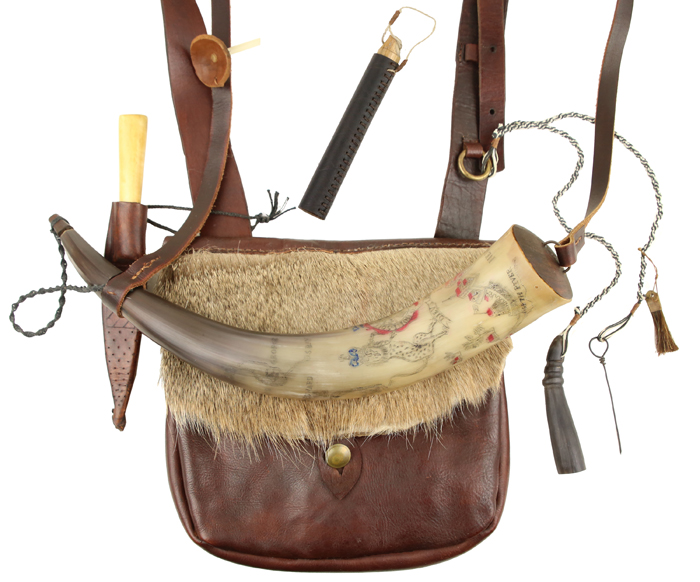
CLA 2019 Auction: by Jack Weeks, Rick Lorenzen and John Leach
1760’s Hunting Rig by Jack Weeks, Rick Lorenzen and John Leach
Jack Weeks and Rick Lorenzen have partnered once again and the result is a bold bag and horn set. They are both artists and craftsmen who continuously research early American history and the evolution of hunting accoutrements. This is the fourth year the guys have been collaborating using 18th century materials and techniques. They want this handsome rig to be loved and used by a contemporary hunter who will pass it down as a family heirloom.
Jack has selected a roomy, square bag that provides plenty of space for all your hunting and shooting equipment for a day in the field. Drawing on his 25 years of hand-making period-correct bags and accoutrements, he’s selected a vegetable-tanned cowhide piece, with a hair-on, white tailed deer flap. This bag is entirely hand-dyed and hand-stitched with linen thread. The hide strap reflects the attention to detail a harness maker would have employed in the mid-1700’s. Even the brass hardware has been aged. All the leather has been hand-finished with homemade Michigan bear oil and buffed with beeswax. And just to be sure you’ve got it all, Jack added his handmade leather musket ball case and a funnel made from leather and a goose quill to fill Rick’s horn. A pan brush and hand-braided cordage provided by Brandenburg Storehouse top off this fine hunting rig.
Rick’s 1760’s-era polychrome scrimshaw horn depicts all the important French and Indian War forts and towns along the Hudson and Mohawk Rivers. Schenectady, Albany and New York cities are there along with a sailing vessel, churches, flags and a windmill. The red roof details are stunning. A blue-crowned three-inch-tall lion and unicorn grace either side of the Royal coat of arms of Great Britain on the inside curve. This is a beautiful left hand carry that snugs right up to your side. Rick has developed his art over 34 years as an accomplished horner and it shows in this one-of-a-kind piece of art. And just as an added touch, Rick included a handmade horn 80 grain powder measure and a wire vent pick.
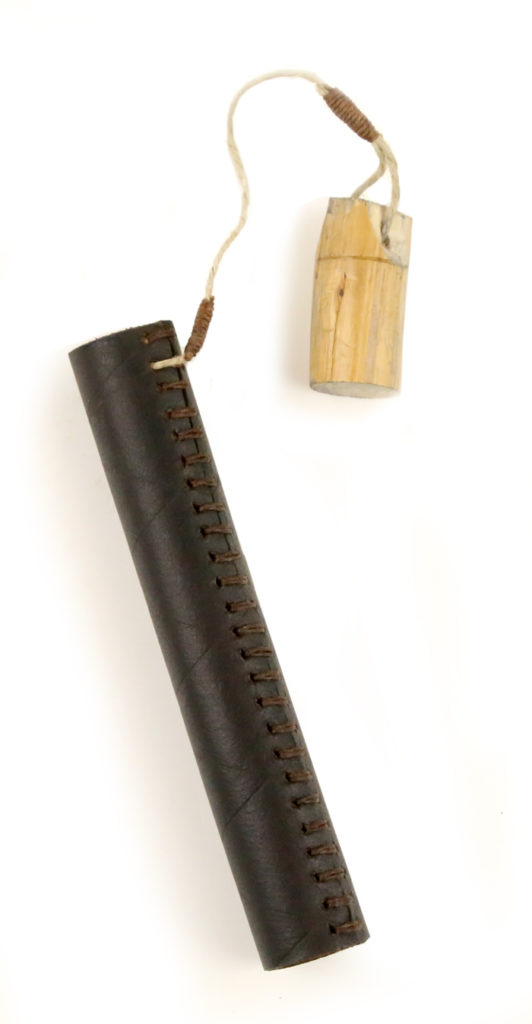
John Leach has added a very well made patch knife of 1095 steel hafted with a box elder handle and paired with a vegetable tanned, center-seam leather sheath.
For more information, contact the artists directly:
Jack Weeks, jlwweeks@gmail.com
Rick Lorenzen, rickpsalm91@gmail.com
John Leach,demessenmaker@gmail.com
-
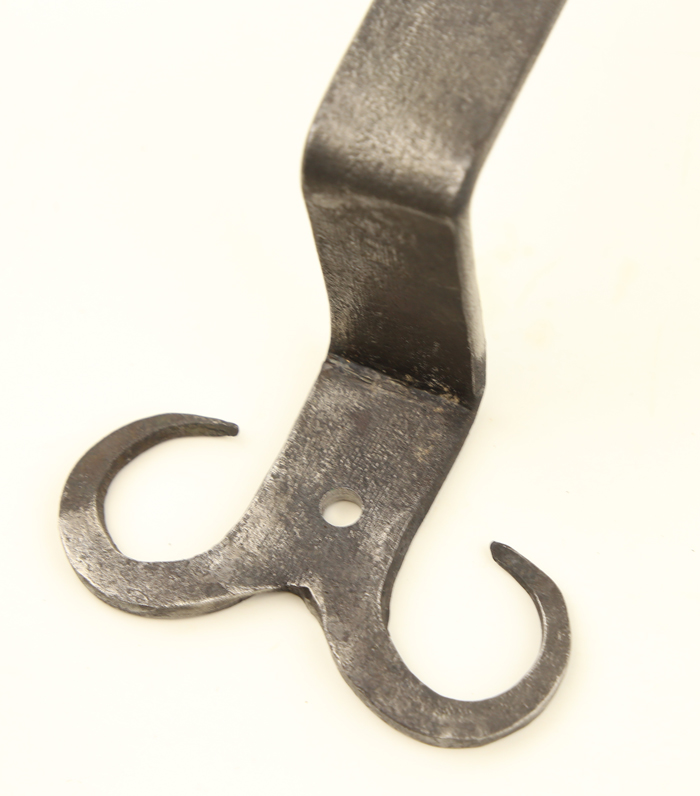
CLA 2019 Auction: Hand-forged hearth cooking set by Greg Bray
Hand-forged hearth cooking set by Greg Bray
For many early American history enthusiasts, living with a tangible connection to the past can be a way of life. This year’s CLF fundraising auction will feature a delightful set of cooking utensils that will be equally at home around a campfire or in a 21st century kitchen.
Blacksmith and CLA member Greg Bray has crafted a full set of hand-forged cooking implements based on original 18th century examples. The set includes a ladle, a serving or cooking fork, a key hole spatula, and a skimmer. All the tools were forged from mild steel and the skimmer has a brass bowl attached with rivets. The hanging bar for the set is adorned with ram’s horn finials. True to the example of most 18th century blacksmiths, Bray left these pieces unsigned.
The artist’s experience at the forge is evident in this fine set, which is attractive as well as utilitarian. Bray has been blacksmithing for nearly three decades, and now serves as the executive director of Prickett’s Fort, a West Virginia living history museum that recreates life on the early frontier.
“The CLA,” says Bray, “is vital in perpetuating the history and the importance of the early craftsmen in the building of our nation. The CLA allows todays modern-era craftsmen and women to be able to have a venue to show their talents and to carry on the traditions of the early craftsmen.”
For more information on the work of Greg Bray, contact the artist directly at: director@prickettsfort.org
Larry Pletcher, editor
-
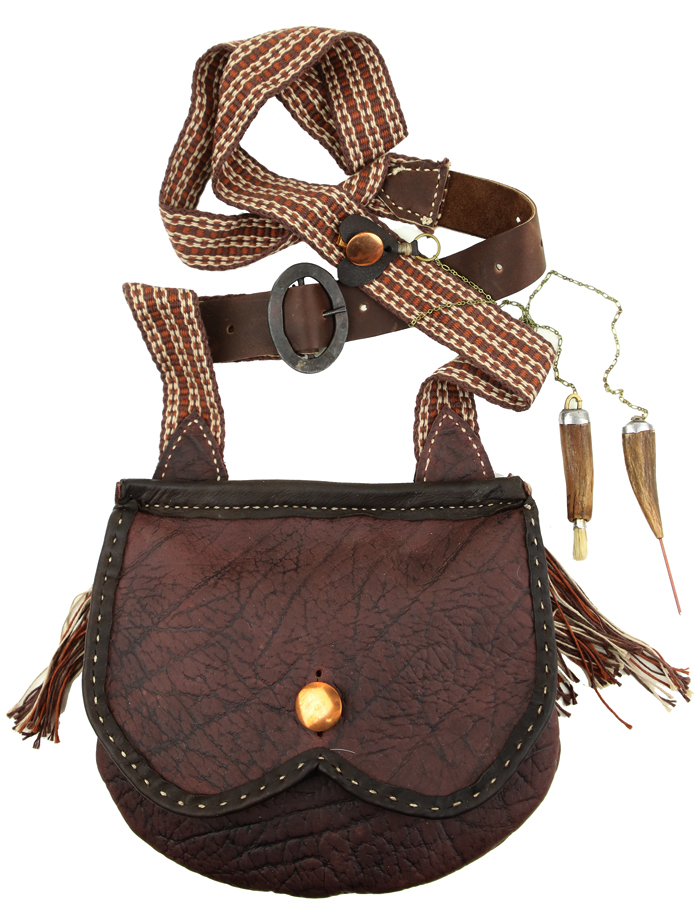
CLA 2019 Auction: Possibles bag by Gary Tingler
Possibles bag by Gary Tingler

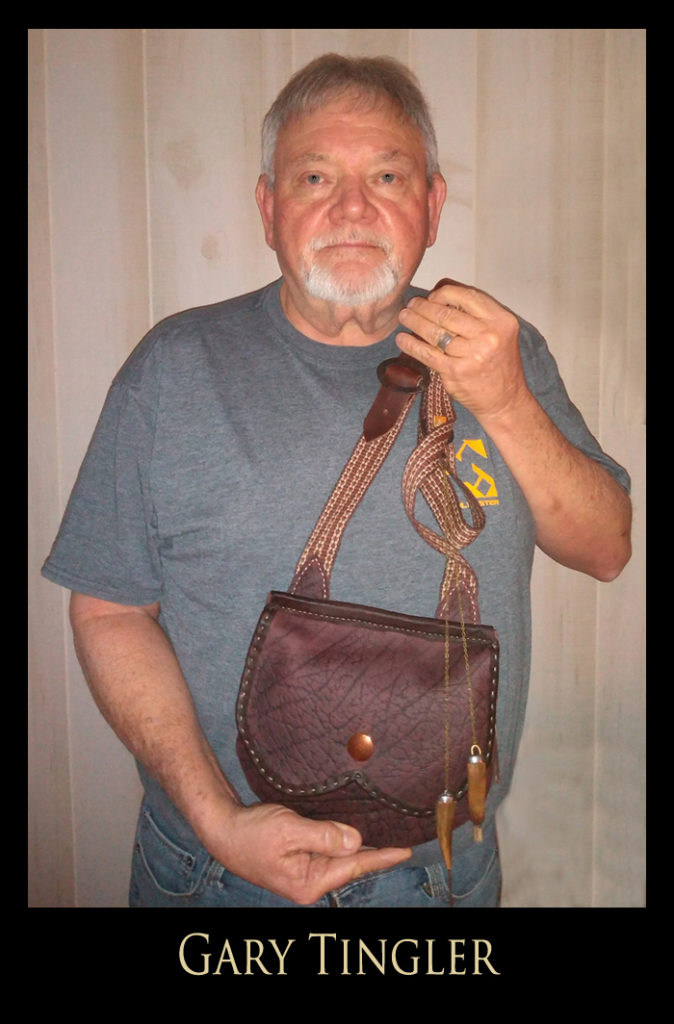 Faithful CLA supporter and skilled craftsman Gary Tingler has created another outstanding hunting bag for this year’s CLF fundraising auction. This piece is a gracefully proportioned possibles bag entirely hand-crafted from hard-wearing buffalo leather, with edges bound in deerskin. The bag, graced with a rich brown patina, has a handy inner pocket, and comes complete with a pewter-capped pick and brush set handmade by Tingler. The bag, which is entirely handstitched in waxed linen thread, is paired with an appropriately matched hand-woven strap by noted artisan Kris Polizzi. The strap, fitted with a forged iron buckle and oil-tanned leather tongue, is fully adjustable.
Faithful CLA supporter and skilled craftsman Gary Tingler has created another outstanding hunting bag for this year’s CLF fundraising auction. This piece is a gracefully proportioned possibles bag entirely hand-crafted from hard-wearing buffalo leather, with edges bound in deerskin. The bag, graced with a rich brown patina, has a handy inner pocket, and comes complete with a pewter-capped pick and brush set handmade by Tingler. The bag, which is entirely handstitched in waxed linen thread, is paired with an appropriately matched hand-woven strap by noted artisan Kris Polizzi. The strap, fitted with a forged iron buckle and oil-tanned leather tongue, is fully adjustable.Born and raised in the mountains of West Virginia, Tingler has had a love for history and muzzleloading rifles since childhood. A leather worker with thirty years of experience, Tingler notes that “the love of the hobby has never lost interest” and he continues to hone his skills in the craft. “It’s not only a hobby,” he points out, “but a love of labor in creating these items of our heritage from long ago.”
For more information, contact artist Gary Tingler directly at: treeingwalkers@hotmail.com
-

CLA 2019 Auction: Antler handled frontier knife by Glen Mock
Antler handled frontier knife by Glen Mock
Modern outdoorsmen are in perpetual need of a reliable knife, and collectors can do no better than a blade by prominent knifemaker Glen Mock. A renowned bladesmith and faithful supporter of the CLF fundraising auction, Mock donated a classic frontiersman’s knife to this year’s event.
Mock’s blade was painstakingly hand forged from 1084 steel and fitted to a traditional antler handle. The handle is decorated with a hand-cast pewter bolster and a German silver end cap. The knife comes complete with a custom, hand-dyed leather sheath.
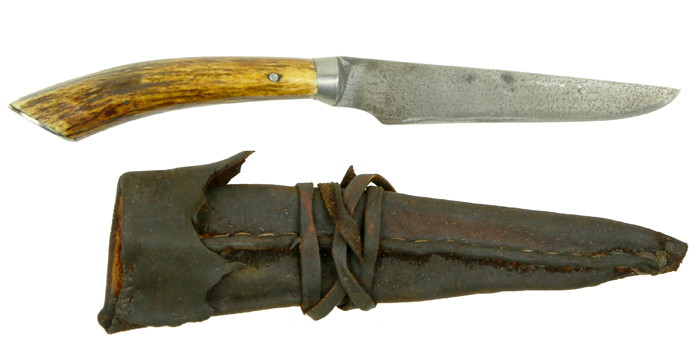
For more information on the work of the artist, contact Glen Mock at: mock@grm.net
Larry Pletcher, editor
-

CLA 2019 Auction: Polled Tomahawk and Sheath by Simeon England, Kyle Willyard, and Shelly Gier
Polled Tomahawk and Sheath by Simeon England, Kyle Willyard, and Shelly Gier
A collaborative effort by Simeon England, Kyle Willyard, and Shelly Gier, this tomahawk is heavily based on England’s research into early belt axes, referred to as “polled tomahawks” in the period, carried by backcountry frontiersmen. Though a bit more refined than what would commonly be seen on the frontier, the engraving and level of finish are similar to many existing examples of pipe tomahawks made by colonial gunsmiths.
England and Willyard worked together in forging the tomahawk, which has a punched eye and hammer welded bit of high carbon steel. They finished the head with a light polish and decorative file work. The head is hafted to a long, slender, and slightly curved hickory handle. The entire tomahawk has been given a light, aged finish. Willyard engraved the tomahawk with a moon, floral designs, and a sunburst that reflect the same theme Shelly Gier used for the leather carrier.
Gier crafted the sheath with a rising or setting sun, depending on the wearer’s perspective. It features three colors with delicate red scallops as a welt and strap contrast. The sheath is formed to the axe. On the strap is a signed brass buckle.
For more information on the work of the artists, contact them directly:
Simeon England: simeonengland@gmail.com
Kyle Willyard: kyle@olddominionforge.com
Shelly Gier: shellycamps1790@gmail.com
Text by Simeon England
Larry Pletcher, editor
-
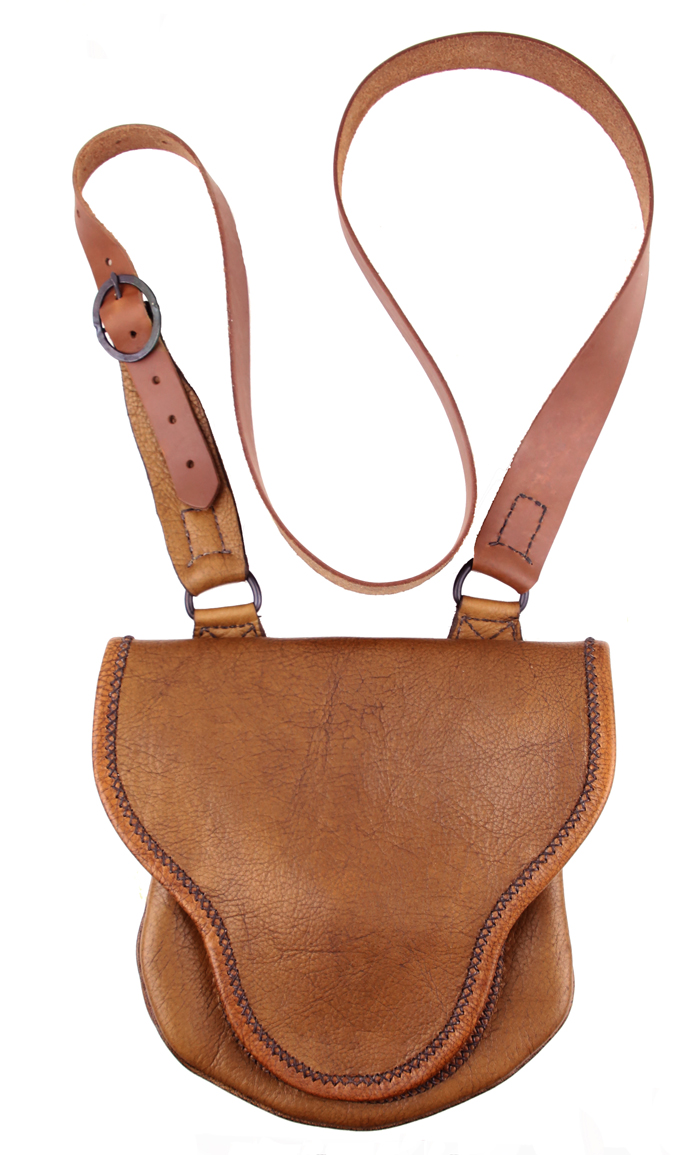
CLA 2019 Auction: Double Beaver Hunting Bag by Bill Smith
Double Beaver Hunting Bag by Bill Smith
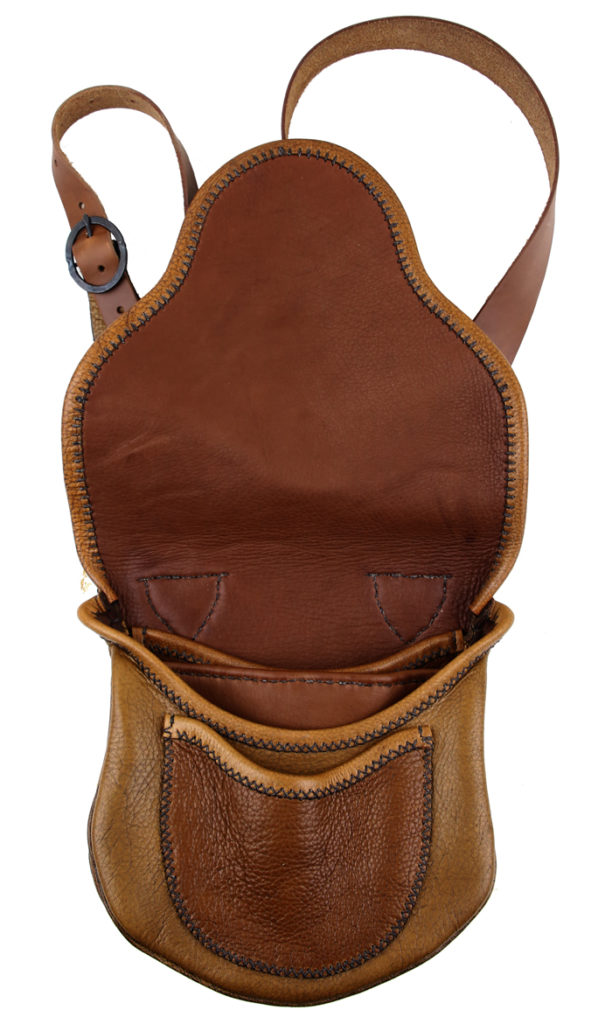 “The hunting pouch,” explains Kentucky artist Bill Smith, “is an icon of the American frontier used in the 18th and 19th centuries.” But the modern frontiersman remains in need of a reliable bag for the woods or the range, and for this year’s CLF fundraising auction Smith has once again donated one of his renowned hunting bags.
“The hunting pouch,” explains Kentucky artist Bill Smith, “is an icon of the American frontier used in the 18th and 19th centuries.” But the modern frontiersman remains in need of a reliable bag for the woods or the range, and for this year’s CLF fundraising auction Smith has once again donated one of his renowned hunting bags.Smith’s bags are widely regarded for their robust functionality, and this piece exceeds expectations. The body of the bag, which is made from hard wearing cowhide and lined with deerskin, is entirely hand sewn with waxed linen thread.
In addition to two roomy compartments inside the bag, there is a pocket on the front and a large interior pocket for additional storage. The heavy leather shoulder strap, about two inches wide, is fully adjustable by means of a hand forged iron buckle.
With three decades of experience, Smith is a longtime auction contributor to the nation’s premier organization for the preservation of traditional frontier arts. “The CLA,” says Smith, “is a great organization dedicated to artists.”
For more information on the work of Bill Smith, contact the artist directly at: wsmithblackpowder@windstream.net
Larry Pletcher, editor
-

CLA 2019 Auction: 1760’s Great Lakes Knife and Sheath Set by Ben Hoffman
1760’s Great Lakes Knife and Sheath Set by Ben Hoffman
 For this year’s CLF fundraising auction, Ohio artisan Ben Hoffman chose to reproduce an original piece made in the Great Lakes region that dates from the 1760’s. True to artist’s exacting standards, both the knife and sheath was entirely hand-crafted.
For this year’s CLF fundraising auction, Ohio artisan Ben Hoffman chose to reproduce an original piece made in the Great Lakes region that dates from the 1760’s. True to artist’s exacting standards, both the knife and sheath was entirely hand-crafted.Hoffman salvaged the steel for the knife blade from an antique buggy spring, which was then hand-forged using a vintage hand-crank-powered coal forge. The basic shape of the blade was crafted using a hammer, tongs and anvil. Most of the final shaping was done by hand filing.
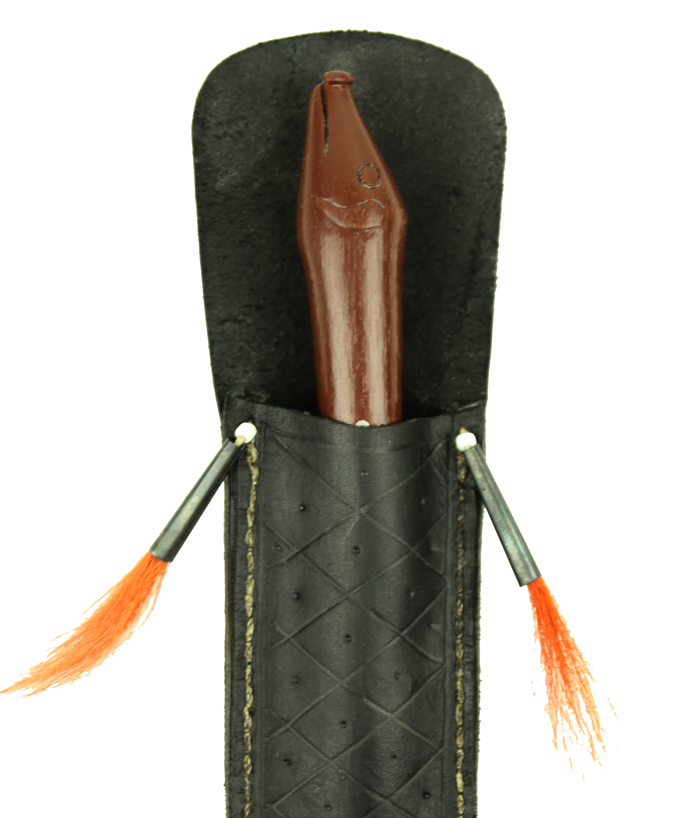
The handle was entirely hand-carved in maple and given a rich finish of period-correct milk paint and linseed oil-based varnish. The sheath, which was made from oak-tanned cow hide and treated with a period-correct black leather dye, was hand cut and sewn using linen thread. All the tooling was done by hand.
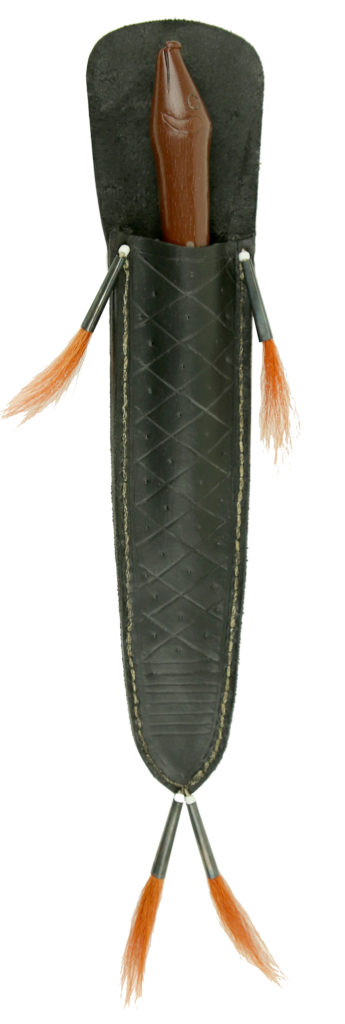 The sheath is adorned with white trade beads and tin cones, which were present on the original, and the decorative deer hair tassles were dyed with madder root, an authentic 18th century material. This stunning knife and sheath set would be a great display piece for the 18th century collector, but would also serve well in the field. “As with all the knives I make,” says Hoffman, “it has been triple tempered and sharpened to a razor edge. It was made to use.”
The sheath is adorned with white trade beads and tin cones, which were present on the original, and the decorative deer hair tassles were dyed with madder root, an authentic 18th century material. This stunning knife and sheath set would be a great display piece for the 18th century collector, but would also serve well in the field. “As with all the knives I make,” says Hoffman, “it has been triple tempered and sharpened to a razor edge. It was made to use.”For more information, contact the artist directly at: hoffmanreproductions@yahoo.com
Larry Pletcher, editor
-
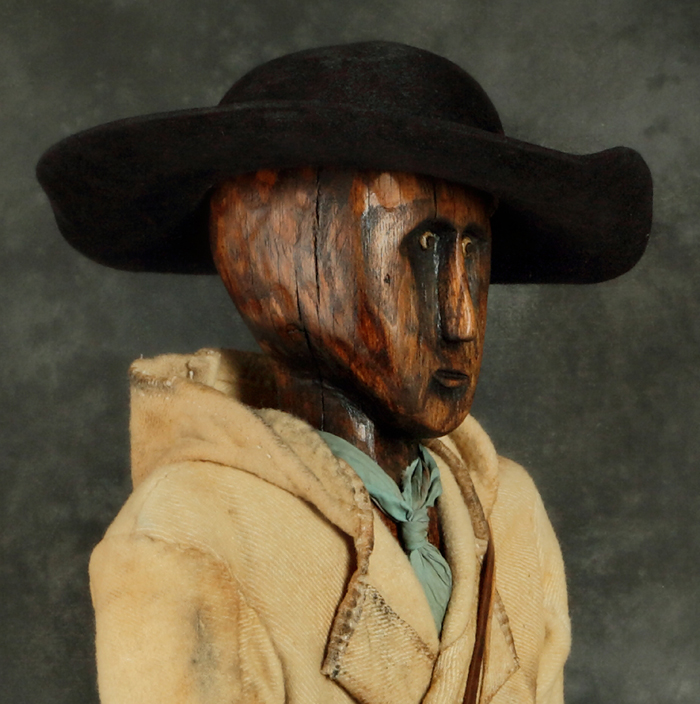
CLA 2019 Auction: Saga of the Longknife
Saga of the Longknife
One of the keystone offerings of this year’s CLF fundraising auction is the collective creation of eight CLA member artists. Christened the Saga of the Longknife by its creators, this piece constitutes a stunning, mixed media sculptural set composed of superbly executed, functional art.
The entire set is created around a folk-art carving by artist Matt Fennewald, who used a mix of woods – including pecan, walnut, and cherry – to assemble the body of the sculpture, which is scaled to the size of a young frontiersman. Affectionately nicknamed “Wilbur” by his creator, the carving was given a hand-rubbed finish of wax, tar, and shellac.
The rifle which accompanies the Saga of the Longknife set was created by gunsmith Josh Wrightsman. Although this rifle is loosely based on original Virginia guns, Wrightsman imparted the finished piece with his own artistic sensibilities. Built around a .40 caliber, 34″ Rice B-weight barrel, this rifle is stocked in walnut and fitted with a Chambers Queen Anne lock. The iron furniture was entirely hand-forged, and beautifully contrasts the richly-finished walnut stock. For a gun builder, Wrightsman was tasked with a difficult balancing act. “The most difficult part about this gun,” he explains, “was that it needed to be a certain size”: small enough to fit a 6-year-old, but simultaneously suitable for a grown man. “I wanted a gun,” says Wrightsman, “that the new owner would want to use every time they went shooting.”
Todd Daggett created the Saga knife, hand forging the blade from an antique buckboard seat spring. The antler handle sports a cast pewter bolster. For optimum strength, the tang is peened over an iron washer as well as pinned. The knife is accompanied with a sturdy sheath crafted from buff hide scraps, hand-stitched with whitetail sinew, and the tip is decorated with antique brass tacks.
Simeon England hand forged the hammer-polled tomahawk based on original eighteenth century examples. “It displays whiting and polishing of a gunsmith or whitesmith,” explains England, and carries file work and facets reflective of original colonial examples. The head of the tomahawk was hand forged out of mild steel, and features a forge-welded, high-carbon steel bit. The handle is made from beautifully patterned curly ash, stained with nitric acid.
Eric Ewing assembled an exceptional shot pouch using a wide array of materials. The bag and strap is made from a mix of skins including bark-tanned groundhog, alum-tanned groundhog, brain-tanned deer, and vegetable-tanned cowhide. Ewing utilized his own homemade concoctions to give this piece a well-aged patina.
“Wilbur’s” powder horn was created by Tad Frei, who describes the piece as a “fancy common man’s horn.” Crafted from a small cow horn, Frei’s piece features charming folk art scrimshaw that “reflects a bit more aesthetic concern than we typically see on utilitarian accoutrements” Fitted with a pine base plug and a tapered spout, Frei’s diminutive horn is appropriately scaled to the Saga set but remains fully functional.
The carving is dressed in period-appropriate garb also crafted by Matt Fennewald. “Wilbur” is dressed in a wool blanket coat, rawhide leggings, and brain-tanned garters. His footwear consists of a set of pucker toe moccasins made by Alec Fourman, who utilized brain-tanned, smoked, and aged deerskin.
The entire Saga set is topped off by a quintessential broad-brimmed frontiersman’s hat by Michael Agee. The hat is round blocked fur felt. Hagee custom made the lathe-turned block, which, he explains, “was done to nearly all hats prior to 1820.” Agee added splash of color with a hat band, which was made from red wool stroud. The hat’s inner lining is made of hand stitched linen, which was then stamped with a period style maker’s mark.
For more information on the work of the artists, contact them directly at:
Matt Fennewald: m.fennewald@hotmail.com
Josh Wrightsman: catfishman1975@gmail.com
Todd Daggett: daggett1655@gmail.com
Simeon England: simeonengland@gmail.com
Eric Ewing: ericewing1746@gmail.com
Tad Frei: tadfrei@yahoo.com
Alec Fourman: alec.fourman@gmail.com
Michael Agee: Michael.agee1780@yahoo.com
Larry Pletcher, editor
-
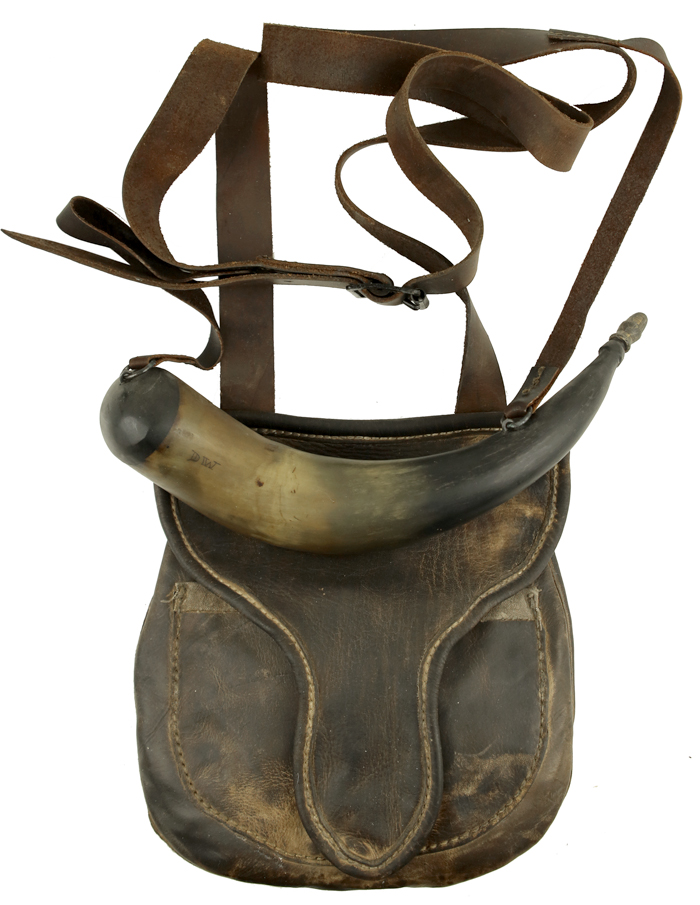
CLA 2019 Auction: Classic beaver tail hunting bag by Doug Warren
Classic beaver tail hunting bag by Doug Warren
One of the most vital pieces of equipment for blackpowder shooters is a rig consisting of a watertight horn and a dependable possibles bag, and this year’s CLA auction will afford bidders the opportunity to own a truly exemplary set by artist Doug Warren.
Warren’s bag is a fine collector’s piece that will be perfectly at home in a display case or in the field. The artist utilized period-appropriate materials for the entire bag. Crafted from 3 ½ oz. deerskin dyed in walnut, the bag has a roomy interior and features the classic styling of a beaver tail flap. Entirely hand-sewn with pure flax linen thread, this well-made bag also sports an additional exterior pocket, situated just under the flap. Fitted with a heavy cowhide shoulder strap and iron buckle, this fully adjustable piece is ready for the woods or the firing line. The bag comes complete with an equally impressive powder horn, which is fitted with a red cedar base plug and a turned maple stopper,
Artist and CLA member Doug Warren is an experienced craftsman who’s been building bags and horns for nearly three decades. His experience as a maker is on full display in this exceptional piece: fine craftsmanship, paired with a subtly distressed patina to the leather, qualifies Warren’s stunning bag and horn set as a museum-quality replica.
For more information on the work of Doug Warren, contact the artist directly at: dougwarren1969@gmail.com
Larry Pletcher, editor
-
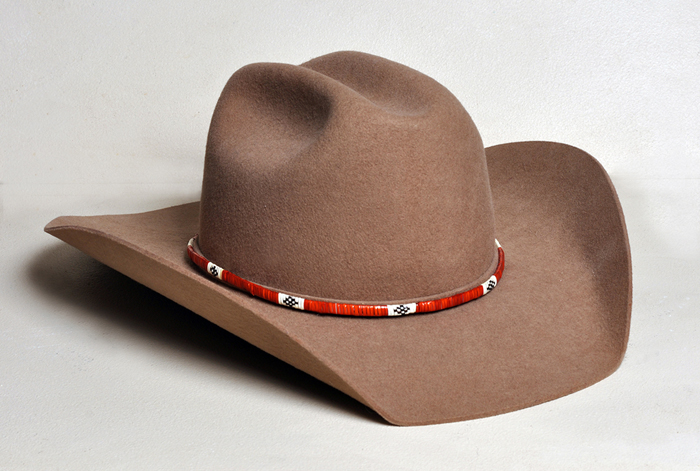
CLA 2019 Auction: Quilled Hatband by Djuana Tucker
Quilled hatband by Djuana Tucker
During the 18th and 19th centuries, no self-respecting gentleman – or scoundrel, for that matter – would consider venturing into public without a hat. For the modern-day frontiersman headed for the range, the rendezvous, or the woods, that hasn’t changed. For those hoping to set their headgear apart from the crowd, CLA artist Djuana Tucker has donated a unique quill wrapped rawhide hatband to this year’s fund-raising auction. Typical of Tucker’s work, the piece is constructed with historically appropriate materials. The artist relied on authentic natural dyes to achieve the color palette: madder root for red and osage orange sawdust, indigo, and madder root to achieve black. The hatband is ¼” wide and 22” long, with a braintanned leather lace on each end, ensuring that the piece will fit any size hat.
One of the premiere quill workers in the nation, Tucker is a regular donor to the CLA auction. Though the artist is firmly grounded in a knowledge of original quillwork, Tucker is a skilled designer in her own right. “I refer to catalogs of museum collections and photographs of original pieces for reference,” she explains, “but I am also inspired by the world around me.” Such an approach affords the artist a good measure of creative freedom. “I tend to focus on design aesthetic and composition rather than perfection in the quillwork pieces I create.”
For further information on the work of the artist, contact:
Djuana Tucker
2539 Angela Drive
Granite City, IL 62040
618-975-8897
Djuana70@yahoo.com
Follow on Facebook
Larry Pletcher, editor
-
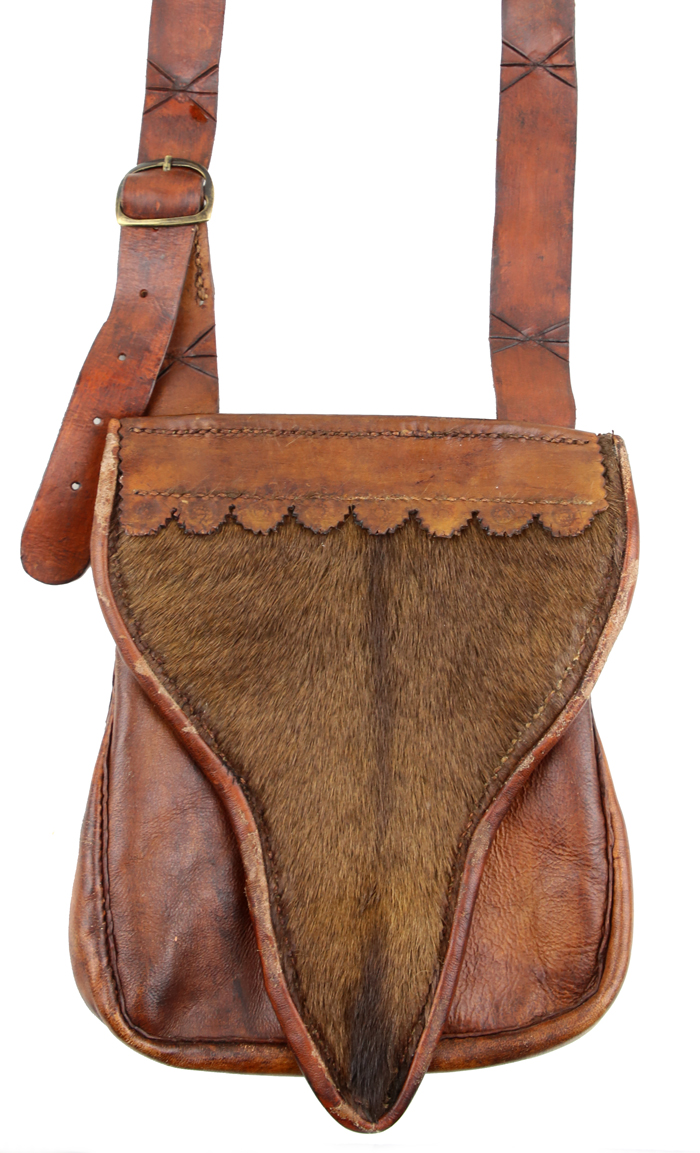
CLA 2019 Auction: Calfskin hunting bag by Chris Crosby
Calfskin hunting bag by Chris Crosby
Chris Crosby’s fine contribution to this year’s CLF auction represents, he explains, “a piece that would have been carried by a man of middling means, to service his smooth rifle or fowler.” The body of the bag is made from vegetable tanned calfskin and the bindings on the flap and at the throat of the bellows panel are bark tanned sheepskin. The bag’s rich coloring was achieved with the artist’s own resourceful mix of crushed willow and oak charcoal, bear oil, clay, water-based dye, pine tar, and beeswax. “I try to achieve colors that are historically accurate,” says Crosby, “with a nice warm, aged patina.”
The bag’s hair-on the flap is calfskin, and the flap lining is a reproduction coverlet remnant, which Crosby explains is intended to represent a “remnant bed covering that would have been hand loomed here in the colonies, and repurposed after many years of good service.” The bag’s strap is robust vegetable tanned cowhide and carries a simple hand tooled motif. The brass half D buckle, Crosby says, “was in common use mid to late 18th century and could easily have been repurposed from prior military service.”
“The CLA,” says the artist, “is a dream come true for me. All my life I have had a passionate interest in the history, the material cultural of the day-to-day lives of our ancestors, and the preservation of the heritage of this great country. The CLA for me is a great way to contribute to the preservation of the culture and history of the greatest nation on earth.”
For more information on the work of Chris Crosby, contact the artist directly at: ccrosby1969@live.com
Larry Pletcher, editor
-
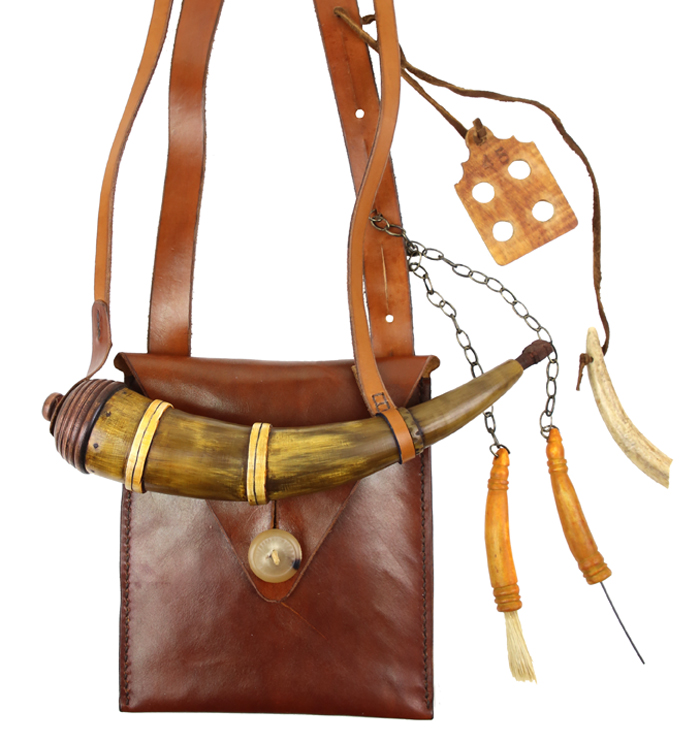
CLA 2019 Auction: Frontier Georgia bag and horn set by Ron Hess and Marc Hamel
Frontier Georgia bag and horn set by Ron Hess and Marc Hamel
CLA members are very often inspired by history in the creation of their art. A 2018 exhibition at the Georgia Museum of Art, which focused on the state’s early gunsmiths, prompted Georgia artist Ron Hess to create this fine bag and horn set for this year’s CLF fundraising auction. The oldest firearm at the exhibition was an 1815 rifle attributed to frontier gunsmith Richard Allen; the Allen rifle is accompanied by an original bag and horn which was duplicated by Ron Hess and Marc Hamel.
Hess tackled the difficult process of creating the horn, skillfully reproducing the intricate southern-styled piece with integrally carved bands and a beehive base plug crafted from dogwood. He completed this collection with a nice set of antler rifle tools and powder measure. Hamel reproduced the bag, which has two interior compartments. Strap adjustment, faithful to the original, is by means of a horn button. Hamel finished the bag with a russet dye and an oil and wax sealer.
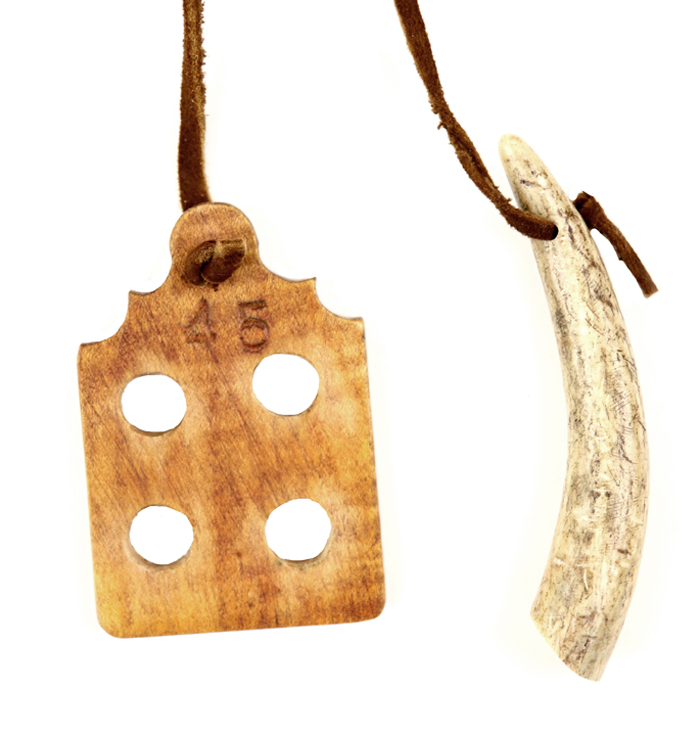

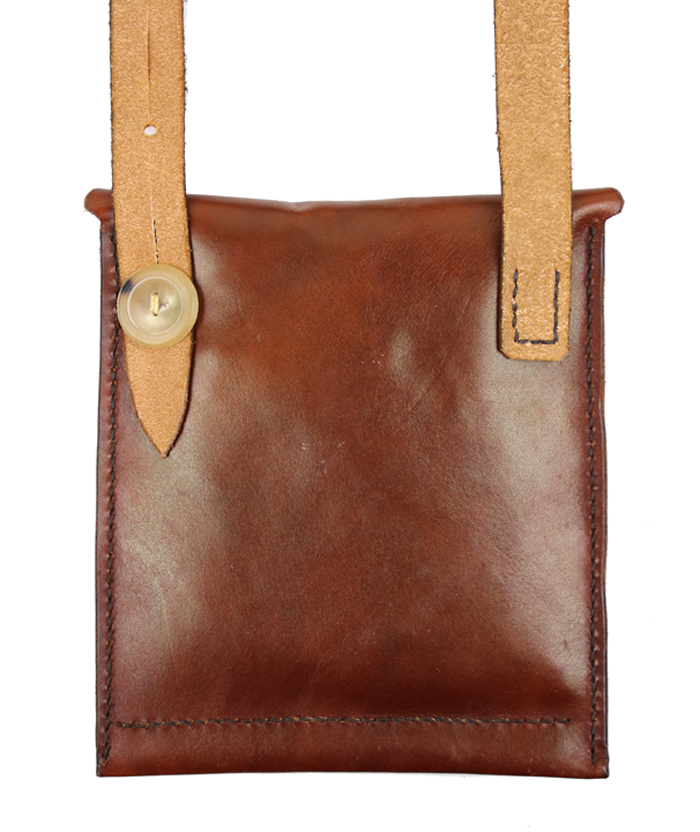 For more information on the work of Ron Hess and Marc Hamel, contact the artists directly at:
For more information on the work of Ron Hess and Marc Hamel, contact the artists directly at:Ron Hess: rjhess1976@plantationcable.net
Marc Hamel: bodneytower@gmail.com
Larry Pletcher, editor
-
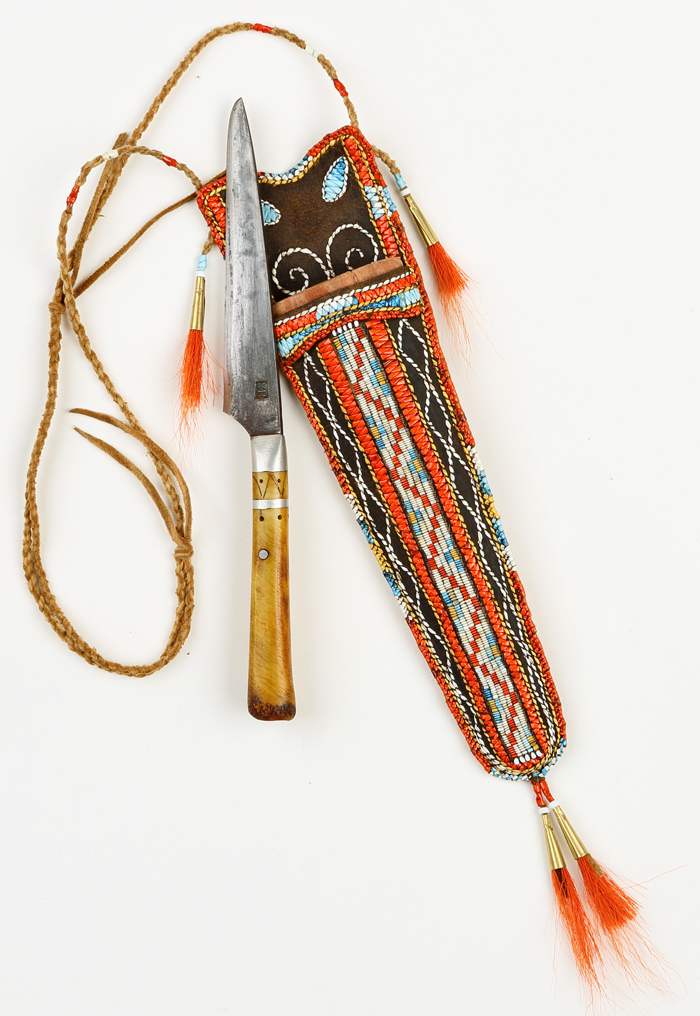
CLA 2019 Auction: Neck knife and quilled sheath by Virgil Henle and Christie Suchora
Neck knife and quilled sheath by Virgil Henle and Christie Suchora
During the Seven Year’s War, French military engineer Pierre Pouchot was intrigued by Native American warriors who habitually wore remarkably decorated knife sheaths as a badge of status. The Indians “always have one suspended round their neck,” explained Pouchot. “Their knife is hung from the neck,” he wrote, “and falls upon the breast…they regard this property as sacred as their children.”
Attendees at this year’s CLF fundraising auction will have the opportunity to acquire a truly outstanding neck knife and sheath by artists Virgil Henle and Christie Suchora. Henle’s knife is a quintessential frontier standard. Hand forged from 1084 steel, the blade is fixed in the leg bone of a young whitetail. The handle is embellished with a decorative ring and end cap of hand-cast pewter, and the artist imparted the bone with an appealing aged patina. Henle handily succeeded in crafting a pleasing but resilient knife that’s ready for work.
The knife is paired with an exceptional quilled neck knife sheath by artist Christie Suchora. The body of the sheath was constructed from brain-tanned deerskin. Suchora’s husband John prepared the hide with a traditional dry scrape method, then heavily smoked the leather to a rich burnt umber hue. The sheath features an inner protective lining of Minnesota birchbark.
Adorning the face of the sheath is Suchora’s quillwork, which can be described as nothing short of a masterpiece of traditional tribal art. Based on an original 18th century example in the collection of London’s British Museum, the sheath’s breathtaking loomed panel features quills colored with period-appropriate dyes, including madder root, sumac, osage orange, and indigo.
The artistic duo of Henle and Suchora has teamed up to produce a stunning work of art that’s destined to become a multi-generational heirloom. “The CLA is amazing,” says Henle, “the annual show is a great place to see old friends and buy handmade items and see original pieces.” But more importantly, the organization is crucial to preserving traditional skills “that might otherwise be lost.”
For more information, contact the artists directly at:
Christie Suchora, quillworkartist@gmail.com
Virgil Henle, vhenle@yahoo.com
Larry Pletcher, editor
-
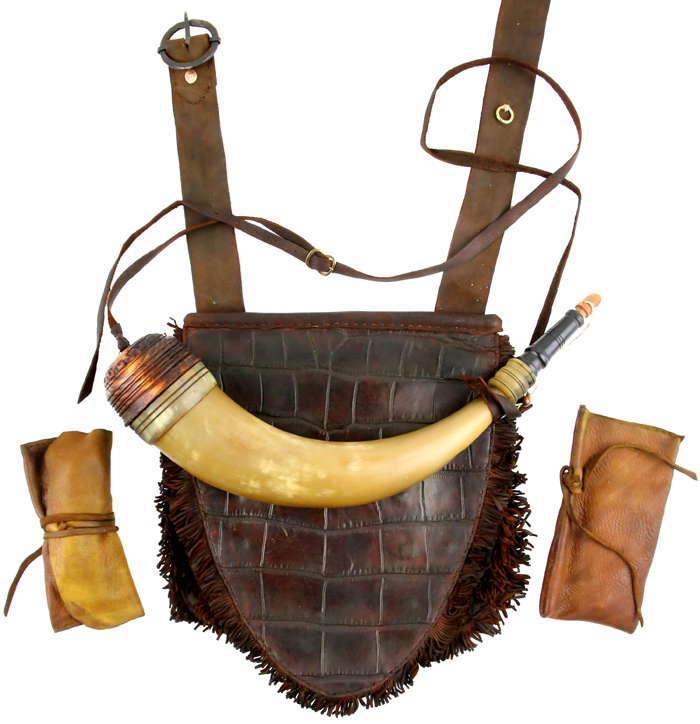
CLA 2019 Auction: Bag and horn set by Tom Greco
Bag and horn set by Tom Greco
Artisan Tom Greco is well known as a maker of distinctive, top-quality frontier art. Not surprisingly, he’s contributed a standout bag and horn set for this year’s CLF fundraising auction. The body of Greco’s unique possibles bag is crafted from goat hide, which is richly colored with a brown leather dye and a sealing coat of grease. The warm color of the bag contrasts nicely with the outer flap, as well as the flap of a smaller pocket, which are made from alligator skin.
Greco stained the matching powder horn with multiple coats of chromic acid. The set comes complete with a hickory ball starter as well as a buffalo horn vent pick and horse hair pan brush, both of which are accented with wooden beads.
For more information on the work of Tom Greco, contact the artist directly at: flintlock52@yahoo.com
(More photos may be available when CLF’s auction page is done.)
Larry Pletcher, editor
-
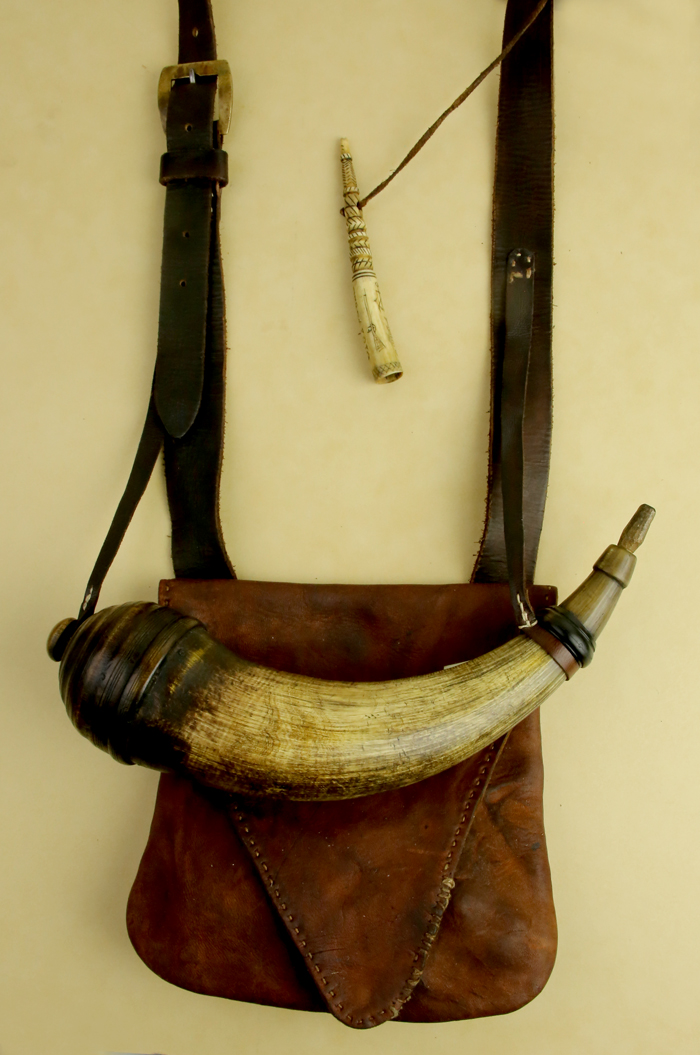
CLA 2019 Auction: Bag and horn set by Brian Barker
Bag and horn set by Brian Barker
The annual CLF fundraising auction routinely offers the finest in contemporary frontier art, but Brian Barker’s striking contribution to this year’s auction has the looks of a centuries-old original.
Barker crafted the hunting bag from bark tanned deer hide, warmly aged and hand sewn with linen thread. The interior of the bag is lined with linen fabric, and appears to have been “repaired” with a swatch of pillow tick. The strap for the bag is made from heavy duty vegetable tanned cowhide, and is fully adjustable by means of an aged brass buckle.
The exceptional southern style horn which accompanies this piece is has an applied collar and a turned maple base plug, and the entire horn exhibits a richly aged patina. Although not a direct copy, the antler powder measure for this set is modeled after an original piece dating to 1810, and exhibits whimsical scrimshaw engravings of a flintlock rifle, anchor, and fish. Taken as a whole, Barker’s attractive bag and horn set exhibits the appealing character found in museum-quality replicas.
“The CLA,” says Barker, “has been a great organization for me to meet other artists that I probably would not have met otherwise. There have been many artists and collectors that have inspired and challenged me to become more skilled in my art.”
For more information on the work of Brian Barker, contact the artist directly at: squirehawk1774@hotmail.com (More photos may be available when CLF’s auction page is done.)
Larry Pletcher, editor
-
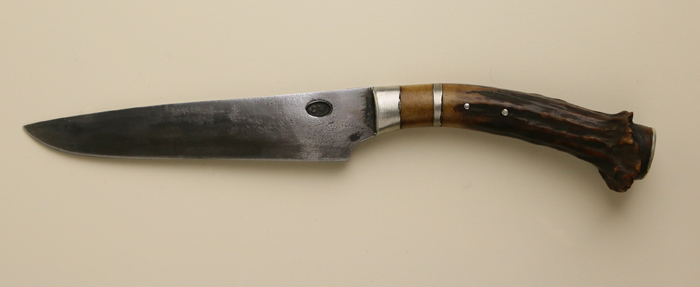
CLA 2019 Auction: Neck knife and quilled sheath by Charles Wallingford and Bill Wright
Neck knife and quilled sheath by Charles Wallingford and Bill Wright
Few pieces of tribal artistry are as visually captivating as the iconic neck knife of the eastern woodlands. For this year’s CLF fundraising auction, two of the nation’s top artists have teamed up to produce a truly outstanding example that’s destined to become a treasured heirloom.
Master cutler and CLA charter member Charles Wallingford hand-forged this knife from 1084 bar stock. Typical of the legendary Wallingford knives, the blade is razor sharp and sports a rich patina. The handle is crafted from dyed whitetail antler, beautifully accented with a hand-cast pewter bolster and an end cap of sterling silver.
Wallingford’s blade is accompanied by a stunning custom sheath by Bill Wright, one of the nation’s top quill and beadwork artisans. The body of the sheath is hand-crafted from brain-tanned deer hide, which was dyed using a period-correct walnut hull bath. Wright’s artistic talents are on full display on the face of the sheath, which is adorned with a breathtaking quillwork pattern inspired by the traditional tribal arts of the eastern woodlands.
To the artists, this fine donation is for a good cause. “The CLA,” explains Wright, “has been an excellent vehicle to promote the contemporary artists throughout our country who have demonstrated their love of our history. They have used various mediums to recreate the past relating to the 17th and 18th century and the CLA has brought forth these works of art and helped shine a light on those creations.”
For more information on the work of artists Charles Wallingford and Bill Wright, contact the artists directly:
Charles Wallingford: cwknives@aol.com
Bill Wright: wrightsgarden@hotmail.com
(More photos may be available when CLF’s auction page is done.)
Larry Pletcher, editor
-
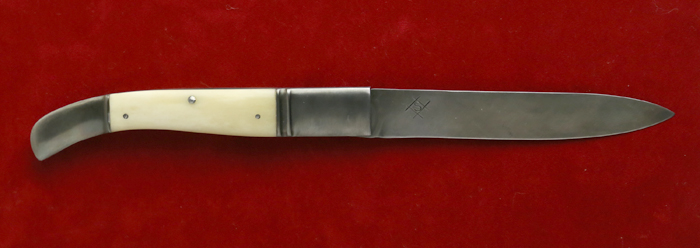
CLA 2019 Auction: Eighteenth Century folding knife by Scott Summerville
Eighteenth Century folding knife by Scott Summerville
In November of 1766, the English firm of Robert Cary & Company issued an invoice for miscellaneous goods to an up-and-coming Virginia planter who was largely tethered to the mother country for the manufactured goods necessary on his plantation. For various items including silk, nails, buttons, and cheese, George Washington was billed the respectable sum of £161. Included in the shipment was one item clearly intended for a gentleman of standing: 1 fine pocket knife, “London made”, for the price of ten shillings and sixpence.
Attendees of this year’s CLF fundraising auction will have the opportunity to own a fine folding knife, fit for a gentleman of any century, by noted bladesmith Scott Summerville. An accomplished knife maker who crafts a wide variety of cutlery, Summerville specializes in the precise art of colonial era folders. The artist maintains a collection of original 18th century originals, and, as he explains, uses them as study aids in replicating knives “that look like a brand-new knife did 200 or so years ago.”
Summerville’s offering in this year’s auction is based on an original knife in the collections of Colonial Williamsburg which he was able to photograph and measure a few years ago. The artist chose 1095 steel for this fine gentleman’s knife, and the blade is entirely hand-filed. The piece is fitted with bone scales, which were left untreated, Summerville explains, “to allow the bone to develop a natural patina.”
Summerville is an experienced artist with more than two decades of experience crafting knives. “I find the CLA humbling and inspiring,” he says. “The amount of talent that is always on display at the Lexington show completely awes me. And I am grateful for the opportunity it gives me and other artists to showcase our talents and help to encourage and preserve arts that might otherwise be lost.”
For more information on the work of Scott Summerville, contact the artist directly at: summerville1757@yahoo.com
(More photos may be available when CLF’s auction page is done.)
Larry Pletcher, editor
